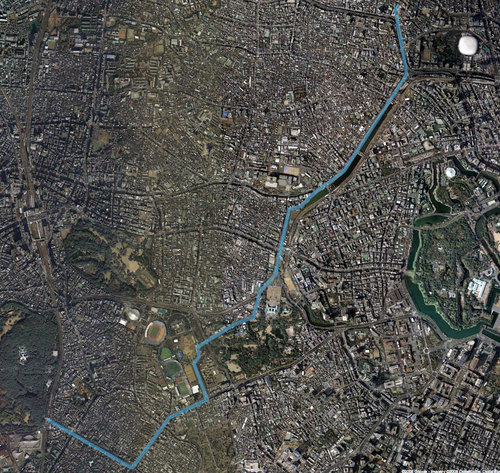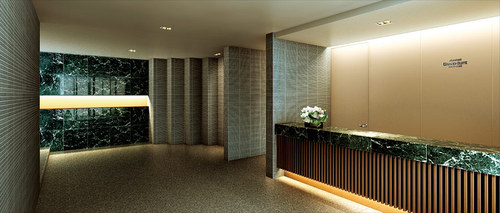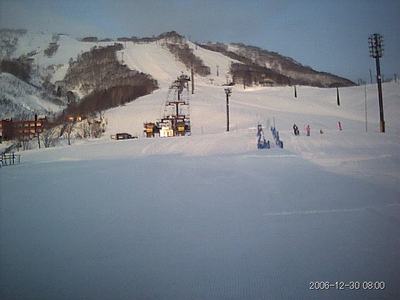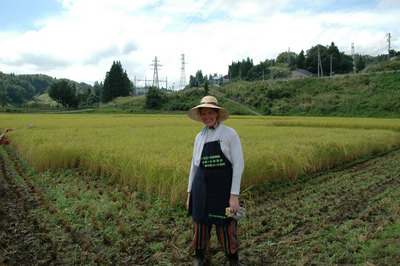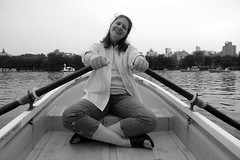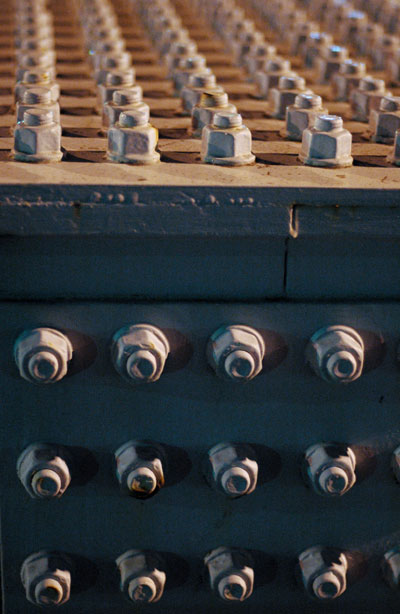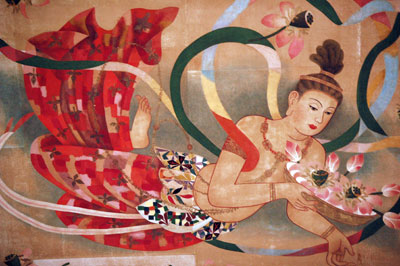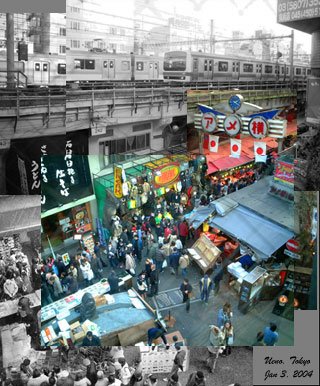Japan Places
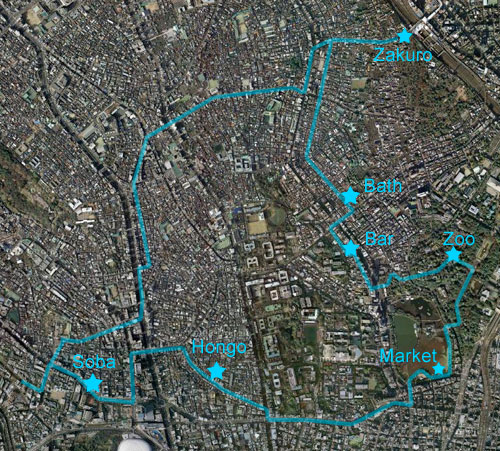
This was not a 10K run, but a day-long walk around town last weekend. It was probably even 11 km or a little more, but who is really counting?
We left the house to get lunch at a nice shop that sells hand-made soba. I was feeling a cold coming on, so I had the kake-soba - simple buckwheat noodles in a hot broth. It was just what I needed.
Then we walked through Hongo 4-chome, up a street we hadn't visited before, towards the zoo. Hongo has been part of Tokyo for a very long time and there are all sorts of historical markers and old walls and buildings to enjoy. The street we walked was part business, part residential in that lovely mix that older parts of Tokyo often have.
We wandered along the antiques market at Shinobazu Pond at Ueno. There are always lots of weird and tempting things there. Old coins, carvings, trinkets and toys of many kinds. I am not sure that we have ever bought anything, but it is great fun to browse.
At the zoo, Tod bought an annual pass, so now he can go visit the elephants any time he likes. We got to watch the elephants lying down to be brushed clean by their keepers before walking trunk-to-tail into their house for the evening. We love the elephants.
When the zoo closed at 5, we headed off, but we weren't sure exactly where we wanted to go. So we meandered the back streets until we saw a jazz bar called La Cuji. We stopped for a Guinness (only to help the cold, honestly) and ended up staying for more than an hour, enjoying some of the owner's 2500 jazz records and talking to Crazy Terry, a jazz lover sitting next to us at the bar. I asked the owner if he had Errol Garner's Concert by the Sea, one of my Dad's favorites. I hated it as a kid and hadn't heard it in a long time. I like it better as an adult, but I understood why I didn't like it when I was young. Anyway, I sat there thinking about Dad and the music until I cried.
After La Cuji, we traipsed tipsily toward dinner, but found ourselves outside Asahi no Yu, a beautiful old public sento. So we had a bath - an extremely hot bath - to ward off the incipient illness we both dreaded. My lungs were happily warmed and Tod chatted with the attendant on duty who told us all about the ghost stories associated with the bath. Spooky Halloween stuff.
We arrived at our dinner destination just in time for the dance show. Zakuro is a Persian restaurant with no tables or chairs, just carpets everywhere and some boards on the floor. The Uzbekistani dance performance was highly entertaining, with everyone dragged in by the maitre'd to dance in the middle of the room. After the dancing, we were brought a stunning array of vegetarian dishes. It was more than we could eat, though we did our best. I had forgotten the delights of Zakuro; we will have to go back soon.
Eventually we rolled ourselves away from the feast and walked the final leg of the day, passing by two of our old houses and many happy memories of places we used to live. It was a very good 10K (plus a bit), but we did end up spending the next two days sick and sleeping. The soba, Guinness, and bathing didn't do the trick.
On Halloween, Jim & I went for a spooky walk around Taito-ku to visit some of the grim old landmarks he has been researching lately. He took me to see Jokanji, the Throw-Away Temple that he wrote an essay about earlier this week. It has a beautiful cemetery full of memorials and markers that note a sordid past. We paid our respects to the 25,000 prostitutes whose bodies were left anonymously at the temple over the years.
They had been carried there across the rice paddies from Yoshiwara, the "licensed pleasure quarters" where so many young women lived out their lives in debt. A few became classy courtesans with rich patrons who looked after them, but most did not. Many died in natural disasters when earthquakes toppled shoddy buildings and fire ravaged the walled precinct. Others died of natural and unnatural causes, but with no families to claim them, were dumped at the temple.
I wanted to see how the old pleasure quarter looks in modern day Tokyo, so we wound our way over there - not through rice paddies, but via the city's busy roads and sidewalks.
I was surprised to discover that the area is still a pleasure quarter. It is no longer walled and the licensing rules have changed, no doubt, but the boundaries haven't budged. There is the same square grid of streets, 400 meters on a side, exactly as it has been for hundreds of years. A winding road still leads into the district from the main road.
Most of the streets within Yoshiwara (which isn't officially called that anymore) are lined with brothels. The buildings look like love hotels: garish exteriors in the shape of castles or fantasy villas, facades of old buildings, or glittering casino lights. The difference from love hotels is in the staffing and pricing. At a love hotel, you and your partner might choose a short "rest" for 5,000 yen, or an overnight "stay." The Yoshiwara rooms ranged from 7,000 yen to 35,000 yen and include a companion for the duration of your 100 minute visit. At most entrances a man in a suit stands watching the passersby. As we walked by one brothel, the doorman/bouncer greeted a returning customer and ushered him inside. Where the doors were open, I saw head and shoulder photographs of the girls on display.
And in the hours between 3 and 4 pm, the girls themselves could be glimpsed coming into work. Some were simply dashing down from the dormitories nearby. One group of three girls wearing velour mini dressed chatted as they passed in the alley. Another woman arrived on foot, but was preceded by a burly, dark-suited bodyguard carrying her designer purse and a shopping bag. At a tight corner, we gave way to a taxi carrying a beautiful young woman with a long lovely legs (Jim's observation) and a look of bored scorn (what I noticed). There were several women chauffeured in white SUVs. I imagine these girls are the equivalent of the classy courtesans of years past.
We walked out of Yoshiwara the back way towards the local shrine (which is not Jokanji), stopping first to take in the monument to an old pond and the people who sought refuge there after the 1855 earthquake. At Yoshiwara jinja, we discovered an extraordinary poster of local history, with four maps comparing the district during different eras, plus statistics, photographs, drawings and so much information it was impossible to take it all in.
After studying the poster for a quarter hour or more, we wandered out to the street to decide where to go next. We didn't need to go anywhere because history seemed to come to us. Jim has a Hiroshige woodblock titled Yoshiwara (from one of his many "53 Tokaido stations" series) stored in his iPod and comparing it to the street we were standing on - could it be the same place? The curve in the road certainly looks right. We were excited. But I wonder now...was this Yoshiwara a station on the Tokaido road between Tokyo and Kyoto? If so, lucky travelers (I guess).
Yoyogi Park on the weekend is a gathering place for lots of people who practice and play everything from instruments to frisbees. Jugglers, dancers and now hoopers group together and enjoy the fine weather while doing their thing. The park also attracts photographers who capture all of this activity.
We hoopers get a fair amount of attention from the photographers. We have been the background of photoshoots, are often snapped with cell phones, and sometimes we become the subject of what seems like hours-long scrutiny by middle aged men with big lenses. More often than not, the photographers do not ask permission or talk to us. I'm sure much of the time we don't even notice them.
But yesterday a lovely woman with a camera asked if she could take my photo before she started shooting. Sure, of course! I just kept on hooping. When she was done, she introduced herself and asked for my e-mail address to send me the photos. What a treat! Look at what she sent:
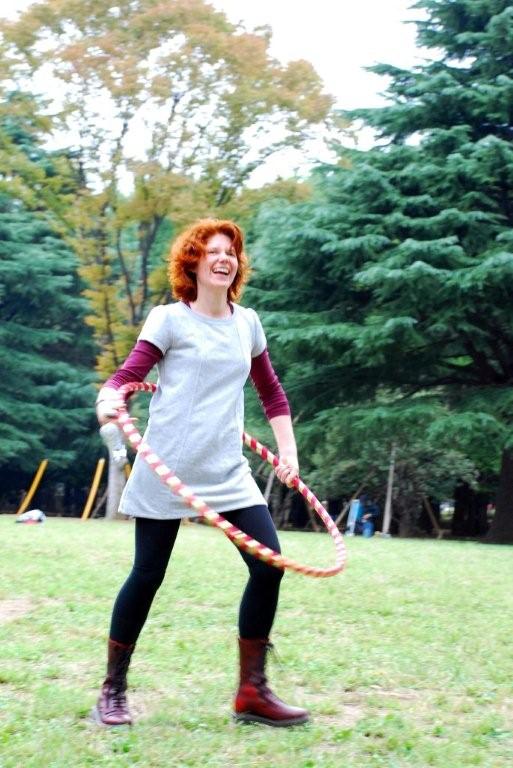
There are more, including some fun action shots, in my Flickr hooping set. Thank you so much, Luliko Nakagawa, for sharing your photos with me.
After a very busy week at work, we took a getaway weekend to Kotohira in Shikoku to celebrate our anniversary a little bit late. It was a total joy to be out of Tokyo and in beautiful, rural Japan.
This was our second time to pay our respects at Kompira-gu. We last visited in August 1999, well before we could converse with people. Being able to chat made the trip much more enjoyable.
Hooping at Kompira Temple
I took my hula hoop with me (of course) and hooped at the temple at the top of the mountain (1368 steps up!) The hoop initiated a lot of conversations, especially with elderly shopkeepers who all wanted a demonstration and with younger citizens and pilgrims who all had a try. The hoop spreads its love anytime it comes out to play.
After coming back down the mountain, we went to Nakano Udon Gakko to learn to make my favorite thick, chewy, wheat noodles. We learned two clever techniques and documented them.
Kneading Udon Dough
Rolling and Cutting Udon
We stayed at a lovely hotel with nice baths (to soak our aching legs after all those stairs), an evening enka show/bingo game, and a chef who had no trouble accommodating my vegetarian diet. For two days we feasted on seasonal vegetables in every form imaginable: tempura, salads, pickles, soup, grilled, fried, and simmered. He even made vegetable sushi for us. Vegetarians traveling in Shikoku, I recommend booking a room at Kotosankaku. I am sure it is equally great for omnivores. :-)
If you want to see a very long, unedited view from our train crossing over the Seto Inland see, I made a video of the Seto Ohashi Crossing.
After a four hour class with Deanne from Hooplovers, Tracey, Amanda and I had built up enough energy to hoop some more. We headed to the square in Kabukicho, where the homeless men hang out, and hooped there for an hour before finally heading off to dinner.
I don't think people hoop there too often, so we attracted a lot of attention. It was fun to have an audience and many photos were taken. Even better was an audience who interacted with us. One professorial but slightly crazy guy spoke at me about America for at least ten minutes; it was good listening practice. Two cute Chinese girls came over to play and take pictures. One of the homeless guys wanted to try the hoop, but was more interested in getting us to perform for him. An entire family joined in and played wit the hoops. It was a good time for everyone.
We shot the video intending to study our form as we practiced, but it was just too good not to edit a bit and share.
MJ arranged an outing to Enoshima for Tracey's parents to meet Elliot Mason. We spent most of the day at the Aquarium, where Barbara took charge of the baby, Jim pushed the pram, Tracey figured out the show schedules, MJ shot still photos and I took a bit of video.
The weather was terrific today, so I walked to Ueno with my sketch box and did a bit of drawing.
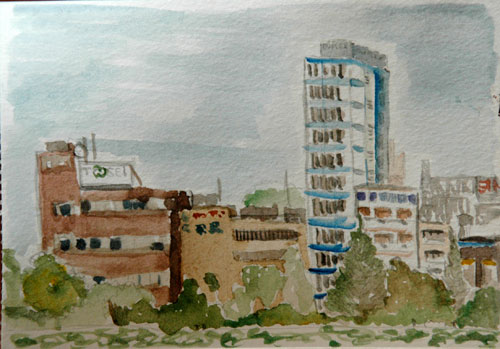
The Ueno skyline in pencil and watercolor
I am not a very good watercolorist and so I decided to take a photo to work from later. Maybe make some improvements to the piece later on at home....
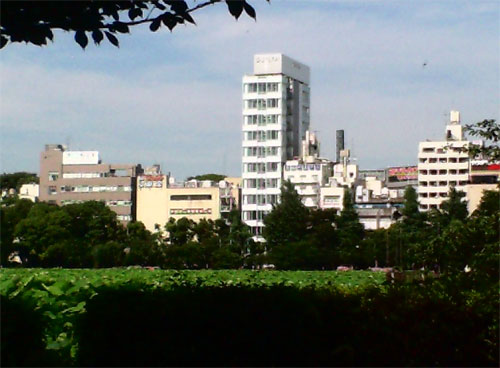
The skyline, photographed for reference
As it turns out, I did not too badly. My lines are not straight, but they never are. The perspective is off a bit, but overall, the painting is recognizable as that place.
But then I decided to play with the photo. I printed out a copy and used an oil pen to practice drawing the buildings in proper perspective and slightly straighter.
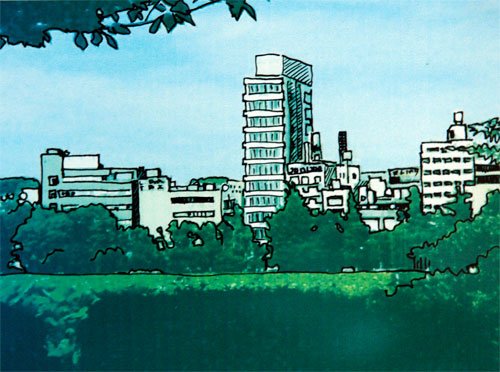
Drawing on photo
I like how the details and atmosphere of the three images differ, even though they are all the same place and time.
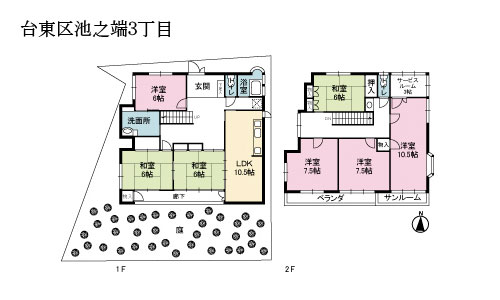
Way back during one of our many house hunting periods, we saw a lovely old Japanese house in Taito-ku near Ueno Zoo. It had tatami rooms over looking a garden, a cedar lined bath, a sun room, and a total of 7 bedrooms. It was big and drafty and I fell in love with it the moment I walked inside.
We were all set to rent it, but the owner's mother disagreed. She didn't like foreigners and didn't want her son to approve us. So we didn't get the place. It was very disappointing, but how can you argue against an old woman's prejudices? We kept looking.
Yesterday I discovered that it is on the market. All 7 bedrooms, the garden, the bath and everything for 15,680万円, or about 1.5 million US dollars. The house is around 160 sq meters (1725 sq/ft) on 172 square meters (0.04 acres) of land.
That's way over our budget, so I am destined to be disappointed once again. But seeing the floor plan flooded me with memories and for a few moments I daydreamed about living there. I could run a B&B. I could host an artist's colony. I could sit in the tatami rooms and gaze at my garden. Maybe someday, somewhere.
I am trying to make the most of the good weather between the rainy days in this early part of rainy season by getting out and walking. I know it will soon be more sodden and a lot hotter and I won't want to be moving around so much. So two of the last three days I have walked from home to Harajuku. It's about 90 minutes and just under 8 km.
The first 15 minutes from home to Iidabashi is a walk I make at least twice a week. It takes me though a formerly quaint neighborhood that has been ravaged by an 8 lane highway and a building project that ate an entire five blocks of housing. The building will be the tallest on in Bunkyo-ku and will block the view of Mt Fuji from the ward office. I am not a fan.
At Iidabashi, I walk along the Outer Moat down past Ichigaya Station to Yotsuya. If I walk on the canal side, with a view of the Chuo and Sobu lines across the canal, I am in Chiyoda-ku. If I walk on the building side of the street, I am in Shinjuku-ku. I prefer the tree-lined canal side as there aren't so many pedestrians so I can walk fast, and I like the shade. But sometimes it is too buggy over there and I walk on the building side of the street. I also have the option of crossing the canal and walking along a shady park path most of the way to Yotsuya. I usually don't do this unless I am with Tod.
At Yotsuya, I take the right fork towards the Akasaka Detached Palace. It is currently all covered in scaffolding and cloths, but usually the view of the palace through the black and gilt iron fence is quite regal. It's only a glimpse as I walk past and then I am on a green borderland. There is a stone wall and grassy embankment punctuated with guards posted at the palace gates, and various parks and planted buildings on the other side. The stretch of the road is a big dip so I get to walk downhill part of the way, then back uphill.
At the top of the hill, I am at the side of Jingu Gyoen. Although I'd like to be able to walk straight across the grassy park, I can't. I have to follow the road. The straightaway leading to Aoyama Itchome is lined with tall ginkgo trees. It's beautifully formal and upright.
It's quite a jolt to torn the corner onto Aoyama Dori. I'm back in the land of shopping and offices. From there, the route is new to me. The first day I walked it, I went straight down to Omotesando, then up to Harajuku. The route took me past all the insanely high-end shopping places and designer boutiques. The second time I walked this, I turned at Bell Commons and tried to thread my way through the back streets. But I didn't have a map, only a mental picture and I got lost! Not so lost that I missed my destination, but I was momentarily turned around and confused. Then I spied a streetside map and headed off in the right direction.
Yesterday I walked from home to Otemachi to meet Tod for lunch. I've done this many times and it is a lovely little stroll through diverse neighborhoods. Let me describe them to you.
The main street in Kasuga is Kasuga Dori, a busy four lane road. It was a pilgrim route to Kawagoe and it still leads there. Once I tried to walk there. Yesterday I turned my back on Kawagoe and headed down to Korakuen station and Tokyo Dome.
Within ten minutes of leaving my apartment, I reached a bright and cheery entertainment and shopping area. Tokyo Dome itself hosts baseball games and concerts. It is flanked by LaQua, a shopping mall with a hot spring, roller coaster, and Ferris wheel on its roof. On the other end of the Dome, Meets Port has an event hall and many restaurants. "Tokyo Dome City" is a man-made, marketed, commercial destination. I walked through it as quickly as I could.
At the end of Tokyo Dome City is the Suidobashi JR station and the more down-to-earth Jimbocho neighborhood. Jimbocho is famous for used books and sporting equipment. The buildings are a mix of low tenements and 20 year old highrises, but all of them have street front shops. It seems like about a third of them are bookstores, but there are all sorts of things to buy and great places to eat at reasonable prices, too. I like Jimbocho; it is a human-scaled place in a city that is sometimes overwhelmingly glittery or depressingly sterile.
But it doesn't take long to walk through Jimbocho and after skirting around some slow moving office ladies out for lunch, I turned east onto Kanda Keisatsu Dori. This strip is a broad street with bigger, taller buildings: a couple of schools, some minor corporate headquarters and the Kanda police station that names the street. Even though the buildings are blockier and larger than the ones in Jimbocho, the street feels sort of cozy. There are sculptures near several of the buildings and the cross streets are one-way. The street makes a good transition between Jimbocho and Otemachi.
Turning off Keisatsu Dori and crossing over the Kanda River (or is it the Nihombashi River at that point?) I reached Otemachi. This is where a lot of banking and business take place. Every building is a skyscraping office tower with a granite courtyard or a marble entranceway punctuated with a tree or two. It is modern and imposing and quite dull. I'm glad I don't work there anymore, but I am always happy to visit Tod for lunch.
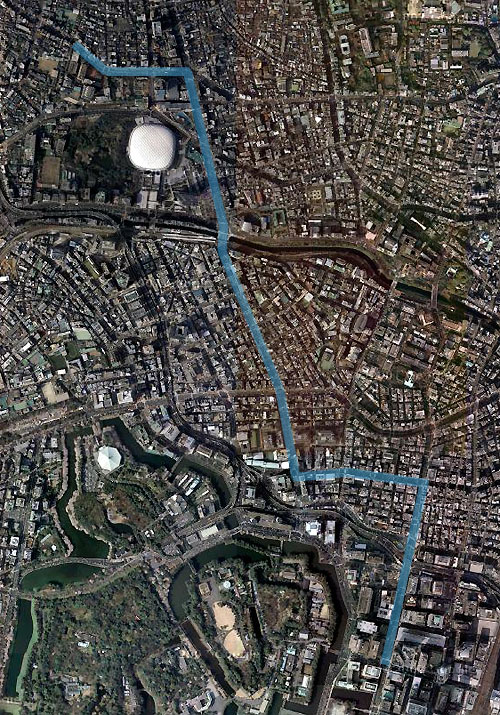
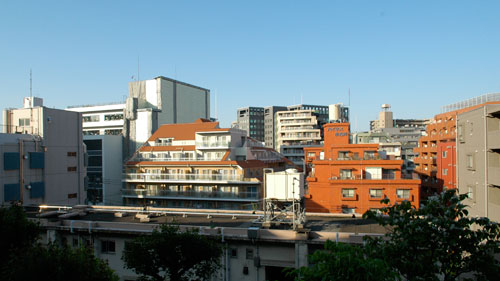
The city is so quiet this morning that I can hear wind through trees and chirping birds across the way. Everyone is still asleep. The highway is silent. The local roads are still. It even seems like the trains are rushing past less frequently.
Post-holiday exhaustion? People must be resting after their golden week blow out. I'm sure it won't be too long before everything and everyone starts moving again so I will go outside and savor these few last quiet minutes.
Tod says Niijima is a magical place and I think he is right. There were so many happy coincidences there this past week.
On the first day, Tod ran into some of his colleagues from UBS. They had sailed down from Tokyo and offered to take us sailing one day. Eight of us had a wonderful morning sail out into the ocean with Jason and Neil. They put us to work pulling lines and hoisting sheets, which was beyond fun.
On the last day, a convergence of stories brought two friends together. Our taxi driver had told Tod the day before about a guy who got off the boat mistakenly; he had no cash, his friend had the tent and all the gear and he had no idea what to do. The taxi driver gave him a room for the night. The next morning, a guy in our camp is talking to Tod about losing track of his friend on the boat. Voila! Two plus two = friends reunited.
And in between those connections we had an outing with the entire local elementary school, an arts and crafts day in my tent with drawing and jewelry-making during a rainstorm, we tried our hand at blowing glass, and experienced the usual Niijima combination of beautiful weather, great food, socialising with new friends around the camp, and friendly interactions with all the locals.
Going to Niijima is always a treat. Thanks to everyone who came along with us. Let's do it again soon.
I love making little weekend trips to places in Japan. Every town has its charms and I am rarely disappointed, even when we choose at random. I wish I would remember this more often and make an effort to explore more of the country.
This weekend, I whisked Tod away for a Valentine weekend of "athletics and adventure." We went to Shuzenji, a 1200 year old onsen town in the middle of Izu. On the outskirts of the city is the Cycle Sports Center, a weird pedal-powered amusement park that also has several real biking courses. Tod had a great time; I fell off my bicycle on the 5K course. The wheeled things have it in for me. I bruised my knee and my ego, but no permanent harm was done.
I had a great time in the giant maze, though, and loved the "Interesting Bicycles" course where we tried out hand-pedaled bikes, an old fashioned big-wheel-in-front cycle, a sideways bicycle for two and a bunch of other novelties. The pedaled roller coasters and other rides were a kick, too.
We stayed at an Indonesian themed hotel called Yutorian. In addition to a lovely (but very chilly) rotenburo and the usual indoor bath, it has a mixed sex bath that is built in a natural cave. The story of the cave is an interesting one. One day in the late 80s, the owner of the hotel picked up a drill and started digging. After two years of daily drilling wit his family scoffing at him for being nuts, he broke through into the cave. He didn't know he would. I wonder what possessed him to start drilling the mountain outside his hotel?
After a dinner that featured too many scallops for my liking, Tod & I went out to look at the stars. With the advice of the hotel staff we had scoped out a really dark spot in the middle of a field near the elementary school. I wanted to give my Christmas toy, the Celestron SkyScout, its first real outing. It was freezing cold and the half moon was so bright it cast shadows, but we had a good time pointing the SkyScout at things and asking it to tell us what they were. Until my fingers were too numb to work the buttons, we also located the various planets (most of which were on the other side of the earth) and stars whose names we remembered.
Today we explored the onsen town, climbing the mountain to the ume forest-park at the top and enjoying a plum blossom festival, then descending to visit Shuzenji temple where I made my hatsumode (a little later than usual) and got a daikichi (big luck) fortune that tells me I will get ahead in the world. We stuck our feet in the legendary Dokko no Yu, climbed the tourist association's little tower, and just enjoyed wandering the village and seeing the sights.
At a shop near the train station, I scored a new teapot to replace the one we broke last year. The shopkeepers were wonderfully careful - unwrapping the brand-new pot and ringing the ceramic to make sure it was intact, then heating the rubber pour spout in hot water and adjusting the fit before running around to find a box for it. While we waited and watched the ceremony of the teapot preparations, I noticed that the couple's painted portrait hung above the door to the stockroom. Perhaps an anniversary gift... it was sweet.
All in all, we enjoyed a great weekend break from the big city.
This morning, I had the pleasure of commuting in one of the Women Only cars that run on the Chiyoda line before 9:30 am. What a contrast to the train I'd transfered from. On the Women Only car this morning:
- Nobody was sneezing or sniffling and I heard only one muffled cough.
- Everyone in the car was awake and alert.
- The women who were speaking (quietly) near me were talking about kittens.
- No one had their newspaper or book spreading into another rider's limited space.
I think I like the Women Only car.
Got back last night from a five-day camping vacation - our (nearly) annual journey to Sado, Niigata for the Kodo Earth Celebration. I brought my sketching things and while we were there, I worked on a little art swap with the theme of self-perception. The three sketches I completed are also camping-related.
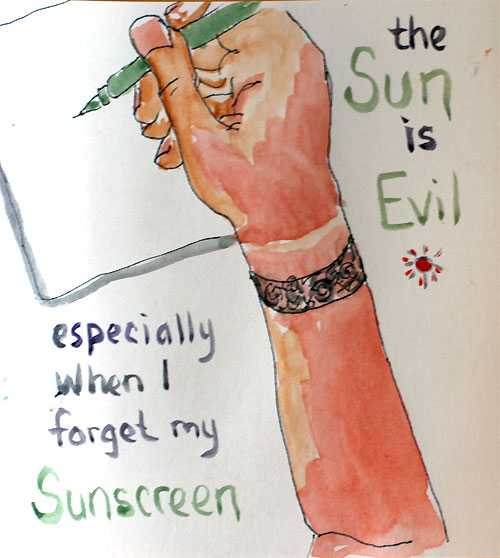
Self-perception: easily burned
We drove overnight to Sado and arrived in the early morning. I forgot to slather on sunscreen before we made camp at 10 am, and ended up with an annoying sunburn. I especially despise the little white ring where my hair band was wrapped around my wrist.
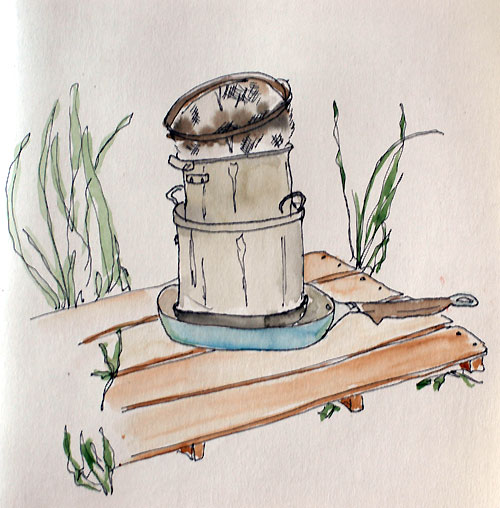
Self-perception: provider of tasty food
Our camp kitchen was excellent again this year. We cooked breakfast and lunch for as many as 11 people over the weekend. Luke brought curry for the first day and later in the trip we had lentil soup, banana pancakes, and a full English breakfast. My favorite meal was the grilled saba with vegetables that Tod & I made for lunch on Sunday. A number of us are vegetarian/veg-aquarian, so our meals were quite vegetable-laden and healthy.
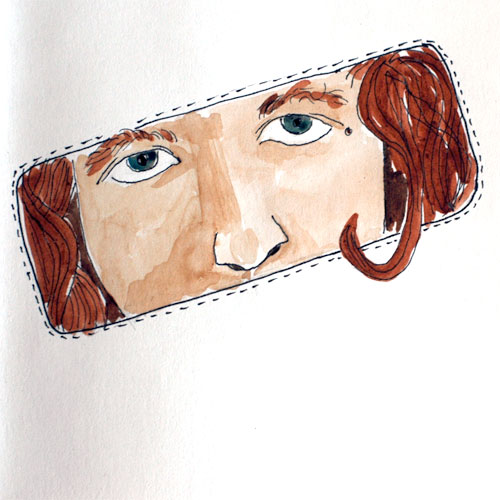
Self-perception: lopsided
I hadn't drawn a self-portrait in a while, so as I waited for the coffee water to boil one morning before anyone else got up, I grabbed my little mirror and did a quick sketch. Maybe I'm not quite a lopsided as this drawing indicates, but I am not entirely symmetrical in real life. I also look tired, which I was.
Camp was fun; the music festival was great, and we are all looking forward to next year's camping extravaganza.
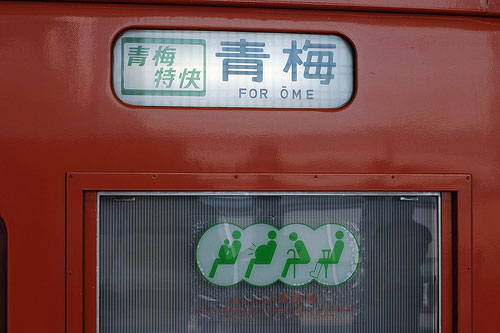
Using the invented rules I described in the previous post, we ended up a Chuo Express bound for 青梅
(Ome) leaving from track 9 at 13:51. Looking at the route map, we saw we'd be getting off at Tachikawa and transferring to the Nambu line. When we got on the Nambu line train, we scanned the route map for stations with 'koen" but there were none, so looked again for a station with a "water feature" in its name. Second stop: 矢川 (Yagawa). That was our destination.
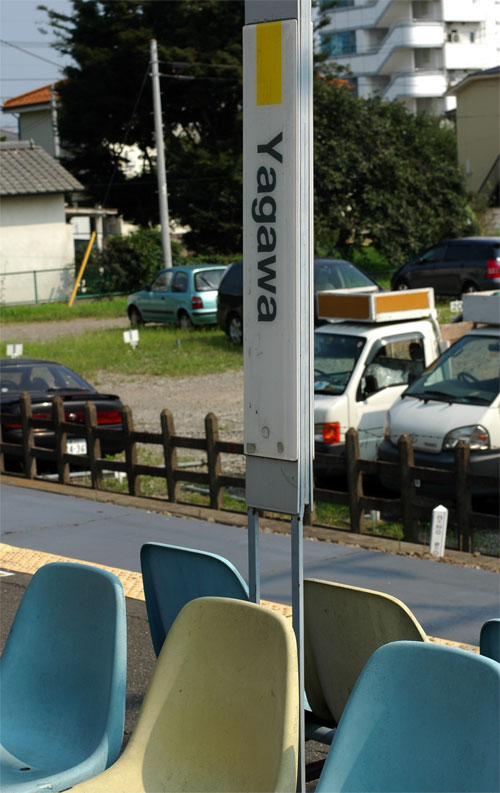
Yagawa is a suburb of a suburb of Tokyo. Like most places in Japan, though, it has its points of interest. We left the station and headed for our water feature, the Ya River, with a plan to stop at the Kunitachi Kyodo Bunka-kan and a forest park that were marked on the map at the station.
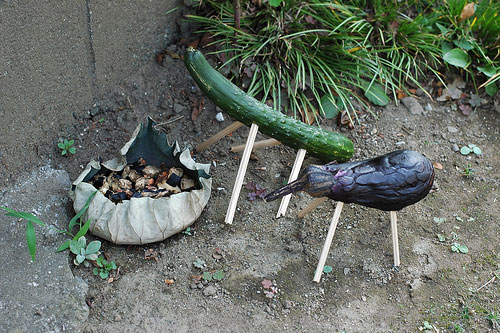
Within ten minutes we'd stepped into the country side. Fields and farmhouses lined the narrow roads. At some of the houses, we saw "veganimals" made from cucumbers, eggplants and chopsticks. I think they were part of a summer o-bon offering, but I don't know for certain.
The local museum was beautifully designed and full of local archaeological treasures and a history of the Kunitachi area. We had a great time in the library, leafing through books on flora, fauna and urban sightseeing. Libraries are always extremely entertaining.
Our next point of interest was the forest walk, which was refreshingly shady in the scorching afternoon heat. But we were soon through it an finally had our first sighting of the mighty Yagawa:
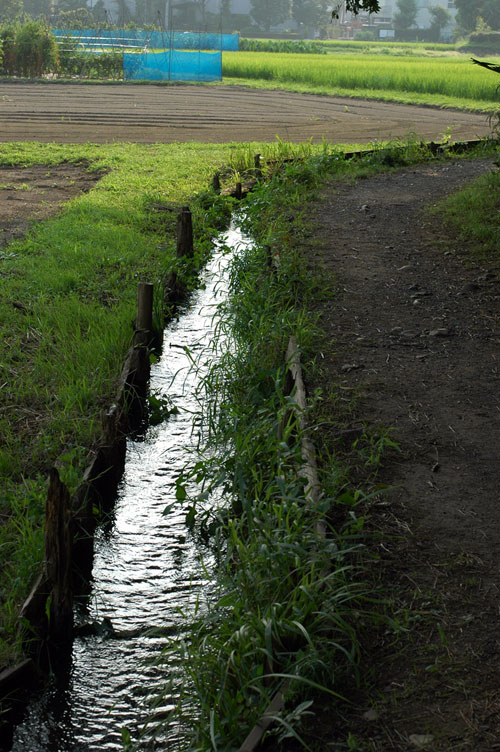
It wasn't much of a river, or even a creek. It was a stream. But I guess 川 can mean stream as well as river, so it wasn't a trick to fool visitors. We got a little lost on the way to the next station, but a helpful man set us straight and suggested we pay our respects at the Yaho Tenmangu shrine.
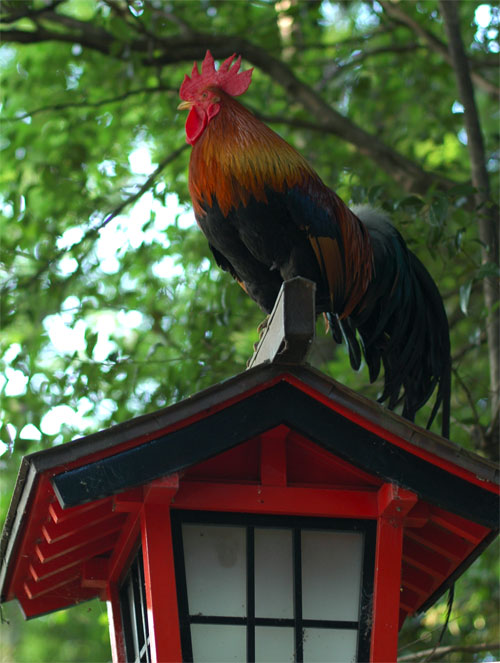
A flock of chickens greeted us very loudly as we approached the stairs. People came by to feed them while we took photos. They were perhaps my favorite part of the day - completely unexpected and so incongruous.
We walked from Yaho station up the perfectly straight Daigaku Dori to Kunitachi station, and along the way bought a steamer pot, popped into a tobacconist to inhale deeply, found fresh beets on sale, ate at an amazing restaurant (I'll tell you all about it tomorrow) and decided that Kunitachi, a college town established in the Taisho era, was a place we'd visit again.
But we'd never have come here if we hadn't traveled following our random rules.
Tod took a lot of photos.
Next time you wake up with the "I want to go somewhere today" feeling but don't have a specific place in mind, try this: make up some arbitrary rules(*) and go where they lead you. For example.
Start at the nearest major train station: Tokyo, Shinjuku, or Ikebukuro are ideal. Seed your trip by choosing some (but not all) of the following factors:
Fare (max/min)
Time to travel (max/min)
Terminal name on the train (specify a kana/kanji/letter that must be in it, or a number of kana/kanji/letters)
Destination station name
Track number (or range of numbers)
Train type (i.e. local, express)
Number of stations to travel
Number of transfers to make
Direction
Departure time
Train line/livery color
All the information must be knowable either when you start (i.e. maximum fare will be 800 yen) or as you travel (get off at the first station that starts with "ka"). You couldn't say, for example, "We'll get off the train at a station with a tudor facade," because you won't be able to see the facade until you get off the train.
We went out today starting at Tokyo station with the following conditions:
- Terminal name has be two kanji
- Track number is odd
- Express train
- Departure must be "next available"
- One transfer taken at the second possible transfer outside of the Yamanote Line
- Transfer direction must be towards the longer leg of the second line
- Destination station will be:
- station with koen (park) in the name or
- station with a water feature in the name (river, lake, beach, etc) or
- the seventh stop from the transfer station
- Travel time no more than 100 minutes
That might sound a little confusing, and there are definitely combinations of rules that work better together than others. But this worked for us today; we ended up somewhere interesting that we'd never have selected on purpose.
I'll tell you all about it tomorrow.
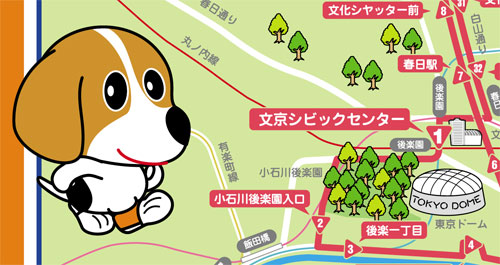
In April, Bunkyo-ku launched a community bus service that circuits the ward's public offices and major parks. It's a convenience for people who need to get across town to the tax office or are back-and-forthing between city hall and hospitals or taking their kids to the park. The bus runs every 20 minutes between 7 am and 8 pm and a full circuit of the ku takes 65 minutes.
I am delighted that this is how my tax money is being put to use. Not because I ride the bus, I haven't yet, but because I love the name of the service. The B in B-ぐる stands for Bunkyo and くる is the verb "to come" so that makes nice sense. The part that makes me grin is that B−ぐる is pronounced like beagle and the mascot is a a beagle wearing orange pants.
From August through October, B−ぐる is teaming up with local cafes to offer discounts if you show them your one day ticket. The campaign page has all the details and even tells you what stop is closest. And in another campaign, if you save up 12 one-day tickets, you can redeem them for a B−ぐる shopping bag or commuter pass holder.
Bunkyo-ku rocks. And rolls, too.
Although the Japanese idea of vegetarian food includes fish, there are some vegan and vegetarian friendly restaurants in Tokyo. Tod & I have been checking them out, one by one, and I'm posting my reviews so that I'll remember which is which.
Eat More Greens, Azabu Juban (Azabu Juban 2-2-5)
This may be the elusive vegetarian-restaurant-that-serves-actual-vegetables and it has outdoor dining, too! At lunchtime, the menu offers several specials including a bread, soup and salad set, and a filling rice and grains plate that is served in a huge bowl of salad. The menu notes which items contain wheat, soy and peanuts for the allergic among us. The dinner menu is more extensive with more than half vegan dishes. The desserts in the case by the register were tempting. Next time!
Nataraj, Ginza (Ginza 6-9-4)
This is the only pure vegetarian Indian restaurant in Tokyo. They note the dishes that have milk in them, offer a choice of brown rice or turmeric rice, and offer several macrobiotic choices, too. The spinach and lentil curry topped with fresh ginger was especially delicious. Tod's Nataraj curry of gluten meat and creamy red sauce was not as spicy as I expected it to be, but a treat nonetheless. At lunchtime they have a 1,000 yen buffet. There are branches in Minami Aoyama and Ogikubo, but the Ginza one is convenient for us.
Vegan Healing Cafe Shibuya (Udagawacho 6-20)
In a small storefront in the surprisingly quiet fringes of Shibuya, Vegan Healing Cafe serves up the usual beige vegan food - brown rice, bean stew, tempe sausages and falafel - a little over salted for my taste, but certainly not bad. They have excellent desserts, including a chocolate tart that would give any cream-based one a run for its money. In the review I first read of this place, the writer said "I knew I was getting close when I saw the PETA truck." Sure enough, as we were leaving after lunch, the PETA folks were coming in.
Fangsong Cafe, Akasaka (Akasaka 6-10-39)
This is Jim's favorite lunch spot, I think. They have low seating, an interesting variety of music, a dog hiding under a table and lots of lifestyle information. The lunch menu is limited to two options - a macrobiotic curry set or a vegetable plate with a variety of tidbits and delicious purple rice. Both are good and around 1100 yen. I particularly like the tempura battered soy meat on the vegetable plate.
Mother's, Jimbocho (Kanda Jimbocho 1-15-2)
Although Mother's bills itself as an organic foods restaurant, there is not a speck of meat to be seen on the buffet, though perhaps there is fish in the stock. I couldn't tell and didn't bother to ask. The all-you-can-eat buffet is 1260 yen and there are take-away options at a lower price. At Sunday lunch, they refreshed the table frequently with new items. Vegetable curry rice was my favorite, followed by a mix of fried root vegetables. All you can drink houjicha and coffee is a treat, too. Downstairs from the restaurant is an organic grocery store with a range of bento lunches, produce and the usual mix of crazy health foods and cosmetics.
Tod & I ventured out to Kawagoe today. Aside from my aborted attempt to walk there in 2004, I haven't been to Kawagoe since a day trip there in 1996 - the first time we came to Japan. It hasn't changed all that much but we have! Today we visited the usual tourist hotspots, but for us the real highlight turned out to be food.
Shortly after beginning our walk, we realised we were hungry. On the next utility pole, Tod spotted an ad for a soba shop called Kamakura directing us to "turn right at the next light." So we did and followed the signs another ten minutes. It was worth it. The homemade soba with was delicious.
But it was a meal short on vegetables, so when we spotted the "cucumber on a stick" stall at Kitain Temple, we stopped to share one. So simple. Very refreshing. Gave me enough energy to visit the 500 Rakan statues in the garden.
We'd walked about 200 meters out of the temple when we found a little restaurant serving organic, healthy foods. Not exactly vegetarian, but on the right track, so we got some 15-grain onigiri to take away and while we waited discovered homemade dried yuba (tofu skins) that can be used as a meat substitute. The nice lady running the place explained how to cook with it (soak it, squeeze it, dress it with shoyu, (and/or mayo) and dredge it in flour.) I love yuba nd friendly people, so we bought some.
There's a pickle shop in Kawagoe that we visited in 1996. This time, armed with nine years' more eating experience, we realised just how good it was! And we know the name is Kawamuraya. We sampled happily and bought some whole onions pickled in red wine.
Next stop: "candy alley" where there are dozens of shops selling old-fashioned sweets and crackers. We picked up some treats, including Tod's #1 irresistible food item, fancy imported salt. We had another cucumber-on-a-stick, too. This one was slightly salt pickled. It was even better than the first one.
As we wandered along Kurazukuri street, Tod spotted a shop specialising in beans. Wow, did they have lots of beans! Not only dried, raw beans, but many differently flavored prepared beans - fried wasabi beans, chickpeas soaked in sweet sauce and dusted with cocoa, freeze-dried red beans, semi-dried black beans. We tried them all and we walked away from Mame-ya with seven different kinds for home and a handful of recipes, too.
I thought we were done with food as we walked the final leg to the station. I mean, hey, we're on a diet, we're vegetarian, and what is there for us to eat? I should know better. We walked past an olive oil and wine shop. We backed up and entered the olive oil and wine shop (Tasty Globe), enjoyed a degustation and conversation with the owner, then left with two bottles of oil and two of wine!
Now we are home and I'm making dinner. I'd better get back to it - it's time to squeeze the yuba.
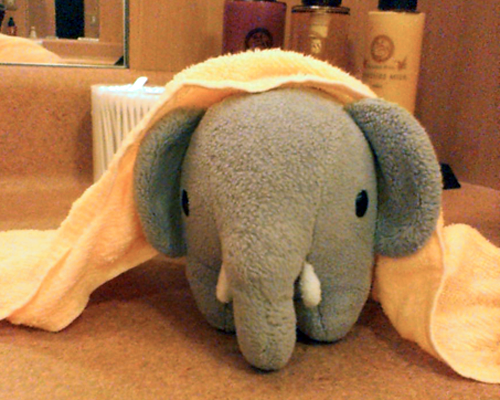
Zoupi towels off after the onsen
Yesterday, I found myself at Oedo Onsen Monogatari, a hot-springs bathing theme park at Odaiba. It opened 4 years ago and I'd never heard of it. Camilla and Liz, visiting friends, told me about it and we went together for a five hour bathing extravaganza.
We did the full round of baths twice, had a sand bath, sat and enjoyed the outdoor foot pond, wandered around the Edo-themed complex and tried the doctor fish. As great as the baths and the retro decor were, the fish were the highlight of the day.
Doctor fish nibble the dead skin off your body - in this case our feet - leaving them smooth and fresh. It feels very strange to have a horde of fish surrounding your feet and sucking on them, but it works. Once you get over the giggles (it tickles), it settles into a tingling sensation as the fish have their dinner.
In Turkey, where these hot-water dwellers come from, they are used for treating psoriasis. Here in Japan they are more cosmetic than medical. Why do they dine on your skin? The fish are starved so that they'll go for your crusty bits. Maybe it's cruel, but I appreciate the effect. I can still see the pale pink demarcation just above my ankles where the dozens stopped dining. I sort of wished they'd worked on the rest of me, too.
Oedo Onsen Monogatari does not allow persons with tattoos, but they didn't notice mine and I spotted another foreign woman with a tattoo. They didn't seem to have a problem with Zoupi or his friend Moe, either. Maybe they were feeling lenient on a weekday afternoon without too many customers. In any case, tattoo'd folks attend at your own risk.
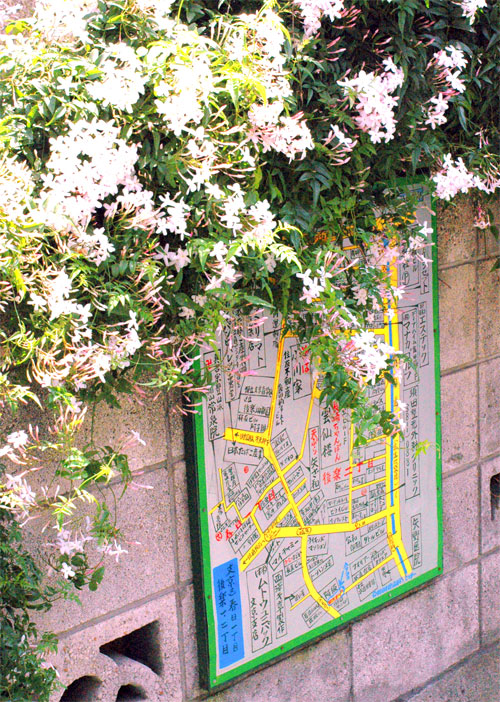
Jasmine blooming along a Shinjuku-ku street
It's a another beautiful day. Our Golden Week weather has been stunning this year and we've enjoyed so many pleasant, sunny days that I wish the summer heat and humidity would never come. It's just around the corner, but I will relish every one of these perfect days until the dog days set in.
Our day is a luxury of idleness. This afternoon's agenda: consume a bottle of sparkling wine. Tonight we'll grill a chicken and vegetables. We've been out for a walk, enjoyed lunch at St. Martin (they were out of chicken roti so I finally tried another dish from their menu), wandered around Kagurazaka a bit. I love the holidays.
In looking for potential new abodes, I have considered buying an apartment in a yet-to-be constructed building. Places like this put out advance notification, set up model rooms to show off their plans and generally give prospects the idea that their new building is going to be a great place to live.
A few months ago, I saw the advance notice for a building in Rokubancho, near Yotsuya and Ichigaya stations. It fit the requirements I was looking for so I put my name on the mailing list and waited for the model room to open. Yesterday we paid a visit to the Marubeni Grand Suite Rokubancho showroom.
We sat down with an agent, Sakata-san, and told him our budget and wishes. He pulled out the building plans and showed us an apartment that was not quite 50% more than the price we're willing to pay. The apartment he wanted us to consider would cost 1.25 million dollars. Too expensive but we toured the model room anyway, getting a feel for what that level of luxury would include.
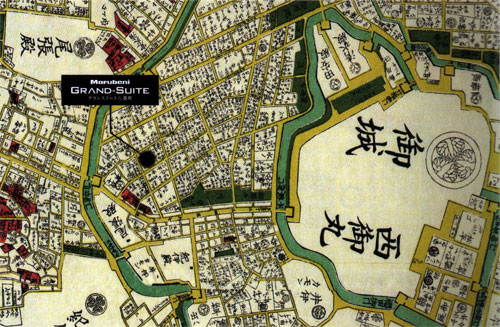
A new building on an old map
First of all, it pays for the address. This is a prestigious neighborhood a stone's throw from the Palace and within the outer moat. Next door to the new building is an elementary school the Imperial family has used. There is history all around. These are things, Sakata-san assured us, that Japanese people will pay more for. OK but what about the building itself?
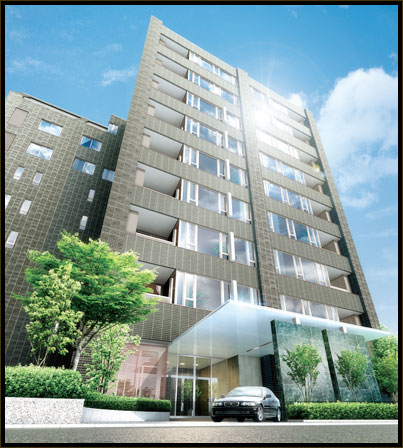
Concept drawing of the exterior
It is nine stories with views towards the moat (all taken) roof balconies (all taken) and southern exposures (all taken). There is triple security into the building beginning with a key that recognises its lock and automatically parts the outer sliding doors. And of course, the building construction is earthquake resistant.
The public spaces are decorated in rich woods and marble. In addition to a lounge area, there is a concierge desk where you can arrange package deliveries, tickets and even have lightbulbs and batteries sent up to your apartment. I don't think I'd want to live in a place where people where too lazy to walk to the conbini for batteries.
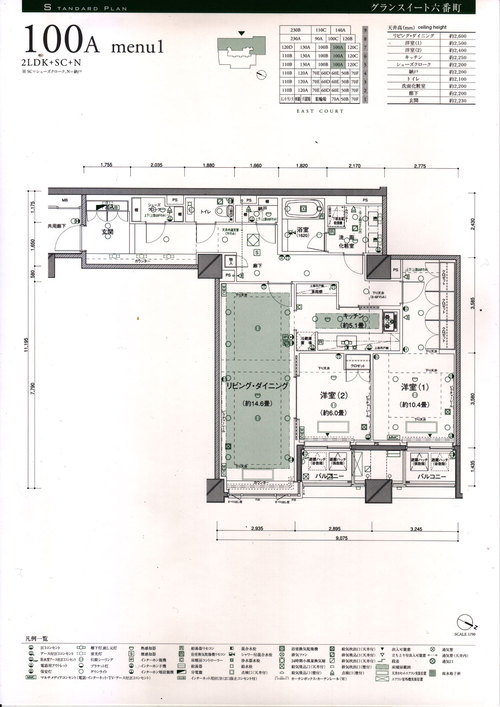
Layout 100A. Click for larger view.
This is the room layout that was suggested to us. It's about 100 sq meters (1076 sq ft) with two bedrooms, a coat closet and a storage room/pantry. It's a fair size, but the layout is awkward. Look at the toilet in relation to the bedroom: you'd have to walk through your closet to the hall and nearly to the genkan before you could pee. Imagine doing that if you're not feeling well. This is a middle apartment, so the windows are only on one side - east. Morning light only.

Detailed legend, translated. Click for larger version.
Check out the detail on the legend. It lists every outlet, light fixture, remote control. I've relabelled it all in English so you can see what level of detail you buy in a luxury apartment.
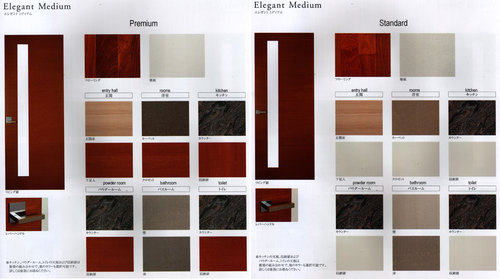
Premium and Standard versions of the medium brown colors
The apartments have many options and at a minimum level, you must choose among three color schemes (Brilliant Natural, Elegant Medium and Vintage Brown) in Standard and Premium levels. Premium has more wood; Standard uses shiny white finishes. The Premium carpets and wallpapers are a lot nicer and door handles have face plates.
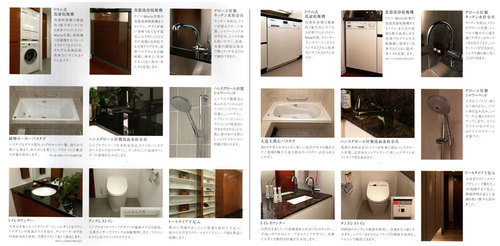
Included equipment and fixtures (Premium and Standard). Click for larger version.
The fixtures differ between the Premium and Standard apartments, too. Premium apartments have beautiful faucet handles, a larger dishwasher, separate washer/dryer, and more holes in the shower head. And note that in the photos, the Standard options have a single stem of greenery, where the Premium photos show big, bushy plants. Subtle but effective upselling.
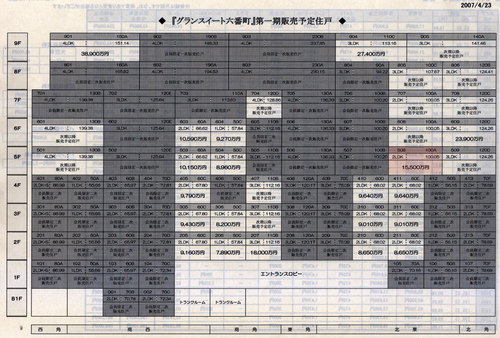
The price list mapped onto the building. Click for larger view.
And in the end, applying for an apartment doesn't guarantee you'll get one. After the first sales period deadline next month, they will hold a lottery to see who will get to buy the units that were on offer. Then the slate is wiped clean and another sales period begins for the remaining units.
On the map above, the rooms marked with prices are available to the public now (the red one is what we were recommended). The ones without prices will be sold in the next round. The grey ones are reserved for "members" during the first and second sales periods.
This is definitely not where we will be living. But I'm glad we went and saw the model room. Now we have another data point to compare. I still think we need to buy land and build a house.
We went out looking at land and houses again last weekend. I'm growing disheartened. Everything is expensive and imperfect.
The best place we saw was 115 sq m for about $680,000. It included a house we'd have to tear down. It was accessed by a private alley (dirt!). To the south was a tall apartment building that shadowed the house for most of the day.
After returning home and slumping in defeat, I made a list of the bad points we keep seeing in all these properties. Tod & I each ranked them, then combined our scores for a final list.
Compromises To Be Accepted
- Far from station: we're not going to be able to live 5 minutes from the station; it will be more like 10-15.
- Small lot: we will do the best we can within our budget. If we have to sacrifice size to gain a point below, so be it.
- Far from friends: far is a relative term, but we might not be able to be stay within walking distance of anyone.
- Inconvenient train to work: this is most critical for Tod and means we want the Marunouchi, Chiyoda, Mita, Tozai or Hanzomon lines. Yamanote and Chuo/Sobu are also possibilities.
- Neighborhood with no amenities: If the grocery store is far away, or there's no cleaner nor a decent restaurant, then we will hate it there. I still remember feeling stranded in Himonya.
- Bad light and air: I cannot live happily in the shadow of other buildings. No sun is a no-go.
So now that we know a little better what we can tolerate and what we can't, we can continue to look for places. Maybe we search a bit further afield. There are cheaper blocks of land in Ikebukuro and Sugamo and other neighborhoods on the edge of the Yamanote line.
Or we just go buy a mansion. (That's an apartment in Japanese, not a palatial home.)
Our very kind realtor, Mr. Matsudate, and his kohai sidekick, Tobe-kun, picked us up this afternoon for a tour of some houses and a visit to their office to discuss future possibilities. Five hours later we rolled back home, having looked at four properties. Let me describe them to you a bit, so you can imagine what we're experiencing.
"2 Flat" was an older house on a quiet street in a high-class neighborhood. It looked like the poor relation of the adjoining houses. Each of the two stories was its own self-contained apartment. Not even in the running, except that the neighborhood is a good one.
"Mickey House," not far from an elevated highway, was obviously owned by someone with children and poor taste. The living room had a chandelier, the walls papered in English florals, the kitchen backsplash was tiled in embossed Mickey, Minnie and Donald profiles. I think we'll leave it for another happy family.
"The Nade" is an top-floor apartment just around the corner from our current place, so it is the perfect location. It has two big roof terraces, plenty of windows and a nice kitchen but too many built in cabinets in the other rooms that limit the way our furniture will fit. It feels cramped and I can't imagine living with the sofa in the exact same position for 20 years.
"Yakuza Poi" was the most interesting of the four. It has a stunning view towards Tokyo Tower and an interesting layout of 2 large bedrooms and a tatami room plus a pretty enormous LDK. Unfortunately, I think the place was a mob hangout because it has marble floors with brass trim, hotel lighting fixtures, and a urinal in the bathroom.
So we struck out today. But we'll go out again next week. There are three intriguing floor plans, including an apartment just a minute's walk from Hanzomon, a house near Yotsuya 3-chome and an apartment in Kagurazaka. Stay tuned for more details...
A trip to Niseko, Hokkaido, is like visiting a foreign country. Almost every restaurant, hotel, pension, public service and service-worker caters to a horde of (mainly) Australian tourists on summer ski holidays. I got so confused, I couldn't figure out when to speak English and when to use Japanese. It was strange, but not unpleasant.
Tod and I made up the weak links of the sporting group, but we gamely tried our best on the itty-bitty "family slope." Tod had his first ever downhill skiing experience and enjoyed it. Skiing was good for both of us. Snowboarding, on the other hand, is not as easy as it looks. If you manage to hit the groove it's really fun, but most of the time I was just hitting the snow - hard. Yesterday's 2 hour lesson has me aching and bruised today.
Everyone else in our party was an expert skier or snowboarder: Tim flew in from London to ski with our mutual friend Simon, and Tracey and Ashley are naturally athletic with good balance. They were zipping down from the top of the mountain for a few days before we arrived and will stick around Niseko til the end of the week.
I made up for my lack of snow skills by cooking a lot of meals for the assembled group. I hope nobody minded that I hogged the kitchen most of the time.
My mail spam is nearly all downloaded and I'm going to drop my twinge-y tailbone into a tub of hot water for a soak before I head to bed. I hope you all had a happy new year!
Today we're traveling to Hokkaido for a New Year ski holiday, which is silly because neither Tod nor I ski much. Last time I hit the slopes (quite literally, several times) was 1998 and I lasted half a day. Tod's not skied in the entire eighteen years I've known him.
So this should be interesting. The area is renown for its superb powder skiing but I think we'll mainly be cooking for the snow-bunny friends we're accompanying, and soaking in hot onsen baths. The town is also famous for attracting many Australians, so I'm sure we'll have a good time regardless of our activities.
P.S. I'd be very grateful if you would chant "no broken limbs" once a day through Jan 3rd, please.
Just after the wedding both UltraBob and Tomoko caught colds so UltraMom and Heather were faced with a day stuck in the house or wandering Zushi on their own. That seemed rather dull to me, so I offered to show them a bit of Tokyo while the newlyweds rested.
At 14:06, I met them on the train platform at Tokyo station and we headed up to Asakusa to see the temple and do some souvenir shopping, followed by a stroll along the neon-drenched main drag of Ginza, then maybe a relaxing foot massage and dinner with Tod.
We never made it past the shopping!
The shops and stalls that line the street leading to Senso-ji are chockablock with gifts and foods. Standing at the big gate, you can barely see the temple in the distance, so highly decorated are the lane and the stalls. Everything is colorful and bright. There are crowds of people sauntering along, looking at samurai swords, key chains and rice crackers. We made it to the temple, sniffed the purifying smoke, got some mikuji, took pictures and then went back along the lane to shop.
I love visiting Asakusa, and it's been a long time since I have been there with newcomers. I did my best to balance storytelling and education with letting them explore and discover things on their own. And no trip is complete as a "tourguide" without learning something myself. One of the shopkeepers showed us how to tie an overflowing shopping bag's handles together to make it easier to carry.
We did meet Tod for dinner, but only after stowing all of the purchases in a train station locker! I didn't count exactly how many things they bought, but I know there were two huge shopping bags full, plus a plastic grocery bag stuffed with extras. Everyone on their gift list is getting something Japanese for Christmas, I bet.
Hope we'll have another chance to see some sights before they return to the US.
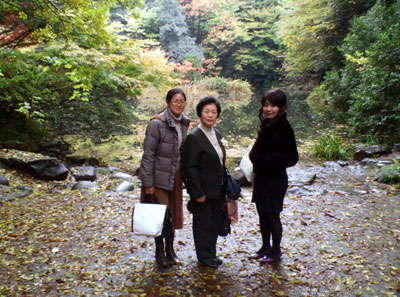
Sayaka, Kimie, and Hanako pose in front of the idyllic campus pond. Is this really Tokyo?
My friend Yanagi Kimie was visiting from Matsudai, so I joined her and Hanako's art crew for lunch. We ate at the University of Tokyo (Todai) "Metro" cafeteria. The food was typical (Japanese) college fare served on bright orange trays in a large room with scuffed walls, mismatched wall sconces, and vinyl tablecloths. The primary decor in the room are the large signs pointing hungry students to the correct counters for noodles, set meals, rice bowls and drinks. After eating, we scraped and dumped our dishes into a giant dishtray. Todai may be the most prestigious university in Japan, but it's campus meals are the same as every other uni in the world.
After lunch we had a stroll around campus. The leaves are starting to change color and it was quite lovely. We couldn't resist picking up a few red maple leaves and bright yellow sakura leaves. We stopped into one of the empty lecture halls and I found it a very odd mix of old and new. There was a modern computer-based lectern for the prof with wood and iron seating for the students.
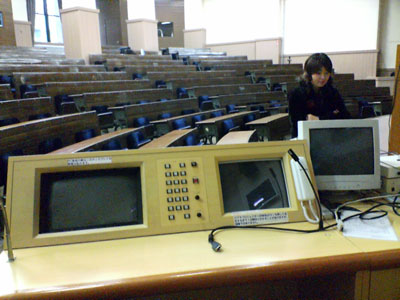
The lecture hall from the professorial point of view.
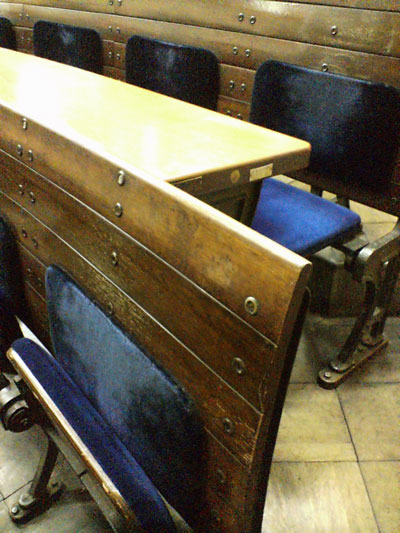
Velvet seats! The desks were marked Showa 30-something or about 1960.
Tonight was one of the most interesting office parties I've ever attended. No bland cheese and syrupy wine.
We went to a cabaret of "new half," transvestites and showgirls at Kaguwa in Roppongi. It was a great performance running about 45 minutes of non-stop, high energy dancing in kimono, short skirts, spangles, and lots of feathers.
Kaguwa seem to have enthusiastic, long-standing, well-to-do fans (sugar daddies, perhaps) who were blown kisses from the star performers. At curtain call, waiters delivered folded money to the two post-op dancers and one of the transvestites who received it with winks and kisses.
After the performance we sipped drinks and wondered "was that one a guy or a real girl?" It was about impossible to tell. Except for the three guys in the show, the others were all hot and sexy dancers with female stage names and great legs.
The stage was as cool as the dancers. Thirty two hydraulic sections lifted and dropped during the dancing to create staircases, platforms, screens, and hideaways. It was beautifully choreographed and must have been interesting to dance on.
But there was a bit of a mystery about the stage construction. When all the sections were lifted to their maximum height, they formed four 2-meter tall boxes open all the way through with a platform above. Dancers were sometimes featured in those boxes while additional action happened on top. But when individual sections were raised for stairs or platforms, the front face of each section was covered with a solid panel, no matter how tall or short it was. Where did the panels go when the boxes were fully lifted?
I walked over to the Indian Embassy today to apply for visas for an upcoming trip.
I was disappointed that the consular wing didn't look very Indian. I was hoping for rich curry colors and the scent of incense. But the building is just a regular blocky office building with only a small but shiny brass plate to indicate that it's an embassy. No proudly waving flags, no armed guards.
The waiting room was drab and old - tobacco colored linoleum, asbestos ceiling tiles, dust-encrusted stucco walls. Three standing desks, the sort with attached pens and perpetual calendars, dominated one side of the room, backed by a green bulletin board covered with handwritten notices and printed information in Japanese and English. A huge air conditioning unit throbbed behind the ranks of 50 metal chairs. Across from the desks three service counter safety windows were curtained closed when I arrived.
The decor was minimal. One large printed cotton tapestry hung next to the air conditioner. Two cheaply framed promotional posters hung from glue-backed plastic hooks and two tourism posters (the Taj, of course, and an ironic "Incredible India") tilted like drunken holidaymakers. A metal shelf displayed half a dozen pottery bowls, two blue elephant statues, and the TV that tracked our "take a number" tickets.
Fortunately, I was near the head of the line and didn't wait long. The processing was brief and efficient and I was out of there in 25 minutes with a receipt for our visas which will be ready on Friday.
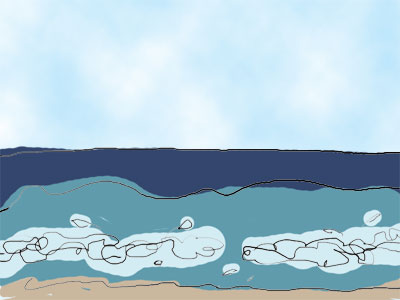
My destination
Today is Sports Health Day, a public holiday commemorating the1964 Olympics in Tokyo. I'm going to go be healthy and sporty by taking a train to the beach (collecting MJ en route), enjoying a nice long walk, then soaking in an onsen this evening. The weather is beautiful today and I'm excited to get going.
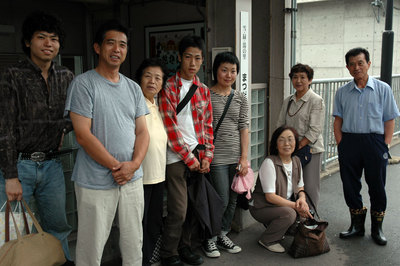
L-R: Yuki, the Yanagi's grandson; the man who taught me how to harvest; Kimie Yanagi, matriarch; Tsuchiya-san, exhausted student; Hanako Murakami, artist; Higuchi-san, of Yumatsuya; Higuchi-san's friend; Akria Yanagi, patriarch.
We didn't plan it, but six of us were leaving Matsudai on the same train. The Yanagis came down to see us all off, so I snapped this memorial photograph of our hostesses and fellow harvesters. I wish I remembered everyone's names. They were, without a doubt, formally introduced to me at some point.

Mature rice, ready for harvest
Harvesting rice is a lot of work. I have a deep appreciation of each and every grain I eat now that I know what goes into just one day of rice production. The Yanagis, and thousands of other Japanese families, toil to feed me and I am grateful.
Sunday morning at 6:30 on the dot, Hanako, Tsuchiya-san and I sat down to breakfast prepared by our hostesses, who were awake and cooking at 5:30. At 8:30, we were called over to the Yanagi’s house to dress and wait for further instructions. The waiting made me fidgety and irritable. I wanted to go pick rice, but here were indoors with Kimie, who served tea and edamame and offered us our choice of hats and boots to wear outside.
By 9:30 we were finally in the field, where Akira Yanagi, his grandson, mother, neighbor and two young boys were already at work. After a quick demonstration of harvesting skills we’d need to use, we were set to work.
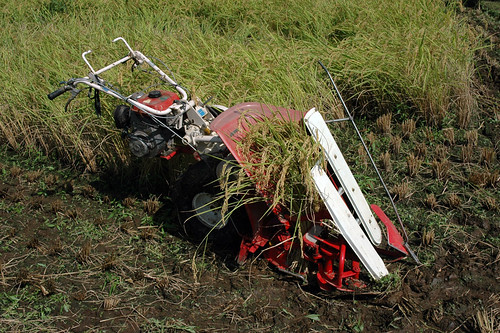
The machine harvester
Akira has a harvesting machine that growls like a lawnmower, and it’s not far off in size. The harvester is pushed by hand through the rows, cutting the clumps of rice near the ground and binding nine of them together with twine before spitting the bundle out to the side.
My first task was to follow the harvester, picking up the bundles it spit out and gathering them into sets of seven. I cinched them together with a noose-like rope, then carried the 10 kilo bundle to one corner of the field.
It was hot – around 33 C (91F) - the sky was clear blue and sun beat down on us. In a few minutes, I was sweating buckets and so was everyone else.
The harvester doesn’t get all the rice; uneven rows or a misdirected push can leave clumps uncut. So someone has to hand-cut the clumps. After a while, I followed the hand-harvesters around, picking up their clumps of nine and tying them into bundles using rice straw from the last harvest.
The technique was simple and effective – belt a few strands of straw around the bundle, twist once, and then spin the whole thing around itself to tighten the twist, and finally tuck the ends under the belt. I kept getting the thumb of my glove stuck in the twist when I spun the bundle, but a good sharp tug always freed it.
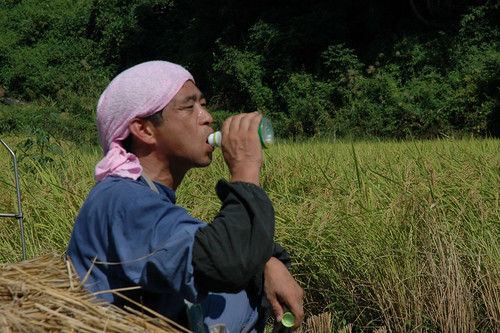
Enjoying a much-needed drink
It wasn’t long before we took a break and everyone had a small bottle of tea. Japanese don’t drink much compared to Americans. Maybe because their diet is saltier and they retain water so don’t need as much going in. I don’t know, but one 300 ml bottle of tea wasn’t enough for me but nobody else was having more, so I didn’t either. Very soon it was back to work.
More tying, spinning, cinching and carrying got us one field cleared. We moved the piled sheaves from the side of the field into the truck, laying the bundles rice-end in and alternating the direction of the layers so that the rice was secure and the grains protected for transportation.
Three men took the rice off to hang it up to dry in the sun while the rest of us started on the second field. This time, I asked to try the hand-cutting. With a short, serrated curved blade in one hand, you grasp the clump of rice in the other hand and draw the blade across in one firm movement. The trick is to make your cutting stroke count - not to saw at the rice – while not pulling the clump out of the soft muddy earth while you cut. It took me a while, but I did eventually get the hang of it. I was not adept, but I managed.
I cut out part of a corner for the harvester to turn in and a whole row along one side of the paddy, and then took a break on my own– cutting the rice was more intense than bundling and carrying – and drank the last little bottle of tea. I noticed that the sky was starting to cloud up on the horizon. The weather forecast called for afternoon rain, followed by a few rainy days in a row, so we wanted to get as much rice in today as possible. My energy was starting to flag, but I was determined not to fall behind.
The truck was back, but now parked further away, so I loaded up the wheelbarrows with Hanako and we loaded the remainder of the first field into the truck. Then I did some more tying and carrying before a break was called for lunch. We put what we had completed in the truck, tidied up our tools and rode back to the Yanagi’s for lunch.
Everyone was covered in mud and sweat. “Ladies shower first!” one of the men called out and that meant, really, that “foreign ladies” shower first. So I stripped down, surprised at how very, very wet my clothes were, and hopped into the shower. Hanako called in to me, “Do you have a change of clothes for the afternoon?” Oops, no. I hadn’t considered that. Kimie kindly loaned me an entire outfit, including a brand-new pair of her panties. I looked like a grandmother in her largest polka dotted polyester ensemble, but I was dry.
While we were in the field, Kimie had prepared a feast of tempura vegetables, simmered fish and tofu, pickles and cold somen noodles. It was plentiful and bountiful and everyone at the table dug in like they’d never eaten before.
Only I wasn’t hungry. My head throbbed, my teeth ached and my stomach hurt. Hanako noticed my lack of appetite and asked if I was ok. I wasn’t sure. I had goosebumps and was feeling cold. I’d stopped sweating and I was hot to the touch. Hanako lead me upstairs and put me to bed under a quilt. I slept while they finished lunch.
When Hanako back came upstairs to change into her field clothes, she told me I would stay there while they went back out. I sat up, sipped some tea and declared that I was fine, really. “Mom, I want to go out to play!” I pleaded jokingly. But she insisted I rest. She was right, of course, but I was terribly disappointed as I listened to their laughing voices piling into the truck and driving away without me.
I drifted off to sleep again to be awakened half an hour later by the pounding of hard rain on the tin roof. “Rain! Ah…Rain? Ah!! The laundry!” I leapt up to rescue the clothes and towels hanging outside the second floor balconies. Kimie raced up after collecting everything downstairs and we put the glass doors on their tracks and rehung the clothes – only slightly damp - on plastic racks inside the house to finish drying.
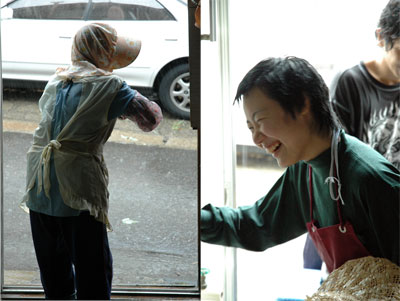
Kimiko wrings out her towel in the rain; Hanako laughs and drips into the house
That was the finish of the harvesting day, of course. Moments later the crew returned, soaked again but this time with rain. They were laughing and wringing out their clothes. We handed out all the towels and they changed – again – into clean dry togs.
Despite the heatstroke, I enjoyed the harvest immensely. I grinned like an idiot in the field, so happy to be joining in an aspect of life that is mostly hidden behind city supermarket price tags. And I hope this first harvest wasn’t my last.
(For more photos, see my Rice Harvest photo set on Flickr)
I've been away from the computer mainly spending more time in Matsudai. So much happened last weekend that I'm hard pressed to recount it all, but here I go.
Thank you to Hanako Murakami for introducing me to Matsudai and its people. I really do love that town. And congratulations to Hanako for shepherding an amazing performance of mushroom dancing at Nobutai on Friday last week. "Kinseees!" was an energetic, delightful surprise.
Higashino-sensei's dance as the お化けキンコ (mushroom ghost) was exactly the right complement to the old folks doing their dances. She encouraged them, teased out their special talents and made the evening flow. Motohei-san, at 82 the oldest dancer in the group, was so full of joy and humour that it was hard not to whoop and holler during all his little solos. I know how much work everyone put into creating the evening's entertainment, and I think all 160 of the audience members were impressed. I didn't take my camera that evening, choosing to enjoy the event without the lens between me and it - a wise decision, even though it means no pictures for you.
One of the items in the Kinseees! program was each dancer's favorite mushroom. The モグラ was often mentioned, but we don't know "mogura" as a mushroom - it's a mole. Now Tod does cutest impression of a mogura (the mole, not the mushroom) that makes me giggle and ask for encores.
The two days after Kinseees! were the Matsudai matsuri. We hung around town to tour the Triennial art and spent Saturday evening drinking and singing with the adult children of some of the dancers. I had my recording gear and turned the evening into the latest Hanashi Station podcast.
![]() Matsuri in Matsudai (10'15" 9.4 MB MP3)
Matsuri in Matsudai (10'15" 9.4 MB MP3)
Matsudai, population 4,000, is divided into three sections: Kammachi, uptown; Nakamachi, midtown; and Shimmachi, downtown. We were at the top of the hill in uptown most of the night, where the drunken karaoke and dancing took place. Midtown and downtown were equally lively, but more family-oriented.
Early in the evening, before the party really started, the skilled singers encouraged Tod & I get up and do a duet. You really cannot refuse people who ply you with sake and snacks. We flailed our way through John Denver's Country Roads - one of the few English songs in their midi-based karaoke system. Later on, we were called on to perform again - "Mr. Tod and Kristen dancing please!" - and foxtrotted clumsily to some beautifully sung enka.
The town reporter captured all of this and more with his camera, so I expect there will be at least one photo of us in the local newspaper. Horrors! But I wonder how I can get my hands on a copy of it?
Over the course of the evening, we were treated to many plates of food, cups of drink and little gifts. I was so stunned by the generosity that I took an account: 6 onigiri; 2 bowls of kenchin soup; 2 dishes of pickles; 10 sticks of yakitori; 4 shiso-cheese gyoza; 1 plate of fried octopus; 2 grilled sazae; 1 packet of otsumami; 1 harisen clapper; 1 pink stuffed monkey; 1 pair pink sequined devil horns; 1 pair of sequined devil horns; 2 glasses of tea; countless cups of sake.
All that, plus a few things I was actually allowed to pay for, made up the feast of the evening as we sat around the streetside fire pit. Thank goodness there were a lot of people in our little tribe to share the bounty. I don't think anyone went hungry that night.
After the matsuri, I rolled a very tipsy Tod down the street to Kimie-san's family's second house, where we spent the night with Hanako and her crew. In the morning, before anyone had a chance to sip their coffee, Kimie-san turned up with freshly cooked rice and laid our breakfast table of pickles, simmered dishes, soup and rice. She is such an amazing hostess.
We took our leave of Matsudai the next day, after watching the kids' parade of mikoshi (portable temples). Tod helped to pull one of the huge wagons full of kids. I turn turns with the local police are trying to catch fish with a paper spoon. I took photos which I will develop and post eventually.
If this were my last trip to Matsudai, I'd be sad, but I am hoping/planning to go back in a couple of weeks to harvest rice with Akira-san, Kimie's husband. I may be a liabiliity, but I will work hard and it will be a good experience. Matsudai always is.
Camping on the cliff above Sobama beach, our group of eight did a lot of relaxing nothing this weekend.
After brunch each morning, we sat under the shadecloth talking for hours about whatever came to mind: halloween costumes, books, travels, work. Lukie showed me how to do contact juggling. Aya sketched. Everyone sweated. We indulged in ocean swims, cold showers, and lots of beverages until it was time to head into Ogi for dinner at the festival market and then to walk up the hill to the evening's Earth Celebration concert.
This year, Kodo played with a dance troupe called Tamango's Urban Tap. As always, each group took a bit of the other's style and incorporated it into their performance. I cannot say I'd ever expected to see four women in yukata and geta doing a tap dance, but they did - giggling like girls as they sang their own accompaniment - and did a fine job of it, too. Tamango led the audience in singing the Zousan song (which made Zoupi exceedingly happy) where he bungled some of the words, then led an African chant where the audience bungled most of the words.
Recording the Kodo concerts is strictly prohibited and I respected that, but I did capture some frenetic drumming at one of the after-concert fringe events. If you'd like to hear the noisy musical atmosphere of the festival market in the late evening on August 18th, have a listen to this:
![]() Earth Celebration Fringe Drumming 4'59" 4.6MB MP3
Earth Celebration Fringe Drumming 4'59" 4.6MB MP3
Here I am blogging from the Matsudai dormitory where I'm spending the week helping Hanako with a mix of video editing and minding the Hotta Rakashi Memorial Museum.
Once again I am stunned by the generousity and friendliness of the townsfolk who have taken Hanako under their wings. We have been well fed from garden produce, given handmade treats, and chatted up every time we walk out the door. There have been offers of beds, invitations to meals and events, and photographs taken at every turn.
The town has transformed since the first time I came up here. It's busy all day. Nobutai is mobbed with people in the gift shop, participating in workshops and watching performances. There are scores of people visiting the village with "stamp rally" booklets in hand, collecting stamps at every place they stop to see the art. The shotengai (shopping street) is an art gallery itself with big and small exhibits up and down the street.
Speaking of which, I must return to mine and greet the visitors with a cheey "Irasshaimase!"
Will be back in Tokyo on Monday with stories to share.
We walked to Ueno Park and rented a rowboat for an hour. I love rowing around Shinobazu pond on a Saturday afternoon. Afterwards we stolled through a flea market, relaxed with a bath and karaoke, then had dinner and walked home.
Even though Japan is not such a huge country and we try to travel around as much as we can, there are lots of places we've never been. Today we're going up north to Towadako in Aomori-ken to enjoy the caldera lake and woodsy mountain air.
This time, I know I'm getting on the right train.
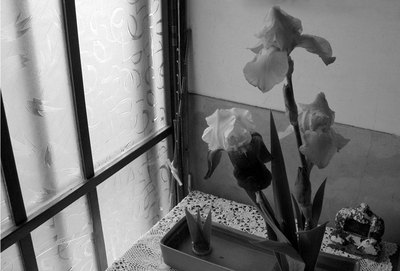
Iris in the genkan. Click for larger view.
The genkan is the Japanese entry hall where you remove your shoes and set your bags before stepping up into the house. In Matsudai, fresh flowers greeted us at every home.
I've added a dozen more photos of home interiors, people and gardens to the Matsudai set on Flickr.
This weekend I was back in Niigata taking photos. This time Tod came with me and we decided to take the train instead of the gallery's "staff bus" that leaves at an ungody hour from the gallery across town.
So I checked the very handy Jorudan Norikae site and typed in Tokyo to Matsudai in Japanese. I got our route, the time and cost and we set out with plans to arrive at 12:13 in time for my 1:00 shoot.
At 12:11, we realised something was amiss. "Next stop, Matsushiro. Matsushiro, next."
Huh?! MatsuSHIRO??
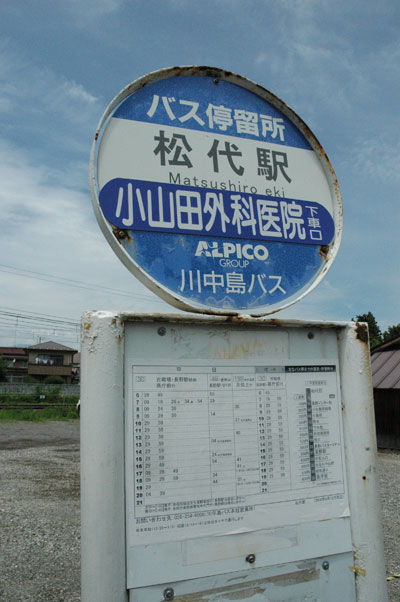
bus stop at Matsushiro station
Matsudai and Matsushiro have the exact same kanji - 松代. Since that can be confusing, my Matsudai uses hiragana for its station name. まつだい. I didn't know this, since last trip I didn't go anywhere near the station.
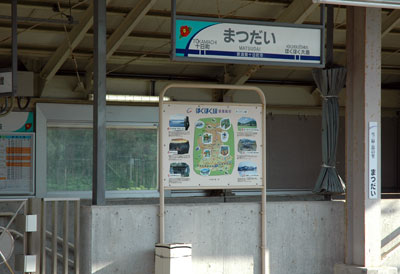
Accept no substitutes. This is Matsudai
I know in a vague way that Matsudai is not too far from the Nagano-Niigata border, so it seemed reasonable that we'd go up towards Nagano, then get a local train from there. But as it turns out, we should have been on a different Shinkansen line altogether, taking a different set of two local trains.
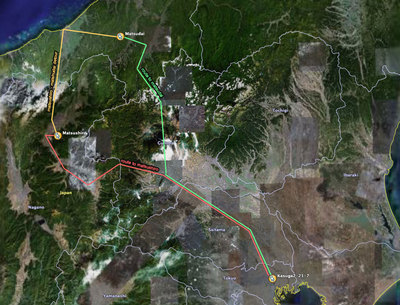
The long way around. Click for larger view.
Hanako assures me that I am the only person in Japan who could have made this mistake, but in my defense the towns have very similar details if you don't check the details or look at a map. If someone said to you "it's about 200 km, takes 2 1/2 hours and costs around 7,000 yen" you'd be hard pressed to know which was correct:
| Matsudai まつだい | Matsushiro 松代 | |
|---|---|---|
| Cost | 7,120 yen | 7,060 yen |
| Travel Time | 2:27 | 2:37 |
| Train 1 | Shinkansen (199 km) | Shinkansen (189 km) |
| Train 2 | Joetsu (17 km) | Shinano Tetsudo (20 km) |
| Train 3 | HokuHoku (30 km) | Nagano Dentetsu (9 km) |
It took almost 4 hours to get from Matsushiro to Matsudai by bus and local trains, so I missed the 1 o'clock shoot and showed up amidst the 3 pm appointment. But I made up for it by taking 380 pictures on Sunday, so it turned out OK.
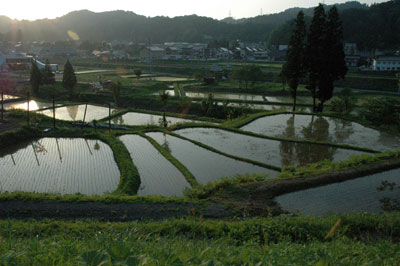
I went to Matsudai, Niigata this weekend as part of キンシーズ (Kinshees), an art project in the Echigo-Tsumari Art Triennial beginning July 22 and running through September 10.
What a beautiful place. I had my camera with me and took a lot of photos. Some scenes from the town are up on Flickr and I'll add more through the week.
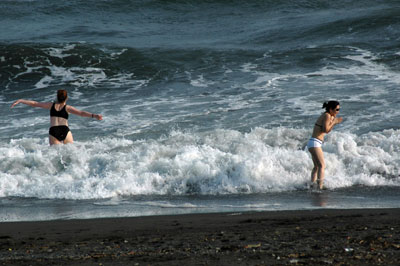
Hiratsuka, Kanagawa. May 5th. photo by JJ
The ocean was frigid and the waves were fierce but for some of us, swimming was an irresistable temptation.
Tara chatted me this morning, "I'm going east today. You want to come along?" She's been taking advantage of her unexpectedly extended trip and trying to visit out-of-the way hanami spots around Tokyo. Today we went out to Higashi Oojima on the Toei Shinjuku line, and walked along the 小松川千本桜 (Komatsu River 1000 Cherry Trees).
That part of town is so unlike the Tokyo we are familiar with. It is completely flat. There are wide open areas on either side of the river - playgrounds, sports fields and grassy picnic areas where you can see a lot of sky - surrounded by blocky concrete high rises in pastel colors. It looks more like Singapore or parts of China than Tokyo.
It felt like we were a thousand miles away when it was only a 20 minute subway ride from home.
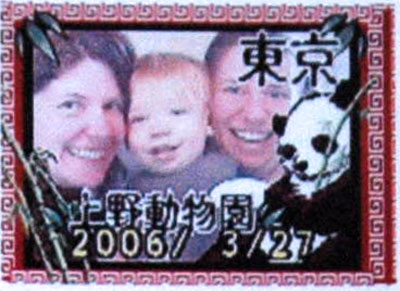
Me, Sean & Tara at the zoo
I took advantage of the lovely spring weather to go to the zoo with Tara & Sean. I love the zoo enough on my own, but watching an 18 month old enjoying the elephants, prairie dogs and penguins is a kick.
Sean toddled from place to place, signing "more, more" a lot. He figured out how to climb up onto the curbs and low railings for a better view over the handrails. And he waved goodbye to the animals before running off, hands in the air, to see something new.
He was equally fascinated with the trash cans, water fountains, and rocks. It's good to be little.
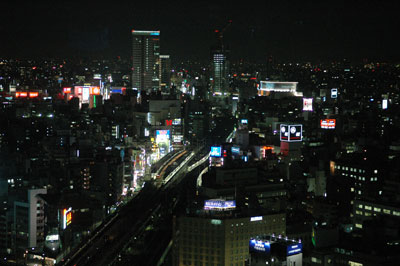
Akihabara from Otemachi
By request, a larger version (1024x768) and a bonus image from the same vantage point.
Tod & I met for lunch today at an interesting French cafe in Marunouchi. Brasserie Aux Amis looks French--from the red leather seating accented with brass fittings to the drawings and writing penned on the walls. The Japanese waiters speak French. They play French radio quietly in the background. On fair days, there is sidewalk seating.
And ooo-la-la, the menu! Aux Amis offers two lunch specials (1050 yen each) that include a choice of entree and a main of fish or meat. Today's meat dish was roasted Ezo deer served with bacon-simmered potatoes and carrots. It was delicious. I had the pork rilettes for my entree. Meat, meat, meat! Tod had the fish (herb infused steamed suzuki over a creamy cabbage risotto) and started with a tiny slice of quiche lorraine. We finished off our meal with an espresso (210 yen) but were so satiated that we passed on the mocha eclair (also 210 yen).
Next time you find yourself in Marunouchi or around Yurakucho at lunchtime, I suggest you stop in. They have other restaurants and wine bars scattered through Marunouchi and Ginza, and run a small chain of flower shops.
Brasserie Aux Amis
Shin Tokyo Building, Marunouchi 3-3-1 [map]
Tel: 03-6212-1566
Monday - Friday 11:00 - 24:00 (LO)
Weekends/Holidays 11:00 - 23:00 (LO)
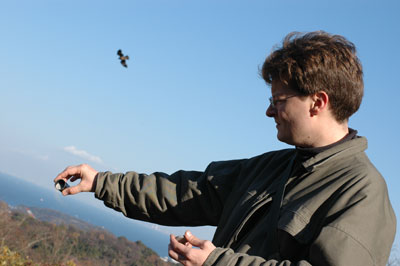
Sayonara
Taking advantage of the beautiful clear day, Tod & I hiked up to the top of Mt. Futago to scatter some of his Uncle Bernie's ashes. We visited it once before* about five and a half years ago to scatter his Aunt Sally. I feel good knowing that now they are together enjoying the view of Yokohama and Tokyo.
Mother Nature has been at work since our last visit, making it difficult to follow the course outlined in Gary D'A . Walters' Day Walks Near Tokyo. A typhoon blew through last year, downing massive trees all along the trail. We navigated over and under them to make our way through but some side trails seem to have vanished and signage is missing. The remaining signs have been helpfully annotated in marker by other hikers, though, so it's not as bad as it might have been.
At the advice of a local man we met near the trailhead, we did not take the route from the top of the mountain to Taura, as the book suggests, because the man said it was badly degraded from the storm. We walked through to Higashi-Zushi instead, which turned out to be shorter and easier than I remember the other way being. At least this time, we didn't get lost.
*I made a video that day--May 4, 2000--including the part where we got lost. You can view it here: 31 (98 MB Quicktime) duration 6'03"
Did you know that you can walk out of a station and within five minutes walk from Shinjuku-ku through one ku and into a third?
I'm not going to tell you which station or which ku. Can you figure it out?
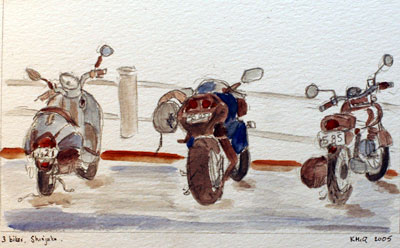
3 Bikes, Shinjuku. 12:05 - 12:50 pm
I had fun on the sketchcrawl, though it was only me and a patient non-drawing Tod (who slipped into Kinokuniya and bought me books as a surprise when I finished my drawing!)
I hope a few more people turn up next time...
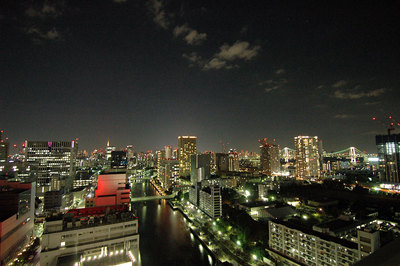
View of Tokyo from a 24th floor Shinagawa apartment. (Click for larger view)
Congratulations to Egon & Naoko on securing one of the best views in the city.
All of the neighborhood cats, usually stretched out in sunny alleys or hunkered under parked cars watching one another, have disappeared.
In their place are signs neatly laser printed and tucked into protective plastic folders explaining that recently there have been a number of incidents where cats have been killed. The causes were not stated, but the signmaker implores people to "Please be careful of your pets and children."
It's very sad. I miss the cats.

Does the Flying Spaghetti Monster live in my neighborhood? (Click for larger view)
This broadsheet appeared in my mailbox for a nearby highrise. I couldn't help thinking that Verdure Residence "Foliage" might be a good place for the Flying Spaghetti Monster to live.
The Flying Spaghetti Monster, for those yet uninitiated, is a satire on the "Intelligent Design" theory of creation. His followers, who believe the FSM created the Earth and continues to influence it with His Noodly Appendage, have sent letters to all the boards of education who are advocating teaching intelligent design and have received some responses.
You can read all about FSM and his followers (the Pastafarians) at Church of the Flying Spaghetti Monster.
I can see this building from my window, so will keep an eye open for His Noodliness to come around with the moving van. If you want more information about the FSM Apartments, check out the website (in Japanese) at Joint Corporation

I'm flying!
This weekend we went to Ibaraki to try paragliding with the Tokyo Gaijins, a group that organizes outdoor activities like skiing and camping.
We did tandem jumping with skilled paragliders, and got to jump off a 300 meter mountain and glide through the air to land in a field at the base of the hill. It was wonderful to be in the sky. I was a bird. I stretched out my arms and felt the wind sliding past me like a current. I yearned to play with the controls.
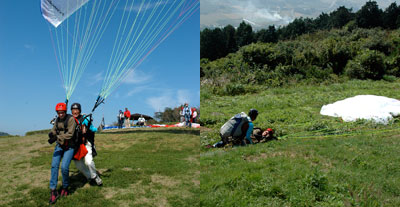
Tod captured the moment of my stumble and the result.
My takeoff was not so smooth, though. As we ran towards the cliff, I tripped and fell, dragging Kanamoto-sensei and the wing with me. No damage done and we managed to get off the ground on the second try.
One of our party took short videos of everyone flying and she will send them to me for posting. I'll let you know when they're online.
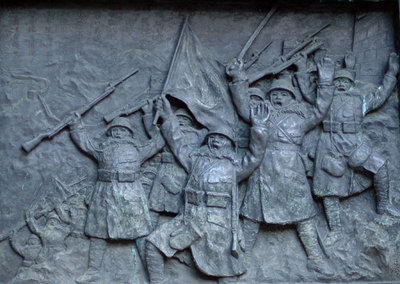
Victory or agony? It's hard to tell.
I've been to the controversial Yasukuni Shrine a few times. This is where Koizumi gets in trouble for paying official visits because it enshrines the war dead--heros and Class A criminals alike.
Walking through it on Sunday evening, my eye fell on the large stone lanterns that flank the entrance. On each side of the hexagonal base is a bronze scultpure with a war scene from land or sea.
You can see all six of the brozes and the lantern they are attached to, in my Yasukuni Flickr set
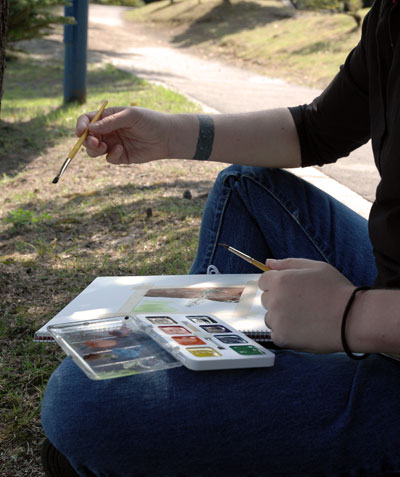
Two-fisted painting
Having quickly tired of the bath and hotel, I spent the second morning drawing a little bit of tree trunk after having another walk around the grounds. I made a recording of birds sounds with a stream burbling in the background (and a bit of a breeze, too).
![]() Karuizawa Birdsong 1'59" MP3 (1.8 MB)
Karuizawa Birdsong 1'59" MP3 (1.8 MB)
(Click to see the photo Tod snapped while I was recording--if you listen carefully, you can hear his camera's shutter.)
After lunch, Tod rented a bicycle and scouted out the rest of the complex while I sat on a moss covered rise to execute a a bunch of 60 second sketches as a drawing exercise.
We were to take up the tour again at 14:20, but the bus was two hours late--stuck in traffic on the way from Tokyo. By the time we left the hotel theday was fading. Our apple picking and grape picking were reduced to short hops off the bus at roadside stands in the pitch dark to be handed some fruit and shuffled back onto the bus. Terribly disappointing, as I'd looked forward to standing in the orchard and smelling the fruit and the earth.
We arrived at home 4 hours late. We'll never do a bus tour on a weekend (particularly a holiday weekend) again.
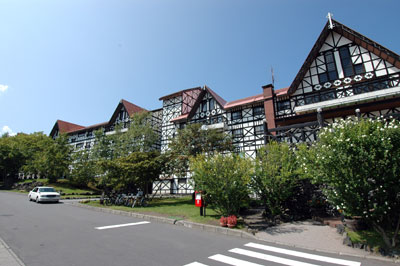
Hotel Green Plaza, Karuizawa
One thing Tod & I had never done until this weekend was to take a Japanese bus tour. They seem the province of older Japanses folks, but this is "Respect for the Aged" weekend, so it was the right way to celebrate.
We showed up on time at the appointed departure place, but screwed up right away by failing to notice the seating assignments posted on the door of the luxury bus. We really bollocksed up the works by sitting two rows ahead of where we were assigned. Because we couldn't fight our way back down to the front of the bus, a fellow passenger had to check the chart and shout our assignment to us. Embarrassing, but it was our only obvious error of the day.
The bus started off with two rounds of applause (for the guide and the driver) and a lot of explanations. We were offered the choice of reserving a popular lunch option for our meal stop, and a bento for the return trip the next day. We opted for both, as it seemed simplest.
Lunch was kamameshi, a steamed rice and chicken dish, at a roadside restaurant that's been serving it for 120 years. I guess that makes is popular, as advertised. They certainly had the bus tour business down pat. A man with a flag bearing the restaurant's logo greeted our bus as we pulled into the parking lot He waved teh flag high as he lead the lunching crowd through the gift shop and upstairs to our long table in the restaurant.
Back on the bus, we continued north to Karuizawa, a famous mountain resort area where many well-off families have summer homes. We'd spend the night at a hotel and on the way back, we'd stop along the way to pick apples and grapes.
"Karuizawa is a little bit interesting," my friend Elizabeth warned me. "It's where the upper middle class go for the summer, and it's a mix of Western styles and Japanese tastes."
She was more spot-on than I imagined. Many of the buildings, including the hotel, are half-timbered Swiss look-alikes. The summer homes span a wide range of styles, none of them particularly Japanese. Our hotel room was split in two: half the room was carpeted, papered in a floral design and sported twin beds. The other half was tatami with a low table, zabuton cushions and the ubiquitous complimentary green tea.
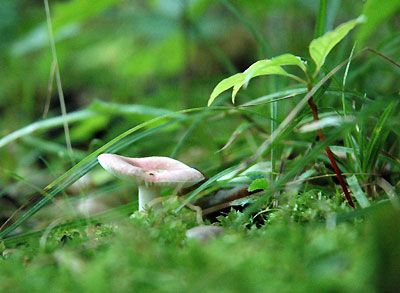
Beautiful flora
Shaking our heads in wonder, we headed outside to walk around the complex. The air smelled clean and woodsy and it wasn't long before we were off the beaten path and hunting for interesting flora and fauna. I spotted a pink mushroom; we marvelled at moss and discovered a well-contained stream meandering through the property.
Of course, we enjoyed an onsen bath and the hotel's extensive buffet dinner before heading off to bed. We had more fun in store for us the next day...
After enjoying a private bath together after dinner, Jim, Tod & I retreated to the 8th floor to sit outside on plastic deck chairs. Yuka went off for a massage and facial. I needed a Scotch.
So Tod & I went up to the observation lounge bar (open at long last) where a passel of yukata-clad salarymen were wailing karaoke. We scooted around them and bellied up to the bar.
Tod asked the barman if we could get some drinks to take downstairs. Sure, no problem. Could we charge them to our room? Yes, absoutely. He called over a girl dressed in a blue plaid uniform and asked her to pour our drinks while he wrote up the check.
"Um, straight, please," Tod reminded her. "No ice."
"And no water?"
"Right. No water."
This confusion lead her to pour our liquor like it was oolong cha. She finished off a bottle and her manager handed her a new one to top up the third drink. We received three juice glasses with five fingers of scotch each. Total bill: 1500 yen.
We laughed all the way to our deck chairs and the unfinished portion of our Scotch came home in my thermos bottle.
We spent today recovering from the excitement of the Expo by sitting around our seaside onsen hotel in Nishiura.
After 9:30 am, we were the only guests in the entire building. I don't know where everyone else went, but we encountered no other guests. Everything in the hotel was closed. Lights were off in the hallways. Staff walked by like zombies in a videogame. It was spooky, and Jim captured it all on film.
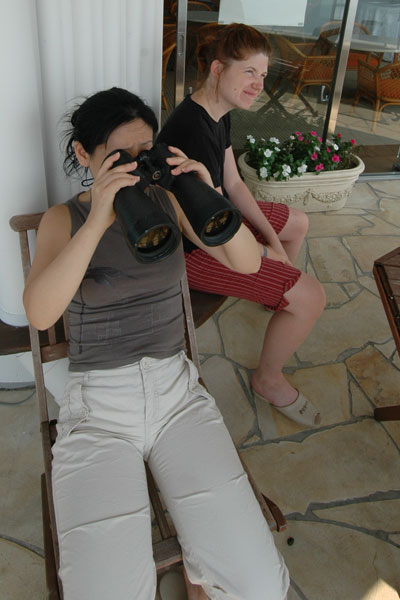
Looking at the sea
So we took advantage of the situation and chilled out on the abandoned 10th floor observation lounge. There were hawks to watch and conversations to enjoy. Tod sussed out the CD player for the lounge and we listened to music and danced. It was a good day.
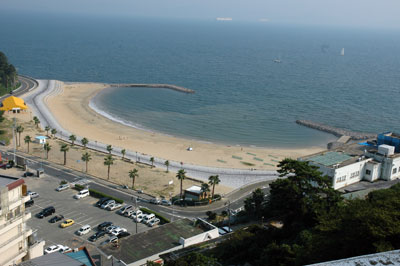
Nishiura beach
In the late afternoon, when the unforgiving heat had eased a little bit, we went down to the beach.
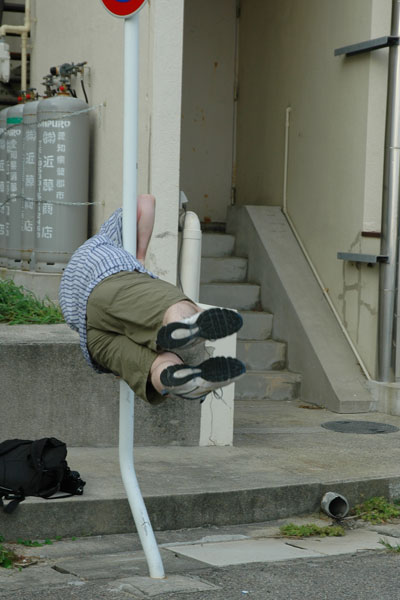
Jim does tricks
Jim amused us and the doormen at beach hotel with his pole trick. I think this is something that only men can do. Despite our efforts, Yuka and I failed to levitate.
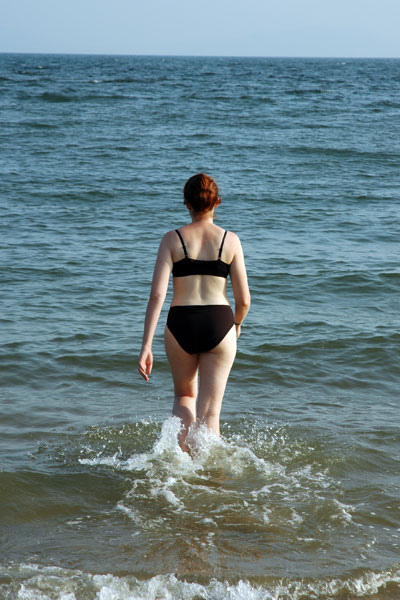
Walking into the ocean
But we did get to swim in the sea. Yuka had the foresight to wear her bathing suit. I swam in my underwear again. Tod & Jim weren't so brave; they stayed on shore.
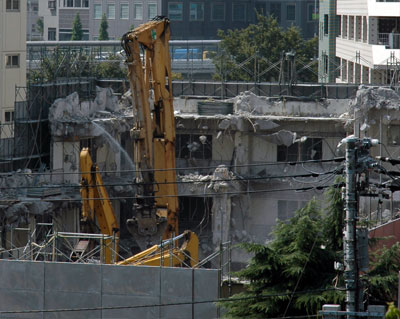
Blue truck on Expressway #5
"Oh, red flashing lights over on the highway," I noted to Tod last night, as a police traffic stop caught my eye.
What I didn't twig to was that I haven't seen the highway from our veranda since they finished building the ugly green striped apartment building last year.
The destruction of the building across the way is moving along quickly. The workmen remove the metal sheathing as they pull down each floor, so now we can see all the way across to the highway. I wonder what they are going to build here?
Tod & I and a large bunch of friends spent the day at a park bigger than a breadbox. We had to take the train out to Tachikawa to do it, but it was worth the 45 minute trip.
Showa Kinen Koen (Showa Memorial Park) used to be a military base. Now it's a giant playground. There's a series of shallow swimming pools and four waterslides; a mini-golf course, croquet lawn, frisbee golf course, boat rental, a bike trail, gardens & forests, a huge cargo net for climbing, and a series of bouncy trampoline hills.
If you want to splash in the wave pool or waterslide, hurry out to Tachikawa--the pool closes on September 4th. The rest of the park is open year round.
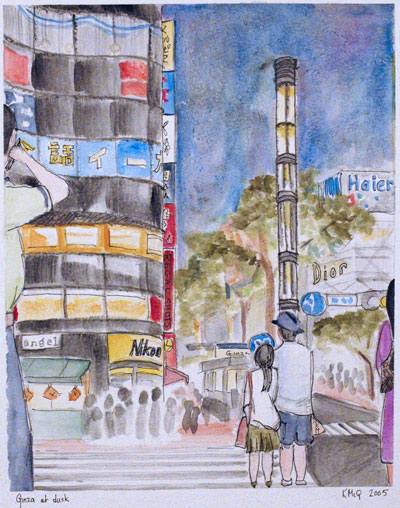
The neon glow isn't as obvious when I draw it
After work today, I walked over to Ginza and plopped myself on a low stone wall to draw. I wanted to try to capture the glow of neon against the early evening sky. It was as challenging as I expected and I learned a lot that I will put to good use next time I am out drawing at that time of day.
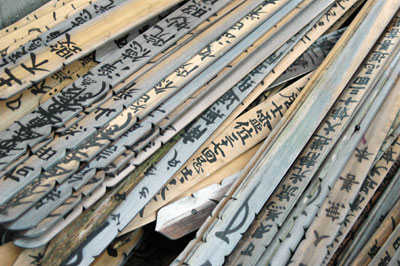
Prayer sticks, Aoyama Cemetery Photo by Tod.
A few minutes walk from Shinjuku's East exit you will find a two-hour getaway--quite a few of them, in fact--in the form of love hotels. I don't know if love hotels exist outside Japan but they certainly don't rear their heads in America, so for the benefit of foreign readers, here's a brief description of the neighborhood and the hotel I visited this evening.
Shinjuku's Kabukicho 2-chome is adjacent to one of Tokyo's seedier neighborhoods: Kabukicho 1-chome is all sex shops and massage parlors lining the neon-lit streets; young toughs in suits and over-coiffed hair stand outside to entice customers into their establishments. Not quite as blatant and a bit of a step up, Kabukicho 2-chome is known for well-appointed short-term hotels.
Hotel Tiffard is one of these places, about halfway down the main avenue of hotels. It doesn't stand out among the rest but it seems as good as any of the others. On a weeknight 6800 yen gets you two hours in room 508--equipped with a Jacuzzi, a steam sauna, karaoke service, a vending machine full of toys, and dimmable lighting.
Two points worth noting:
1) Get out before the clock rolls over 2 hours or you will pay for an extra half hour even if you are only 2 minutes past the checkout. If you want a leisurely pace, it's better to pay for the "stay" than the briefer "rest."
2) Be sure to visit Shinanoya at the corner before you head up the street. I swear this place has the best selection of Scotch and bourbon in Tokyo. And not a shabby wine list, either. There were several Margaret River wines I haven't seen before and a good selection of the usual favorites. (Plus some with screw tops, which are handy if you've forgotten your wine pull.)
It feels naughty to return home on the last train of the evening and realise that 20 minutes earlier you were enjoying the best amenities of a hotel room. Piqued your interest? Here's a coupon
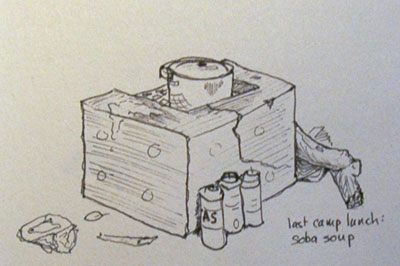
One final sketch before packing up to leave
I am certain we had the most elaborate kitchen of any other campers at the Niijima Camp-jo. We fed between 7 and 12 people per meal every day for a week. When the full compliment of our group was present, we had 4 camp stoves, two fires, and enough pots and pans to require a crew of four dish washers.
Our meals were spectacular--no instant noodles for us. From fruited pancakes to thai curry to daikon cakes to saffron chicken, we cooked up a storm (and in one, too). We ate three meals a day and there was still time for countless trips into town for shopping adventures. We know all the Niijima grocery stores.
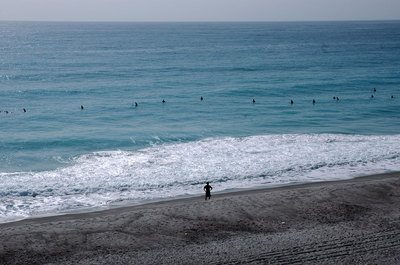
Click for screensaver sized version
Niijima is well-known (in Japan, at least) for its surf. But on the morning I took this photo, the surfers were more hopeful than active. They did eventually catch a few waves, but there were better days for hanging ten.
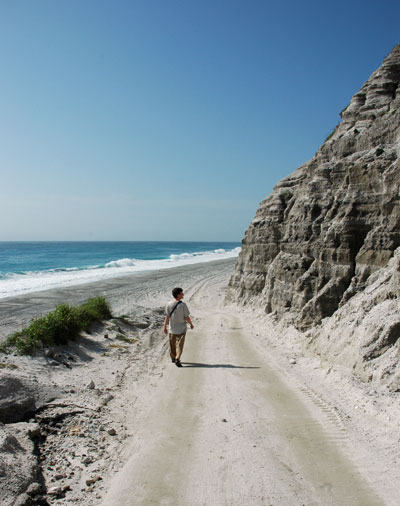
Tod admires the cliffs near Secret Point
Happy birthday, darling.
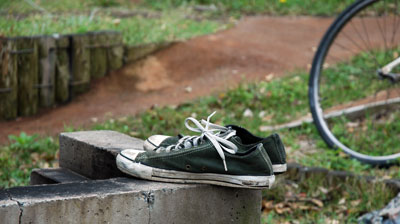
Tod's sneakers dry out on the fireplace
Everything was soaked--mats, sleeping bags, us. What a night of wind and rain.
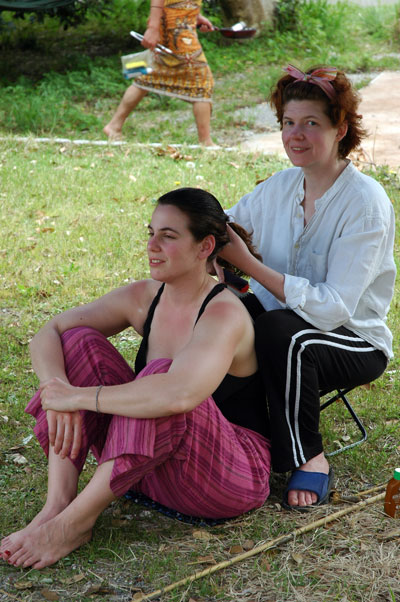
Smoothing coconut oil through Rachel's hair
Bring a bunch of girls camping and you get to do fun, girly things. I had the corner on the hairdressing market--brushing and braiding tresses all week. It was fun.
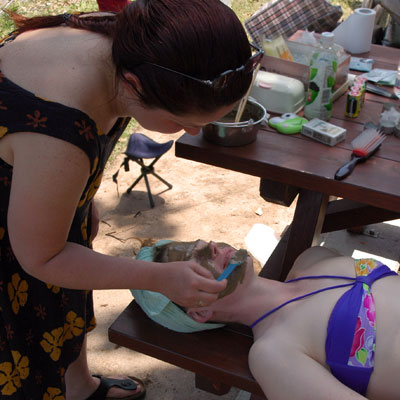
Trying not to giggle as Tracey applies a mud pack
I also received. Tracey brought along a bunch of facials to soothe our sun and wind burned skin. As I ambled from our site to the communal sinks, I thought "Yikes! I'm walking through camp in a bikini!" Then I remembered I had smears of mud all over my face and a green towel wrapped around my head.
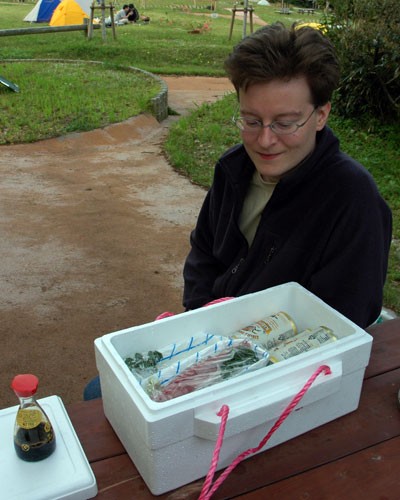
Tod with unexpected blessing.
5:00 on Saturday evening, a white-clad kitchen worker arrives at camp. After calling out a name loudly and wandering up the path, he stops not far from our campsite. Tracey speaks to him for a few minutes, then goes off to look for "three girls in a tent" who ordered the food.
They were not to be found, so Maeda-san, the delivery man, left the cooler with us. Inside: ika and kampachi sashimi, three beers and some soy sauce. A feast for which the man would not take payment.
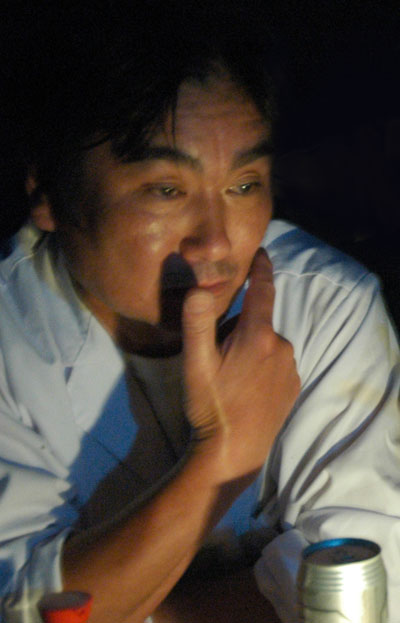
Maeda-san, our benefactor
He returned that evening with some beer and settled in for a snack and a chat. He wanted to apologise for inconveniencing us (by giving us free sashimi?!). We invited him to stay for dinner, he had to return to his kitchen to tidy up. He took a shine to Tod who has the best Japanese of any of the gaijin in our group.
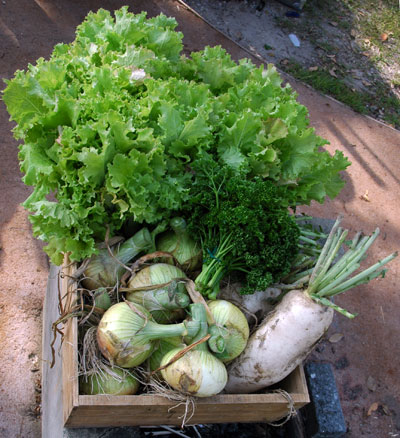
Vegetables from Maeda-san's garden
The next morning, he brought us a wooden box full of daikon, onions, parsley, and lettuce. He even came back on Wednesday with fruits...we have no idea why, but are grateful nonetheless.
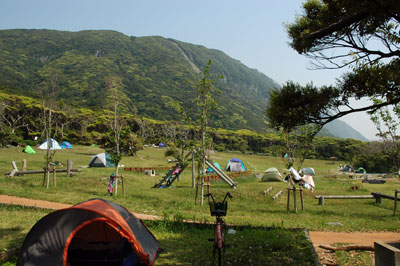
Across the site
Niijima has a well-designed campground. The toilets are clean; there is a large communal area with sinks and barbecues; and each site is neatly flattened out for tents and delineated with wood fences.
And as a bonus--there is no cell phone reception. You cannot help but relax here.
Not to mention that the air is clean, you can hear crashing waves, and there are lots of stars in the night sky. It's a heavenly place to chill out and enjoy nature.
Although it took us 20 hours to get there (our boat was canceled and we had to wait all day for the next one), it was worth the wait.
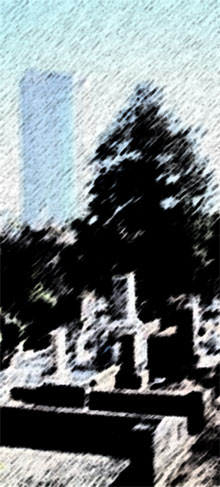 The foreigner's section of Aoyama Cemetery in Tokyo is under threat of being bulldozed. Why? The old dead foreigners aren't paying their cemetery fees. Bad gaijin!
The foreigner's section of Aoyama Cemetery in Tokyo is under threat of being bulldozed. Why? The old dead foreigners aren't paying their cemetery fees. Bad gaijin!
According to the cemetery's rules, if a plot's 590 yen/sq meter annual fee isn't paid for five years, a notice goes up and the plot will be razed at the end of a year. 78 plots in Aoyama Reien were flagged in October and many of them are in the foreign section.
These are the graves of expatriates from the Meiji era, men and women who promoted Western ideas and practices in Japan--doctors, educators, missionaries, and artists. Although many of their contributions live on, it seems a pity to remove their memorials.
There is some hope; according to an article in the Daily Yomiuri on Friday the city government is reconsidering for some of the "important" graves--those foreigners the city employed way back when. They will make a final decision in April.
Not everyone is convinced the government will do the right thing. From the Yomiuri article:
Yuzo Takahashi, a Tokyo University of Agriculture and Technology professor specializing in the history of science and technology, is calling for the preservation of foreigners' graves."It's unthinkable that those who contributed to the modernization of the country are being forgotten. I'd like to see their graves preserved. In the case of foreign nationals, it can't be helped that fees aren't paid, but I hope the government will preserve as many graves as possible," he said.
Which still leaves the problem of the "unimportant" foreign graves.
The Foreign Section Trust is forming now to take action. We hope to first pay off the debt on the delinquent tombs and then build a trust fund to take care of them in the future. And just imagine the fun and good feelings at the FST hanami party (currently slated for April 2).
If you're interested in joining the society--whether to donate money, sponsor a plot, or offer your help with administration--visit the fledgling FST site and send an e-mail.
Our friends, Jim and Yuka, bought an apartment near us--a 22 minute walk away, to be exact. They moved in yesterday and we went over today to help them unpack. We celebrated Boxing Day by un-boxing things.
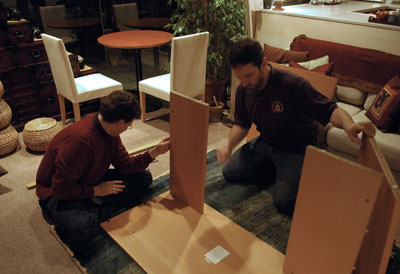
Tod & Jim put the desk together.
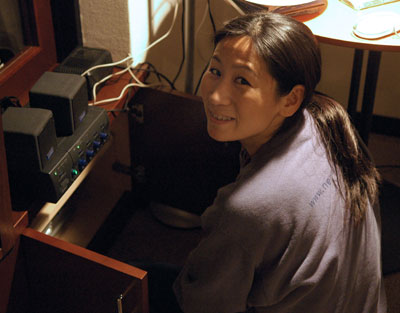
Yuka put away all the CDs into the built-in cabinets in the living room.
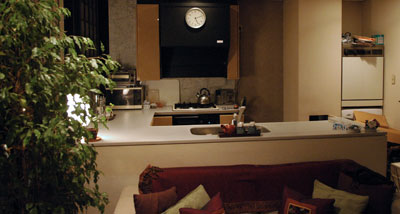
I spent my afternoon in the kitchen with good results.
Eight and a half years ago, when Tod & I first visited Japan, we saw a building in Ginza with an unusual round upper story. "Is that thing revolving?" we wondered.
Fast forward to this evening. Answer: yes, it is revolving.
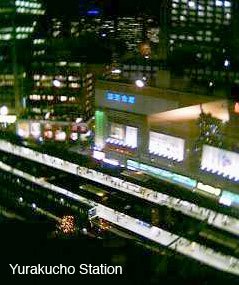 The Tokyo Kotsu Kaikan is home to one of Tokyo's three revolving restaurants, the Ginza Sky Lounge. (The others are at the New Otani in Akasaka and the Hotel New Tsukamoto in Makuhari, which is really in Chiba but close enough to count.)
The Tokyo Kotsu Kaikan is home to one of Tokyo's three revolving restaurants, the Ginza Sky Lounge. (The others are at the New Otani in Akasaka and the Hotel New Tsukamoto in Makuhari, which is really in Chiba but close enough to count.)
The Sky Lounge serves French food and a 360 degree view every 40 minutes or so. We didn't take good timings, though we went around about 4 times while we were eating. We were having entirely too much fun pointing out the sights to remember to note the time and relative position.
"Oh, there's the Rainbow Bridge, peeking out between the skyscrapers."
"Look at how the tracks into Tokyo Station make a sinuous path."
"Are those red and blue elevator lights on the Dentsu Building?"
"I've never see the yellow flashing lights on the highway before."
Perhaps it was silly to be so delighted, but I was smiling all through dinner. It's highly agreeable to sit still and watch the scenery change.
I especially liked the gorgeous reflections on the Mullion building of the passing trains and people waiting on the Yurakucho platform.
Let's go there for lunch someday.
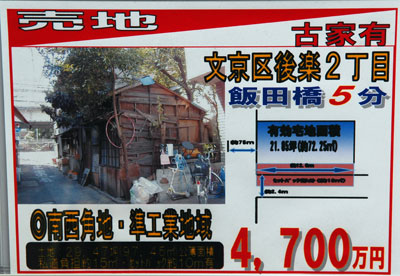
At a realty office. Photo by Tod
Land for sale - includes old house!
Bunkyo-ku, Koraku 2-chome
5 minute walk from Iidabashi station
72.25 sq meters
South facing lot - zoned for industry
47,000,000 yen (that's $450,000 US)
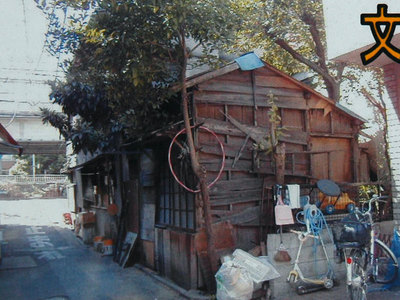
A closer view of the "old house." (click to enlarge)
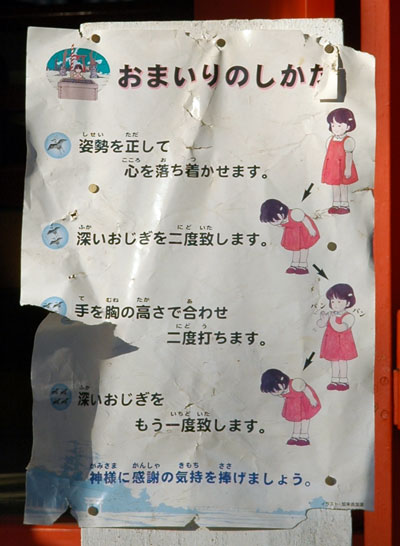
At a shrine next to a nursery school. Shinjuku-ku, Tokyo.
How to Visit the Shrine
- Straighten your posture and calm your heart.
- Give two deep bows.
- Arrange your hands at chest-height and clap twice.
- Make one more deep bow.
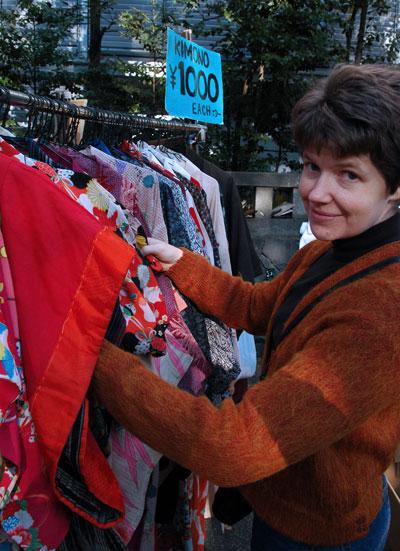
Looking for old fabrics in Harajuku.
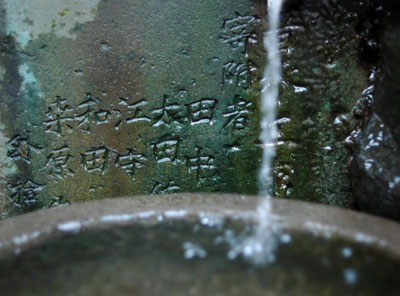
Unexpected beauty in Kohinata, Tokyo

Devotional candles. Asakusa, Tokyo
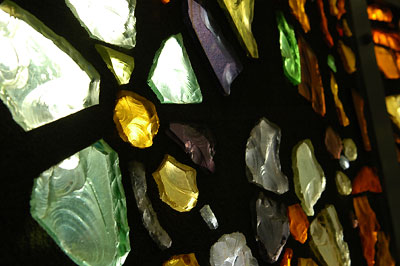
Dalle de verre glass in the Symphonic Scultpure, Hakone Open Air Museum
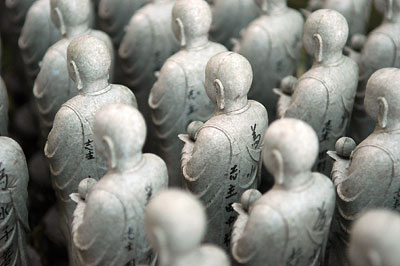
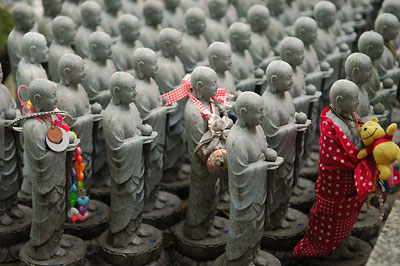
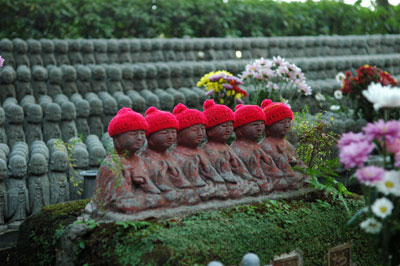
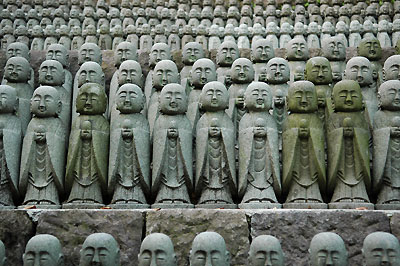
Jizo statues at Hasedera. 5 November 2004
Suddenly the evening light seems richer. Shadows appear where none were a month ago. It's intriguing; my eyes are opened to the play of dark on light. I've been trying to capture the essence of them.
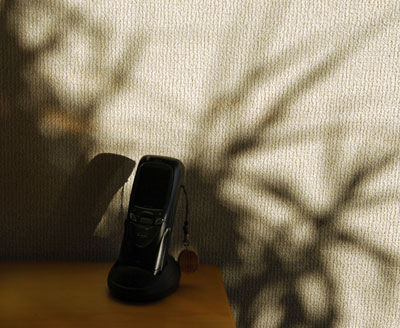
Still life with keitai
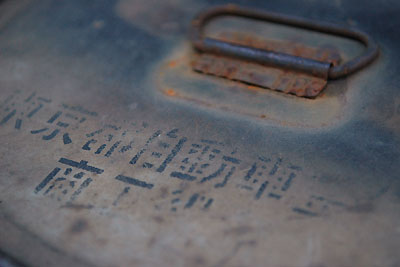
This abandoned oil drum sits amidst a pile of junk under Expressway No. 5 in Toshima-ku. I'm attracted to the rust and decay of Tokyo; there are plenty of pictures of dirt and oxidation in my collection. This is a recent one and a favorite.
Inspired by Antipixel (again) and his generosity in sharing a beautiful calligraphic screen photo sized as a desktop background, I've done the same.
1024 x 768 112 KB JPG.
1280 x 1024 196 KB JPG.
1280 x 854 (15" Powerbook) 156 KB JPG.
2560 x 1600 (30" Cinema Display) 660 KB JPG.
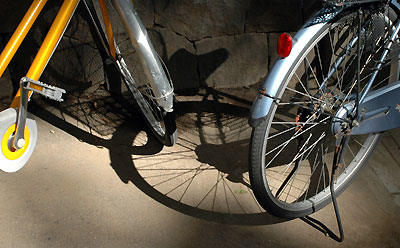
Bike shadows. Korakuen station, September 11.
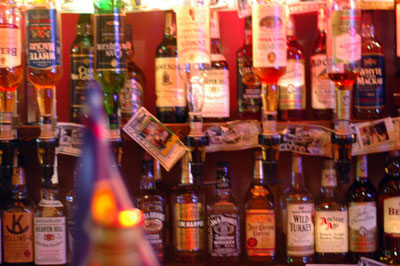
Shinjuku is well known for its exclusive little clubs and bars that are invitation only. The Golden Gai neighborhood, really just a handful of crisscrossing alleys, is stuffed full of itty bitty spaces for drinking and carousing. Imagine a hallway with doors on both sides and a few signs glowing above the doors and you're seeing Golden Gai.
Last night was the annual Golden Gai matsuri. About half the bars opened their doors to all comers and dispensed drinks at 2 for 500 yen until midnight--a good bargain for any Tokyo drinking establishment.
We tried out a few places with our friends Tracey, Ashley and Jamie. At Kura Kura we watched rhythmic gymnastics on a screen that took up an entire wall (it was a very small room); Kenzo's Bar, including Kenzo himself, was decorated in leopard prints; and Evi, one of Tracey's hangouts, was standing room only and kicked everyone out just before midnight--the bartender was getting cranky. We ended up at a karaoke bar called Champion where we sang until about 3 this morning.
Tracey, Ashley and I love to sing. Jamie fills in the chorus, but won't take the microphone. Tod shoots photos of us enjoying the evening. We singers took turns with the other patrons, but I think the three of us might have sung more than everyone else. It was a lot of singing.
Now I'm nursing a raspy voice (but no hangover) and it's back to work today. Ah, weekends.
A few pictures from Jo's camera to wind up the travelogue. Thanks, Jo!
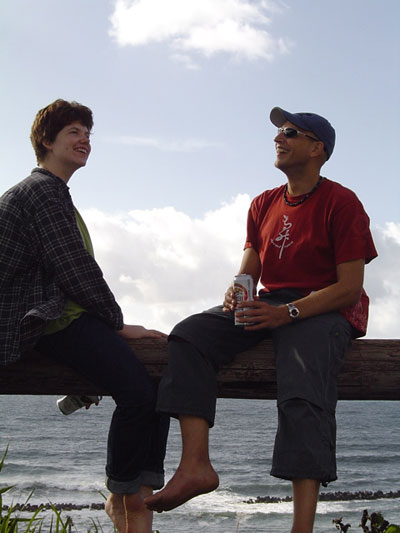
Me and Ashley sharing a laugh at the campsite. I look like I'm posing for a political poster.
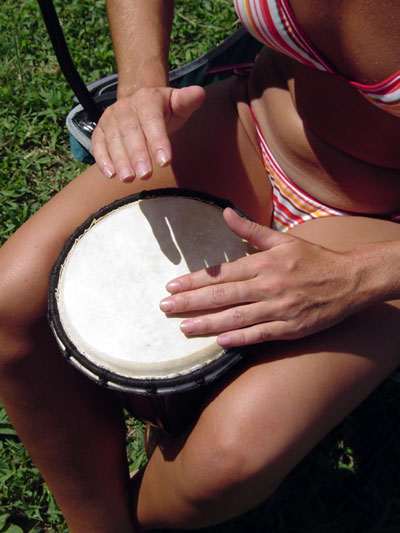
Sarah drums after breakfast. This is what the weekend was really all about.
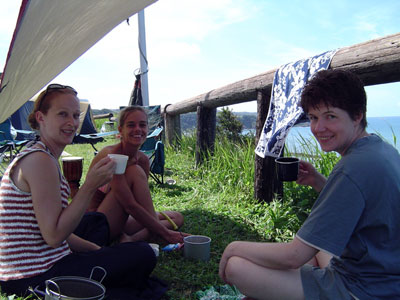
Enjoying a spot of tea.
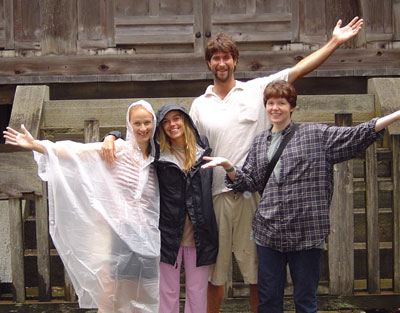
Jo, Sarah, Jonathan and me in the rain at Rengebuji Temple.
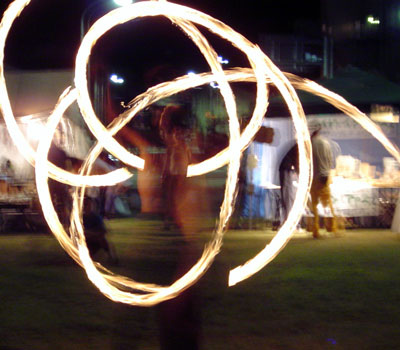
A fire dancer spins at the drumming circle after the evening concert.
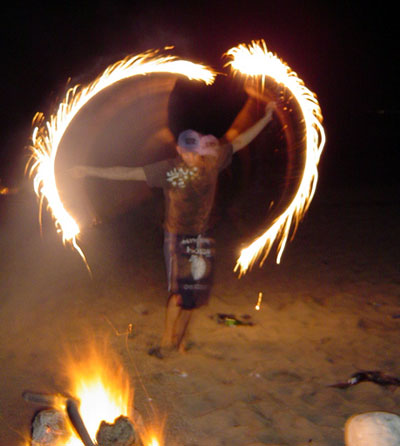
A tipsy Ashley interprets fire dancing with fireworks on the beach.
I've just returned from Sado Island, Niigata prefecture, where I attended the Kodo Earth Celebration. It was a weekend of camping, music and ocean.
If you have a chance to see Kodo play live (they tour all over the world), I recommend that you go. They are great drummers, versatile musicians and all-around superb performers. On stage they look like they are having the time of their life and the audience reflects their enthusiasm. They're coming to Tokyo in December and playing at the Bunkyo Civic Hall just down the road from me, so I'll get to hear them again soon.
The whole vacation was fun and relaxing. I'll try to backfill the details in the missing blog entries. But for now I'm off to bed, clean, dry and happy to be home.
I might be the only person who swims laps in the ocean. I woke early and went for a swim before everyone got up. Being a cautious soul, I didn't want to swim alone far from the shore so I swam out to the far side of the breakwater and did laps along its length for a while. The water had calmed down and cooled. It was a good energetic swim.
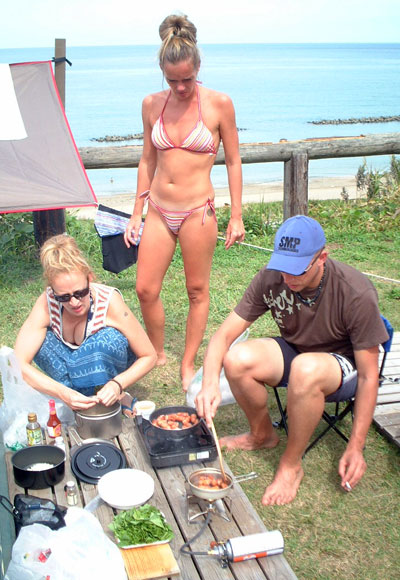
Jo and Ashley cook brunch while Sarah looks on
After brunch, we headed into town and walked over to Ogi no Yu, a local sento. We bathed for an hour, enjoying the ocean view from the bath, then relaxed in the massage chairs for a while. It was lovely to be clean.
Jo took our groceries back to the campsite while the rest of us lounged in town and had a snack, then we were off to the final concert--Fanfare Ciocarlia and Kodo playing together. There were 2500 people crowded into the hilltop park.
Who'd've thunk that you could combine taiko drumming with gypsy music? But they did it, proving that Kodo are extremely versatile musicians. One number nearly brought me to tears -- a duet/battle between trumpet and bamboo flute. Such different tones echoing and repeating the same notes and phrases. Breathtaking.
I think my favorite bit was two of Kodo's drummers, carrying one drum between them arguing whether rice or noodles were better food. It was a rhythmic comedy sketch.
Kitsune-DON, Curry-DON, Niku-DON
Kitsune-uDON, Curry-uDON, Niku-uDON
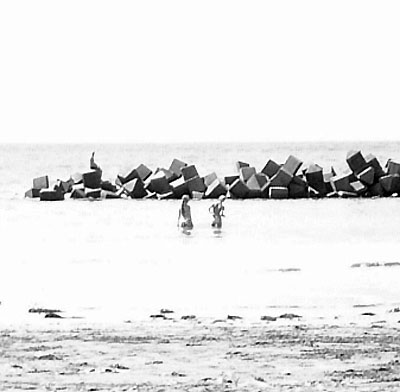
Jo and Sarah wade out to chat with Ashley on the breakwater. Sobama beach
We spent most of the day in the water or on the sand. The waves were still pretty big from the typhoon and there was lots of seaweed floating around, so we body surfed in the morning and bobbed around without actually doing much swimming. Still, it was very nice to be in water.
The evening's concert with Romanian gypsy brass band Fanfare Ciocarlia was an energetic dance fest. Despite announcements that dancers were to move to the side of the seating area, when the band leader said "Everybody dance!" 1500 people did for over an hour. I left with more energy than I came with, and a pulled stomach muscle in the bargain.

We arrived on Sado several hours later than planned, delayed by a typhoon blowing over. The train was late, the ferry cancelled. But it made no difference--everyone else was delayed, too--and we snagged the perfect campsite at Sobama beach overlooking the ocean.
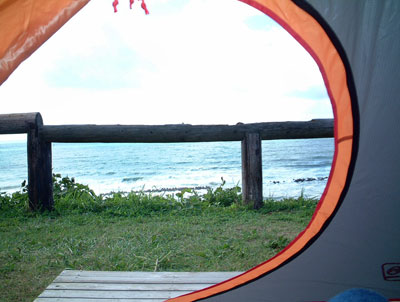

I've never owned a tent before; I don't camp too often. But this one is my very own. It's just the right size for me (they say 1-2 people, but you'd have to be two skinny people or very friendly). It has the best "genkan" I've ever seen--it's almost as big as the sleeping space.
With camp set up (5 tents, 7 people), we caught the bus into Ogi to check out the festival fringe events and food stalls before walking over to the Kodo concert. The storm blew the roof off the outdoor stage, so the concert was relocated in the municipal gymnasium. 1500 people sat on the floor--it's a large gym.
After the concert, I looked up. Ah! The stars are thick in the sky on Sado. The Milky Way is prominent in the sky. I spied all 7 of the Pleiades, the teapot, Cassiopeia, and the familiar constellations from my childhood. I could have gazed at the stars all night, but sleep got the best of me too soon.
On jtrains, a geeky train mailing list I read, someone asked how many stations are within Tokyo's 23 wards. Thanks to desktoptestu we now know the answer.
566 stations.
15 rail companies.
566 is a little bit misleading. Some stations are used by multiple rail companies and are counted once for each company. For example, Iidabashi station has trains from JR East, Tokyo Metro and Toei. So even though it's one station as far as travelers are concerned, it's counted thrice.
And here's the breakdown by rail company in order of number of stations:
Tokyo Metro: 132
Toei: 130
JR East: 75
Tokyu: 62
Tobu: 29
Seibu: 28
Keio: 25
Keisei: 19
Odakyu: 15
Keikyu: 19
Yurikamome: 12
Tokyo Monorail: 9
Tokyo Rinkai Kosoku: 8
JR Tokai: 2
Saitama Kosoku Tetsudo: 1
We often eat out, sampling Tokyo's vibrant restaurants scene. We travel all over the city in search of good food, so it's a nice surprise to discover a treasure in our neighborhood.
Indoshina specialises in Vietnamese cuisine with a smattering of other SE Asian flavours on the menu. I've walked past it dozens of times but it looks like a dive and we've been so disappointed in the Japanified Vietnamese restaurants we've tried that we've always given Indoshina a miss. But it turns out that it's quite good. A Vietnamese man runs the kitchen.
And boy does he know how to cook. We tried a spicy tofu and pork sautee, vinegar-dressed celery salad with peanuts, fried noodles and eggplant soup. The fried noodles were uninspired, but the other dishes were excellent. The soup, a coconut and onion broth with chunks of eggplant and pork flavored with lemongrass and shiso, was outstanding. The prices were reasonable, with each dish running about 800 yen.
Indoshina is on Kasuga Dori, just a few blocks from Myogadani station (towards Korakuen). The red, white and blue striped sign is in kanji that sound out in-do-shi-na but don't mean anything. There are pictures of the food outside, so you probably won't miss it. Open 5 pm til midnight on weekdays and til 11 pm on weekends.
Who spends the afternoon in a park? A variety of people and I spied on them all. You can have a peek in the Yoyogi Park People gallery.
People weren't the only ones enjoying themselves; light was playing in the fountain. Pretty.
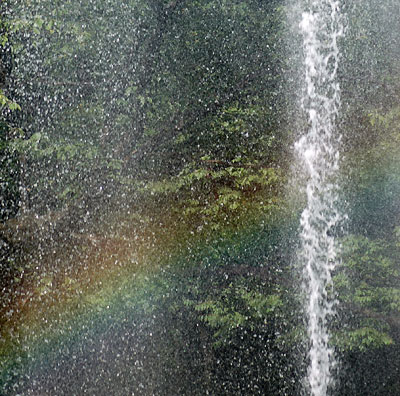
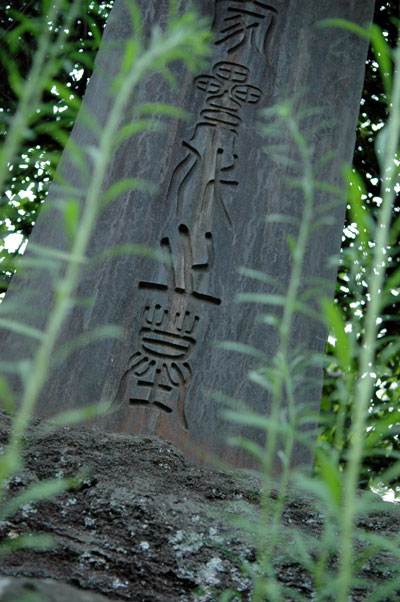
Tomb with weeds. Zoushigaya Bochi, Toshima-ku.
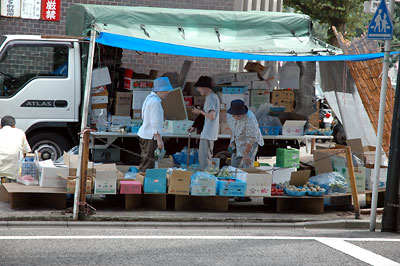
This vegetable truck parks on the corner across from Denzuin temple, creating a convenient market for the local ladies.
The owner chats up the aunties as though he were hoping to marry them all. But the first time I asked him a question, he answered in the rudest possible way and made me feel really stupid. I guess I'm not the marrying type. So I don't go very often. Really, who wants to be insulted while buying lettuce?
But I like the idea of the portable vegetable market. There's a fish truck man, too, who parks around the other corner. He's much nicer and once gave me a free grilled-squid-on-a-stick. I'll bet he thought I wouldn't eat it. Ha! I fooled him, it was delicious.
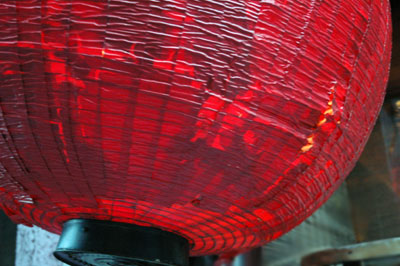
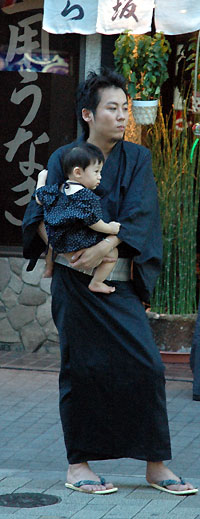 Kagurazaka is one of Tokyo's well known "traditional" neighborhoods. Despite encroaching fast food chains and convenience stores, it's still an authentic working neighborhood, not at all staged or quaint. Kagurazaka charms by its utter lack of pretense.
Kagurazaka is one of Tokyo's well known "traditional" neighborhoods. Despite encroaching fast food chains and convenience stores, it's still an authentic working neighborhood, not at all staged or quaint. Kagurazaka charms by its utter lack of pretense.
The sloping street leading from the station to the temple is lined with family owned shops and restaurants. The side streets teem with tiny bars displaying red lanterns for signs. Shop owners come out in the afternoon wet down the street and cool things off. Cats roam the alleys.
Many lively precincts like Kagurazaka are fading memories. There was a similar neighborhood feel in Koishikawa, on the other side of the river in Bunkyo-ku, but it has been wiped out by developers who snatched up the old 2-story storefronts and constructed towering luxury condo highrises. Where there used to be three streets of shotengai, now there are 7 or 8 giant apartment blocks. Ironically, they use the neighborhood's former charm as a selling point.
But Kagurazaka holds out for now. Walking through yesterday, we stumbled upon the annual matsuri and watched the awaodori dancers milling around before their performances and all of the spectators dressed in yukata. Although most of the people wearing yukata were women (young or old, but not too many in the middle years), a few men dressed for the occasion, too. A double dose of tradition to tide us over for a while.
Originally published in Epicure Exchange in 1997; photos taken on July 17, 2004
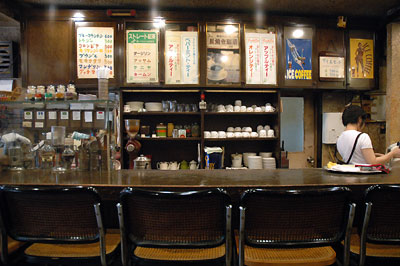
Unlike the dying breed of classic American coffee shops of the 1950s, the traditional coffee shop in Tokyo still thrives. These family owned coffeehouses, called kissaten (kee-sah-ten), have been around since WWII. Although most of them seem to have undergone a redecoration phase in the late sixties or early seventies, they haven't changed much since the forties.
Walk into a kissaten on a hot summer day and you are greeted with a cheery "Irasshaimase!" from the owner's wife, who tends the cash register and serves the coffee. Her liveliness is in contrast with her surroundings, which are dark and dank. An almost overpowering smell of mildew-- the residue from years of rainy season and hot, humid summers--wafts through the room as the door closes.
The interior is dimly lit and while each shop owner decorates to his (or his wife's) taste, dark wood and earth tones seem to predominate at most places. In this kissaten, the tables have grey marble tops, the heavy, wooden chairs have been upholstered in red velvet and the yellowing walls are strewn with clocks and landscape paintings of Europe. Lamps with hand blown globes hang at regular intervals down the corridor of tables that leads to the coffee bar.
This is not Starbucks. The coffee bar is made of wood, not laminate. It is standing height and the man who stands behind it tending the pots and grinders could never be called a barista. There is not an espresso machine in sight.
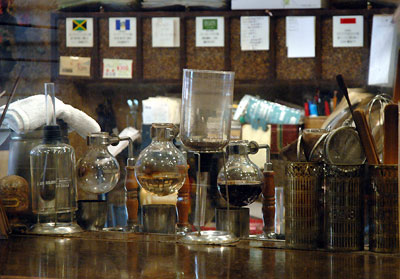
The tools of the trade look like equipment in an antique science laboratory. Arranged along the bar are a handful of gas outlets. Over each one sits a giant test tube holder with a glass bowl half full of coffee in its grip. A gas burner that would look at home in a kitchen keeps a kettle of water boiling. On a shelf behind the bar sits a group of brewing pots--a combination of glass receptacles and plastic filter baskets.
When an order is placed, the coffee man goes into action. He is fluid and artistic as he measures out and grinds an individual serving of coffee, simultaneously reaching for the brewing pot. Gently depositing the grounds into the filter basket, he carefully pours hot water into the apparatus, swirling the pot a bit to encourage the brewing, adding more water, watching until the coffee is just right. Then, selecting a cup and saucer from the mismatched collection that time has created, he removes the filter basket and pours the coffee into the cup.
His wife delivers the coffee along with a wood-topped glass container of sugar and a tiny pitcher of cream. For the price of 500 yen (about $5 US) you receive a cup of kohi (coffee), countless glasses of mizu (water) and a place to sit for as long as you like.
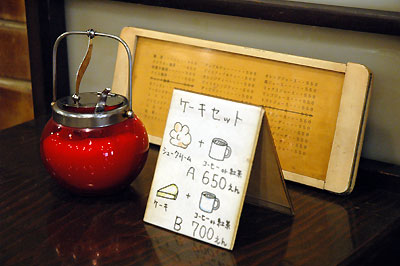
The emphasis in these coffeehouses is on "house" and not on coffee. The high price of coffee is as much a rental fee as it is beverage. Citizens of this crowded metropolis live in cramped quarters so alternate places to relax or work are essential. To find a kissaten that fits your mood and style is to find a second home; most kissaten boast a bevy of regular customers. Neighborhood wives take a break from daily chores and meet their friends for cafe au lait and gossip. Businessmen take refuge from the stresses of the office with a newspaper and coffee or come to vent midday frustrations with their coworkers.
The atmosphere of cool, damp, darkness keeps conversations quiet. Thoughts do not have to compete with blaring rock music and chattering schoolgirls, making the kissaten a good place to plan and work. For those in a solitary but uncontemplative mood, a shared library of used magazines and comics entertains.
When the coffee in the cup is gone, work complete, conversations finished, it is time to leave the cavern of coffee. Walking out into the hot sunshine is a pleasant shock. Across the street is an outlet of one of the coffeehouse chains. The coffee there is cheap and consistent, but the atmosphere is sterile and full of giggling girls and frantic commuters looking for a quick caffeine fix. How unenlightened.
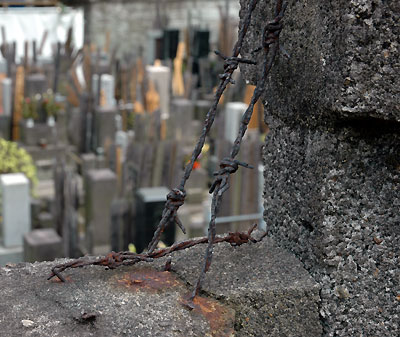
Cemetery wall, Bunkyo-ku
Does the barbed wire keep the ghosts in or the graverobbers out?
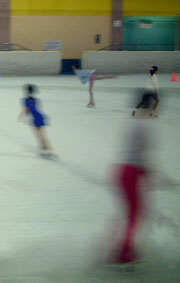 Jingu Skate Rink is an oasis in summer.
Jingu Skate Rink is an oasis in summer.
If you overlook the slightly choppy ice surface, unsharpened rental skates, and a few crazies on the ice, this is the best place to spend a 34 degree afternoon that I can think of. It's cool. It's athletic. And it's not too crowded on a Saturday.
We went yesterday. Tod hadn't skated in about ten years, but within minutes he was skating backwards and zipping around the rink. I can only skate forwards, a little shakily, but I loosened up after a couple of laps. Even with a wobble, I love to skate.
I turned around the rink with Lionel Belasco tunes running through my head, and the first few lines from Neal Stephenson's The Diamond Age
"The bells of St. Mark's were ringing changes up on the mountain when Bud skated over to the mod parlor to upgrade his skull gun. Bud had a nice new pair of blades with a top speed of anywhere from a hundred to a hundred and fifty kilometers, depending on how fat you were and whether or not you wore aero."
Later on, Stephenson describes Bud as "a little hinky on those skates" which is exactly how I see myself. Only I don't have the skull gun.
Info on the skating ring (in Japanese): http://www.meijijingu.or.jp/gaien/05.htm
14 August 1999
I was apprehensively cheerful when I woke. My next sleep would be in my own bed and I was looking forward to my own pillows and blankets--the first sign that I was ready to go home. But before I got to go home, I knew I was in for a difficult, emotional day.
Tod & I had discussed visiting Hiroshima many times. It�s an important place to visit. But we knew that it would depress us. I dreaded it. The horror of what happened during the war--and not just that war, that bomb, but all bombs, all wars--would affect me. Human stupidity at it�s very worst.
But the trip had to be made and when I planned the visit to Shikoku, it seemed logical to conclude it by meeting Tod in Hiroshima on the weekend. Get this out of the way, like a dentist�s appointment or a family reunion picnic.
Breakfast was a treat. We dined sitting on the floor of a beautiful lacquered and gilt dining room and the salted fish, rice, miso soup and pickles were so good that I momentarily regretted missing dinner the night before.
As we checked out, the woman behind the desk handed up each a little gift wrapped in a cone of tissue paper. They were tiny little mobiles made of peanuts painted to look like babies in swaddling. Odd but endearing. If we return to Hiroshima, I�m sure the New Kikusui will get our business again. And this time we�ll be sure to take all our meals.
We decided to stash our stuff in the coin lockers in the station which meant a detour but it wasn�t long before we alighted the street car at Genbaku Domu, the A-Bomb Dome.
Before the bomb, the building had been the Industrial Promotion Hall. After the bomb it was one of few structures left standing. You�ve seen pictures of it, I�m sure. Its domed top is a framework of curved iron; brick and stone walls are partially erect; empty windows give clear views through the ruin to the park on the other side. Huge chunks of carved stone look as if they were artfully arranged on the ground where they fell. It�s a powerful symbol. An icon.
And as an icon, I thought it would be dismissable. But it wasn�t. It was big and solid and not a photograph. It was real. Tod & I walked slowly around it and talked about it--what it looked like now. What had happened to it. I took some photographs but neither of us wanted to be photographed next to it. This was not the sort of place where we wanted to capture our visit.
The Peace Memorial Museum was on the other side of the park so we left the dome behind us. We hadn�t walked very far before I was attracted by a small crowd of people near a monument and the sound of a recorded announcement. We went over to have a closer look.
This was the Memorial Tower to Mobilized Students, we learned, as we stood back and listened to the English announcement. During the war, Japanese children over the age of 12 we drafted to work for the war effort. They held factory jobs, or farmed or ripped down buildings to create firebreaks. And when the bomb dropped, many thousands of them in Hiroshima died. Difficult to imagine, isn�t it? But thinking about it made my eyes fill with tears. So unjust.
The Peace Park is filled with monuments, both major and minor, to memorialize war victims in groups or individually, to recognize the suffering of the bomb�s survivors, to promote peace, to serve as reminders of what happened. By the time we reached the museum at the other end of the park, we�d passed by dozens. There were too many to look at but we paused in front of the main ones: the flame of peace which will burn until all nuclear weapons are disarmed; the arched cenotaph through which you can see the flame and the dome; and the children�s peace memorial with its legion of origami cranes arranged in neat rows and huge piles at its base.
A legend that says if you fold a thousand paper cranes, your wish will come true. Ten years after the war, a girl named Sadako had contracted radiation-induced leukemia. She folded paper cranes in the hope that if she got to 1000 she would be cured but she did died before reaching her goal. Today the cranes symbolize peace and are seen all over Hiroshima. People fold them and send them from around the world to be placed near the monuments. They are brightly colored and add a strange air of festivity to the somber reminders of the past--like party decorations at a funeral.
Guidebooks recommended a half hour to an hour at the Peace Memorial Museum. Tod & I were there for four hours and could easily have been there for longer. After paying our 50 yen admission (about 40 cents), we were pointed toward the special exhibits in the basement.
A week previously, at Aono-san�s parents� house I had watched the annual Hiroshima memorial ceremonies on TV as we ate breakfast. The mayor of Hiroshima gave a speech and two middle school children, dressed in their school uniforms mounted the steps of the podium in lockstep and delivered a speech in unison. The speeches, which I understood little of when broadcast on TV, were on display in the exhibit room. I read the translations and they were powerful cries for Peace on Earth.
The mayor had solicited letters from foreign ambassadors in Japan and they, too were on display. It was fascinating to read them and discover the range of views on atomic weaponry and world peace. Of particular interest were those from India and Pakistan, displayed at opposite ends of the room as if they would somehow cause damage if near one another. In these letters, each ambassador blamed his neighbor for starting the arms race that the countries are now in. I noted that the American ambassador had not replied to the mayor.
We were fortunate to be in town at the same time as a collection of printed materials on loan from the University of Maryland. It was a fascinating and disturbing illustration of censorship in Occupied Japan. I learned much about the power of media control and invisible censoring that morning. There were so many things the Japanese were not allowed to write about--the bomb, it�s aftereffects, food shortages, the Emperor, disparaging or even questionable comments about the occupying forces, the command structure of the occupational government and of course, censorship was not allowed to be mentioned whatsoever.
I wondered if all this was the right thing? The censoring department helped promote stability, I suppose. It absolutely shaped Japan into what it is today. I doubt the average American of my generation really understands what an influence America was on Japan in the early 1950s. From politics to fashion; Japan was inundated and never had a chance to escape it.
My brain was reeling and we weren�t even out of the basement yet. A gallery of paintings and drawings done by A-bomb survivors and one that talked about the impact of the war on children--from the bomb to the years of occupation and beyond--filled the rest of the halls downstairs. We learned about the how orphaned children survived; how schools were back in session by October, how rationing during and immediately after the war stunted children�s growth.
The museum, on alternate Wednesdays (which our visit was not), mixed up a batch of the powdered milk which was the entirety of children�s school lunches in the time immediately following the bomb. �Come and try the nostalgic taste of powdered milk so many children drank at school� a sign read.
Two hours in the basement and it was time for a break. In the tiny cafeteria on the first floor, I had a bar of red bean ice cream and Tod had a cheeseburger from a vending machine that conveyed the refrigerated burger through a microwave and dispensed it steaming hot for your eating pleasure. Tod said it wasn�t bad. I mused over the irony that the technology which made Tod�s hot snack possible in the peace museum had probably originally been developed for the military.
Finally we were ready to tour the permanent exhibits. It was crowded and dimly illuminated on the first floor. Two large dioramas took center stage. One showed Hiroshima before and one after the bomb. An old man talked over his wartime experiences with a green-jacketed docent and some teenage visitors. He pointed to places in the diorama and talked in a croaky voice while people gathered around him and nodded solemnly.
The museum had a message to convey--No more Hiroshimas--and it did its job well though was sometimes a bit heavy handed with descriptives.
They told the story of Hiroshima before the war, during the instant of the bomb and for the years after the war with photographs, maps, simple explanations of the technology of nuclear weaponry, political aspects to nuclear disarmament. Why Hiroshima was the target and why drop a bomb at all were briefly explained.
What I found most disturbing were the �material witnesses.� Scraps of clothing, watches stopped at 8:15, charred lunch boxes, half melted belt buckles and other personal belongings were accompanied by short biographies of their owners and the date and time of their death along with, in some cases, how far from the hypocenter the item was found. Some of the stories were tragic.
In too many cases, people survived the initial blast but were grievously wounded and died within a day or two after making heroic treks home from the city. One teenage boy who had been working in the city was burned over a huge portion of his body but managed to walk kilometers to reach home. His skin was peeling in strips from this wounds and his fingernails fell off. When he died later that day, his mother kept the nails and bits of flesh to show his father who was in the army and not at home. Now we all get to see the gruesome reminders.
It was difficult to read all these, but at one point, after seeing the twentieth or thirtieth uniform blouse of a teenage girl or charred work pants of an old man, I thought I was getting numbed to it. The individual stories were blurring together and I was relieved to see that I was nearing the end of the exhibit. Then I came to the tricycle.
The battered red tricycle was owned by a three year old boy who rode it every day and loved it the way little kids love their favorite toys. When the bomb went off, he was riding outside. He was killed instantly and the tricycle was mangled. His father buried them together in the back yard so that his son would have his best friend nearby and would not be lonely. That got me. Tears slipped down my cheeks and I hurried away to find Tod who had gotten ahead of me.
Fortunately there wasn�t much more of the museum to cover and we dispatched the melted bottles and roof tiles quickly and with a minimum of emotion. The shadow of someone sitting on the granite stairs of a bank wasn�t nearly as powerful as I thought it would be. It looked like a blotch of dirt and not a human shadow.
Regardless, it was a draining experience and we both felt limp and exhausted when we left. It was 2:30 and we were hungry. We had three hours before the train was scheduled to leave so we wandered around the town. We could have visited the castle or one of the art museums or any number of non-atomic sights but lunch and a fruitless search for English books occupied us instead.
I�d like to return to Hiroshima. Despite the parts I�ve described, it�s not a solemn place overall. It�s a typical Japanese city with big, ugly ferro-concrete buildings, museums bursting with artworks, a baseball team called the Carp, a zoo, many gardens and even a manga library. Now that I�ve toured the grim but important part of Hiroshima, I would like to experience the rest of it.
Maybe someday. But for now I need a rest.
13 August 1999
Tod was scheduled to arrive at Hiroshima at about quarter to one in the afternoon and I had no intention of running around to see things without him, so my morning was relaxed. I caught the 11:00 train to Hiroshima and arrived with plenty of time to scope out the coin lockers, load up on brochures at the tourist information desk and even to have a cup of coffee.
All my free time pointed out a delightful opportunity of good timing (finally!). While sipping my coffee and reading the tourist brochures, I discovered that Miyajima, a small island that was the destination for the next day, was holding its annual hanabi (fireworks) festival that night. So if we adjusted our itinerary we could see Miyajima�s today and visit the Hiroshima sights the next day. Which we did.
When Tod�s train came in, we went off for lunch. Hiroshima is known for two delicacies: oysters and okonomiyaki. Oysters are not my favorite food, so we opted for okonomiyaki for lunch.
Okonomiyaki is something like a pancake or a frittatta. We�d eaten them in Tokyo, but only at a fancy Ginza restaurant where the staff did the cooking. In the rest of Japan, okonomiyaki is a participatory experience.
We were seated at a table with a grill in the middle. Tod figured out the menu quickly and ordered two bowls of the basic �stuff� which included batter, eggs, cabbage and strips of pork, then added some extra toppings--garlic, rice paste balls, mushrooms. They arrived and I realized I had no idea what to do next! I looked at the waiter with a questioning look in my eyes and a little shrug, and mimed turning the bowl over onto the grill.
He was aghast. He kneeled at our table and explained the correct method for making okonomiyaki. Remove the pork strips and sit them on the smaller of the two paintscrapers that were out implements. Mix the remaining contents of the bowl and add the extra ingredients. After things were well mixed then the contents could be poured onto the grill. The larger spatula was used to shape the runny edges into a neat circle. When the pancake was golden brown on one side, the pork was laid on top and whole thing was flipped with the larger spatula to cook on side two.
He left us to cook but returned frequently to give us more water and watch our progress. He even corrected our mistakes. The result was delicious and the cooking was fun. Fully stuffed, we were ready to face our next challenge--an early check-in.
Our hotel was a traditional Japanese hotel with a good recommendation but a 4:00 check-in time. If we wanted to be on Miyajima in time to see the island and find a reasonably good place to sit among the crowd, we�d have to be there by late afternoon. So we headed across town to explain our predicament a few hours ahead of the check-in time.
They woman at the desk was understanding, took our bags, gave us advice on reaching Miyajima and even dug up some English language maps. But the price of our stay at the New Kikusui included a dinner we would not be able to eat and there was no refund. That was OK, though. We chalked it up to the price of changing plans at the last minute and went on our way to Miyajima.
The journey from the hotel involved a streetcar, a train and a ferry and took about 45 minutes. The ferry was filled with young women in yukata with their hair arranged in upsweeps and held in place with hair accessories ranging from traditional lacquer combs to Hello Kitty barrettes.
Two brightly blonde American girls, dressed in yukata and sitting with a group of Japanese girls similarly costumed and coifed, carried on a loud conversation about the immaturity of one of their American associates. I gathered that these two, and their absent companion, were exchange students or very young English teachers. Fortunately, they and their cortege vanished into the crowd as we disembarked and they scurried away towards the shops.
Because I had an agenda. It�s sort of a pain to have to see the sights when you visit somewhere. I planned to incorporate Miyajima into a story I would write for a magazine when I got back home, so I needed to check out and photograph as much as I could while I was there: the (inevitable?) ropeway to the top of Mt. Misen, the sacred forest and its wild monkeys; the view from the hill, the treasure house.
And of course, the most famous sight on Miyajima, Itsukushima Shrine is one of the Three Most Beautiful places in Japan. It sits on pilings at the water�s edge and at high tide it looks like it�s floating. The huge red torii gate sits further out in the sea and is an often photographed landmark--almost an icon of Japan.
Japan is full of �Three Most
Anyway, here we were at one of the Three Most Beautiful places in Japan and it was not living up to our expectations. First of all, the tide was out, so the shrine and its gate were not floating on water, but mired in mud. Then there were the deer. Very tame, miniature deer roam at will charmingly chewing on trash and tourists snap their photos. They are adorable, but the island at low tide has a distinct scent of deer urine.
But we were going to brave it all. Tod was feeling tired and had a headache from his trip. But there was a bus outside the ferry pier that Tod said would take us to the ropeway station halfway up the mountain. It would save us the fifteen minute uphill walk. We hopped on and a few minutes later found ourselves halfway around the island at a beach. Not the ropeway station. I tried to make the best of it and snapped a couple of photos to commemorate our error and we hopped on the return bus.
Tod�s headache was getting worse and the sun was just beginning to go down--we wouldn�t have enough time to reach the summit of the mountain, shoot photos and get back down in time to get a good vantage for the fireworks. So we abandoned everything but the fireworks and walked off in the direction of the shrine. The hanabi would be launched from barges in the water on the other side of the torii.
We walked through the makeshift festival arcade and scoped out the food options. Although still full from our late lunch, we knew that our stomachs would eventually start to grumble. When that time came, we passed up the traditional Japanese grilled whole skewered squid, the bits of octopus tucked inside a ball of batter and fried, the fried noodles. We went straight for the �familiar� foods--french fries and American Dog which you will recognize when it�s described as Corn Dog on a Stick. So much for going native...
Finding a suitable place to watch the fireworks was a challenge. The photographers� tripods had the best views of all. The clustered between the shore and the torii facing the barges where the fireworks were waiting for dark. These photographers would get great shots of the gate silhouetted against the fire flowers in the sky.
Other photographers preferred a flanking view. No matter where we tried to stand or sit there was a photographer in front of us. I was wishing I had a tripod of my own. But I didn�t and the dozen or so photos I attempted that night look like fireworks in an earthquake!
The fireworks were incredibly beautiful. Japan knows how to do hanabi. All summer long you can see fireworks on the weekends and not the 20 minute Independence Day show at the park, but sixty to seventy five minute extravaganzas. Beautiful, huge loud displays. The Miyajima hanabi were especially beautiful and designed for those photographers. High circles of white and pale colored exploded above water level fountains of sparks. After a few minutes of action, the show paused for the smoke to clear and then began anew. Each set was more spectacular than the last.
Eventually it ended and we threaded our way back to the ferry. I bought a candy mekan--like a candy apple but a mandarin orange instead of an apple. A deer was stuck in the middle of the surging crowd. Confused and frightened, he was trying to back his way out of the crush of people but instead, backed into Tod! We reached the plaza outside the pier and stood in line with the thousands of other people who wanted to get back to Hiroshima. It took more than an hour to get on the ferry for our five minute ride across to the mainland.
Exhausted by the time we reached our hotel, we asked for our key and got into a conversation with the man at the desk who had lived in Tokyo for a number of years and knew our neighborhood. That was nice, but really I wanted to go shower (I hadn�t had one since 9 that morning!) and collapse into bed.
I was so tired that I couldn�t� find the towels or the yukatas or the bars of soap that were neatly laid out on a lacquer tray and tucked into our closet (I found them in the morning). I showered with leftover soap I�d carried with me, used a washcloth to dry myself and fell into my futon. Tomorrow would be the last day on the road and I was looking forward to being finished with traveling.
12 August 1999
Traveling is sometimes a game of chance. Having rolled snake eyes on the previous day�s activities, I woke up with a desire to leave Innoshima with all due haste. Maybe I could improve my game back on the mainland.
And so I did. I was bathed, breakfasted and checked out of the Hotel from Hell in time to catch the 7:40 bus to Onomichi. I had no intention of following through with my original plan of cycling the 20 km across the final two bridges. Air conditioned comfort and views of Setouchi from the fast lane were what I wanted and exactly what I got. I arrived at Onomichi Station at 8:30 am.
But I hadn�t planned to spend much time in Onomichi--it was more of a bed and breakfast stop than a day�s sightseeing destination. I had no idea what I�d find there to occupy my day. My entire Onomichi research consisted of the mimeographed map given to me by the travel agency which showed where I was staying for the night.
The station map indicated that there was a nearby castle park, so I walked down the street in the direction of the ropeway that would carry me to the top. Maybe I could stretch the park to fill my morning; I�d figure out what to do with the afternoon when it came.
The ropeway at Onomichi was much quainter than that at Tokushima. People crammed into the car until it felt like a Tokyo train at rush hour. at precisely 9:15, the car, stuffed with two dozen sweaty riders trying to fan themselves without whacking their neighbors, began it�s slow ascent. We traversed a shrine, glided past a pagoda and were deposited at the top of the mountain in a few minutes.
I had picked up a bilingual area map at the ropeway station but the crowded compartment had prevented me from unfolding it. Now I sat on a rock wall and spread it in front of me. I sipped on some warm tea and nibbled leftover Oreo cookies from the previous night�s orgy while I studied my options.
Onomichi is nestled in a curve of shore between the mountain I now sat on and the inland sea I had just crossed. Its nearest island neighbor is a two minute ferry ride across a narrow stretch of sea that looks like a river. It is a port town so ferry terminals and docks with huge cranes dot the water�s edge. I could see all of this from my vantage point atop the wall on the mountain. In the distance, I could see hazy mountains of farther islands poking out from a shiny glaze of water.
But returning my gaze to my map, I discovered that I was not the only one to be taken with the beauty of the scene. I was sitting at one of the �Vantage Points of Famous Painters� that were marked by stars on the map. Looking around, I saw a little plaque about a half a meter away that said the same thing, only without the star and the English. I don�t know who he painter was, but I could appreciate his taste in viewing points. Another dozen stars were scattered around the map. I decided to try to take in as many as I could.
Also marked on the map were two walking routes--the Road Way of Literature and the Round of Old Temple. According to the map, the Road Way to Literature began almost where I was sitting. I looked up and turned my back to the view to see what was around me.
I had missed noticing the two-story circular observation platform when I alighted from the ropeway, but there it was, squatly topping the height of the mountain. Signs pointed the way to cobblestone paved paths leading to the town�s art museum and an amusement park. In the opposite direction was the Road Way to Literature and a temple. I opted to begin with the Road Way to Literature.
The Road Way is a hiking course that starts down the hill away from the ropeway then snakes behind the pagoda I�d passed on the way up and winds its way back up to the top of the mountain. The Literature part takes the form of 25 stones inscribed with poems. Many of the poems seemed to have an outdoor theme and some were specifically about the mountain and Onomichi. I surprised myself by being able to read a few of them from start to finish. The calligraphy of the inscriptions was supplemented by a nearby sign neatly printed and including furigana, the spelled out readings of kanji often seen in children�s books.
Along the trail were several more of the Viewpoints of Famous Artists. They must have painted lovely pictures of the mountains and sea, though I suspect that they completed their works before the hulking orange and white cranes in the harbor got in the way.
Heading downward along the Road Way, I visited the vermilion pagoda. It was lovely and shady and I stopped for a few minutes to admire yet another view over Onomichi.
To worship at a temple, you must summon the attention of the deities that are housed there. Normally this is done in one of two ways. A Buddhist temple, you clap loudly in front of the shrine before bowing. At Shinto shrines, you ring a bell fastened above the offering box. But at this shrine was a novel noisemaker.
Instead of a bellpull over the offering box there was a long rosary of grapefruit-sized wooden beads on a pulley. The beads filled all but the last meter or so of rope that strung them together. I was attracted to the sound and watched from a safe distance to see how it was done before trying it myself. Pulling on the loop caused the beads to fall from the top of the pulley to land on their mates below. They made a lovely clacking sound. One bead was painted red to mark the end of a full circuit. People who had done this before were able to keep the flow of beads evenly tapping the whole way around. My attempt was a bit uneven but pleasurable nonetheless.
After the pagoda, the Road Way angled back up to the top of the mountain and ended near the art museum. Unfortunately, the art museum was closed in preparation for a showing of �Water Painting in connection with Onomichi� scheduled to open the next day. Once again, I was a victim of bad timing.
But it didn�t really matter. I wandered over to the edge of the mountain where the keep of the old castle was perched. It was a classic white walled, winged roofed castle of the style which figures prominently in samurai movies but that was destroyed throughout Japan when the feudal period ended and the Meiji era began. There are still plenty of castle remnants around, though. I can only imagine what the countryside looked like before the end of the 19th century. So many castle towns!
A bamboo forest shaded the path leading off the mountain away from the castle. I followed it and end up not far from the station. It wasn�t quite lunch time yet, so I opened my map and decided to follow the Round of Old Temple for a little while. It would lead me in the direction of the shopping arcade near the ferry terminal which promised to have a good noodle shop or two.
The Round of Old Temple was a long winding route up and down grey, shell patterned stone paths and myriad steps. It wound its way from one end of town to the other and took the diligent walker to almost two dozen beautiful old temples which had survived the war, earthquakes and centuries of time. Unlike many of the famous temples in Tokyo and other big cities, these had not been firebombed and reconstructed.
The street, a narrow pedestrian lane bounded on both sides by the garden walls of the housed that faced it, radiated heat that the local cats napped in. The cats in Onomichi are friendly, like the people, and whether perched on a garden wall or curled up in the shade of a garden gate, they purred appreciatively when rubbed behind the ears. I walked along, collecting an overdue quota of cat-petting as I made my way from on the Round.
At one of the temples I visited, I found yet another opportunity to incorporate pottery into my travels. I sat on a bench in the shade of an eaves and watch people walking past me on their way to the cemetery. The neatly swept dirt courtyard in front of me ended in an old-style temple hall. But outside the hall a middle aged couple were sitting on zabuton cushions at a low table and they seemed to be making something from clay. I watched for a little while, but couldn�t figure it out. I wasn�t even sure if they were associated with the temple, or just visiting like me.
As I smoothed a bit more sunscreen over my arms and nose, the gentleman and his wife stood to leave, bowed to a woman in the door way and headed towards me. The wife turned and went to pray at the temple; the man sat at the other end of my bench. He smiled at me, we exchanged pleasantries in Japanese and then, in broken English, he said �Hand Buddha. You can make it.�
So that�s what they were doing. making Buddhas. It didn�t take me too long to debate whether to try it myself and I was sitting on a zabuton a few minutes later. A woman in an indigo blue work kimono greeted me and smiled when I said I wanted to make a Buddha.
She apologized for not speaking English and proceeded to instruct me in the proper way to hold the cylinder of clay and squeeze it to form the Buddha�s head and fingerprinted body. I pulled ears and a distinctly Western-looking nose from the clay and with a bamboo skewer incised the remaining details.
When two junior high school girls came to sit at the table opposite me; the woman looked relieved. Did one of them speak English? They giggled, as teenagers around the globe do, and said they did not. However, when we got to a sticking place in the instructions, they knew the right English word to enlighten me.
Buoyed by this exchange and activity, I walked on to the next temples. On the way up a long flight of stairs, I saw a sign pointing the way to the Mansion of Literature Onomichi. That seemed like a fitting extension to my earlier Road Way of Literature walk, so I turned and went up the side path to a little house.
I could see people inside reading, I almost didn�t go in since my Japanese reading skills are on a par with my spoken Japanese. I was sure that this place might hold more embarrassment than joy for me. But as I stood there deliberating, someone came out and that sealed my fate. It was air conditioned in there!
The man who took my admission fee apologized for not speaking English (maybe this should be an unofficial Onomichi slogan) but then proceeded to explain to me, in English, what the museum was all about, and that there was a second part of it up the hill and around the corner. This part of the Mansion of Literature had been home to one of Onomichi�s celebrated writers. I perused the manuscripts in the glass cases, looked at the giant painted gourds on display and gawked at the beautiful view from the window of this writer�s study room.
But the house was only three rooms, so after a few minutes, I was back on the path upwards to find the other half of the Mansion of Literature. I took a momentary wrong turn and considered giving up and going back down into town for lunch. But I knew if I was this close and I didn�t find it, I probably wouldn�t bother to try again after lunch. I persevered and after turning myself in the right direction, found the other half.
A chorus of �I�m very sorry but I don�t speak any English� greeted me at the door as the counter man exchanged my ticket for a bookmark with the museum�s logo. I wandered through several rooms of displays looking at the momentos of writers, playwrights, poets and songwriters. A shamisen. Fountain pens. A pair of wire rimmed glasses. A tea service. And on the walls were photographs of the writers and their brief biographies.
I was puzzling through some of these when an old man approached me and asked (in English) if I was interested in Japanese literature.
When I expressed an novice�s interest, he was delighted and gave me a personal tour of the museum, explaining who the authors were and what they wrote. His particular favorite, and I gather the most famous of the Onomichi writers, was a woman named Fumiko Hayashi. I had seen a statue of her in the town square earlier that day.
Takagaki-san, my self-appointed escort, told me all sorts of stories about her as he lead me through the rooms devoted to her writing and her momentos. He told me about the years she lived in Onomichi and how she eventually moved to Tokyo. Her house there is now a museum. I told him I would be sure to find it and visit.
�Do you read Japanese?� he asked. I said I could read a little bit, and he asked me to see if I could read the read the postcard she had written to her six year old son while he went off to look for something for me.
He came back with a photocopy of the Tokyo museum�s brochure which included the address. We talked for a while longer and he said he would send me a copy of Shitamachi, one of her short stories that had been translated into English. Profoundly grateful for this incredible kindness, I wrote down my address.
Takagaki-san confided in me that he has translated 720 Japanese songs into English. �Just for a hobby,� he said. I suggested that they would make a very interesting book with facing pages of the Japanese and English lyrics along with the musical notation. He demurred, saying that he didn�t think there would be anybody to buy it. But I�m not so sure. You don�t see bilingual books like that very often and they can provide good insight into the natural use of both languages.
Eventually, I took my leave and started down the hill to have lunch in the shopping arcade. But before I�d gone two hundred meters, I stumbled across a cafe terrace with an unparalleled view of the water and the mountains. It wasn�t marked as a Viewpoint of Famous Artists, but it should have been.
The proprietress was a liaison for AFS (American Field Service), an international exchange program, and had spent lots of time outside Japan. Although she understood and spoke English perfectly, she knew the value of speaking to me in Japanese. So I stumbled along and got further beyond the four question conversation than I ever had previously. She coached me when I erred and my half hour sitting in the shade of her trees listening to the cicadas and chatting was very pleasant.
Lunch ended up being really late and by the time I�d finished it was time to check into the hotel and have a shower--my favorite time of day!
Onomichi held more delights in store for me. Marked on my map was something labeled Tile Street near one of the temples on the Round of Old Temple. I wanted to see what this could be. It turned out to be a tiny alley which someone had paved with cement and colored tiles laid in patterns. The walls of the alley were covered with wooden frames holding bathroom tiles onto which visitors had penned their wishes and thoughts. Tile Street didn�t hold the allure of Bangkok�s flashy tiled buildings, but it drew a fair crowd of people regardless.
I wandered around on the Round and saw a few more temples, even going so far as to climb up an overgrown staircase to get a view of the pinkening sunset sky with a pagoda in the foreground. But eventually it turned dark and after a promenade up the shopping arcades, I settled in for dinner at a pizza restaurant with a wood fired pizza oven and two independent women entrepreneurs.
After dinner, I holed up in my room with the television. Since we don�t have one at home, I was enjoying the opportunity to watch some of the silly Japanese shows. Variety shows with guest stars taking on silly challenges while dressed in bizarre costumes filled my evening. Tomorrow, I would catch a train to Hiroshima to meet Tod and begin the final leg of my trip.
11 August 1999
To say I was a bit high strung when I woke up is an understatement. This was the big day...biking 40 km from Imabari to the island of Innoshima in the middle of Setouchi�the Seto Inland Sea. It would be a test of my endurance, my biking ability, my will power.
I had another round of bathing at the hotel and my first Western breakfast of the trip. Sausages, scrambled eggs, toast, fruit, yogurt and coffee. Plus a salad with a shrimp and a raw scallop (even Western food has a Japanese flair).
I went to the station and caught the first train to Imabari. It was a �one-man,� a local diesel train with only one car and the eponymous one man at the controls. Although I had never encountered a one-man in Tokyo, where all trains are six to fifteen cars long and have conductors plus drivers, they are the norm for local trains in Shikoku.
But they are slow. The trip which took 30 minutes on the express train the day before was stretched to 75 minutes on the one-man. Giving me more time to fuel my morbid fears about failing at my task and being driven off the bridge by a passing truck or falling off my bike and breaking a limb and having to explain in Japanese to the hospital staff what�s happened to me. So by the time I got to Imabari I was even worse than I was when I woke up.
But dammit, I was going to do this. I was determined (or maybe just stubborn) and I knew that riding a bike over some bridges really wasn�t outside my capabilities. No matter how morbid my imagination was painting the scene, I could do this.
Shimanami Kaido is a series of seven bridges that span ten islands from Shikoku to Honshu, Japan�s �mainland.� This bridge route has been under construction for ten years and the final bridge was finished this April. So this summer there are a number of events taking place on and around the bridges-�walks, bike rides, marathons, special island-based events.
I was armed with the locations of the cycle rental terminals, the name and length of each bridge and I had planned my course to take me as far as Innoshima where I had a reservation at a hotel that night. Now all I needed was a bicycle. Crossing over from the Imabari train station, I checked in at the bus terminal.
�I�d like to go to Itoyama Events Site.� I explained to the ticket woman.
�Ah, I see. Are you going to rent a bicycle?� she asked.
�Yes, I am riding to Innoshima today.�
�Oh! That�s a long way. You must be very athletic. But I�m afraid the next bus doesn�t leave until 1:20 this afternoon.�
�Really? That�s a very long wait, isn�t it? Well, I�ll buy a ticket now, thank you.�
I was going to have to wait almost three hours for the bus. This did not bode well, as I�d planned to be on the bridges by noon at the latest. I was getting used to a slower pace than back home in Tokyo, but this was too slow!
I walked away from the terminal and back towards the train station. Although I wasn�t hungry, maybe I could fill some time with a coffee or a snack. As I passed through the driveway , my eye was caught by a sign at the taxi queue that listed the fares to nearby tourist destinations. Although the cycle terminal wasn�t listed, I ventured to ask the taxi driver how much it would cost to go to the cycle terminal. The 1600 yen fare he quoted was definitely worth saving three hours! I got in and we were at the rental shop in 20 minutes.
I filled in the rental forms and paid for my bike. I could rent it one way as far as Omishima, about 25 km away. Then I would have to turn it in and rent another one-way cycle to the next renal shop. To make it all the way across the bridges from Shikoku to Onomichi on the mainland would take four or five rentals.
However, when I was told that the only bikes left today were three-speed shopping bikes with bell and basket, I was glad that I would have to change bikes. I picked up a map of the bridges that included not only details of the distances, but schematics of the cleverly designed bike and pedestrian interchanges that minimized the slope to each bridge by creating curlicues and vortices of roads leading upwards.
I hopped on my bike, tested the brakes, and was off. The first thing I did wrong was to go up the motorbike ramp. I didn�t know the kanji on the signs so I couldn�t tell which way was for bicycles and which for motorbikes. But I wasn�t the only bike up there, so I only felt slightly foolish. And I managed to ride up the steeper incline without too much fuss.
The first bridge was a long triple span suspension bridge. In fact, it�s one of Japan�s superlatives��the longest suspension bridge in Japan.� It is just over 4 kilometers from end to end. Once I was at the top, it was a lovely ride. There was a breeze and the view of the tiny islands of the Inland Sea was breathtaking.
The Inland Sea was a place for pirates I had read and now riding over it I could understand why. Countless pinpricks of islands dotted the calm sea. Perfect places to hide treasure or more importantly, escape from the authorities. I didn�t see any jolly rogers as I cruised over the bridge, though.
At the end of the bridge, I was already feeling the heat of the day. It was noon and the sun was beating down. My sunscreen has perspired off and I was happy for the shade provided by the hat I�d pinned to my head. My sunglasses slid down my slippery nose as I rode.
The next phase of the ride was a long 11 km trek across the island of Oshima. Oshima is very hilly and I thought that between the heat, dehydration and exertion I was going to collapse. This is when I discovered that I lie to myself.
�Kristen, why did you want to do this? This is terrible!� the intellectual part of me complained.
�You can do it. This is good exercise,� the other half encouraged.
�Sure. Until it kills me.�
�Now, now. You�re stronger than you think. Look ahead...see that little shadow there? If you get there you can stop and have a rest,� I encouraged myself aloud.
�OK,� I capitulated. I knew I really didn�t have a choice. I had to get the bike to Omishima to turn it in.
I pedaled as fast as I could uphill on the shopping bike (which wasn�t very fast!) and reached the shady spot. But that nasty, masochistic part of me was already looking ahead.
�Hey, if you go just a little farther, I�ll bet you�ll find a drink machine,� she said as we passed by the shady spot without stopping. I pedaled on.
Sure enough, there was a drink machine. But did I let myself stop? No. A place for lunch must be just up ahead. A bowl of noodles would be very good. So ever onward I pedaled.
I sweat. I drank. I stopped to rest. I walked my bike when the hill was too steep to ride. I did eventually find a place to have lunch. I chatted with two other bridge crossers while we ate. Then it was back on the bike for a short downhill stretch.
The downhill ride was a tease. Ahead of me was the longest hill I�ve ever had to ascend on a bike. Lying Kristen was with me the whole way encouraging me to keep going. I nearly passed out but I did eventually reach the top of the hill. There was a viewing point with a view of the sea and more pirate islands, but I was too beat to appreciate it.
I was now 15 km into my 40 km ride. It was 1:30 in the afternoon. I was averaging 7.5 km an hour after factoring out lunch. I had better ride a little harder if I was going to make it to my hotel before dark.
The next bridge was beautiful and I appreciated it despite my heat exhaustion. I stopped to take a picture of it at the same time as someone heading in the opposite direction. We traded cameras and captured souvenir photos with the bridge in the background. This turned out to be the only proof I have of being on a bicycle over the bridges so it was a lucky encounter.
Another stretch of island. By this time I was walking my shopping bike up hills I should have been able to ride. Drink machines were few and far between.
I must have looked quite a sight. People stopped to ask me if I was OK. I�d smacked my healing wound (from the last bicycle expedition) with the pedal of the bike and opened it up again so a small torrent of blood leaked out. My fair skin which flushes at the least provocation was beet colored with exertion. My arms and legs were getting sunburned. I just kept answering �Yes, I�m fine, thanks.�
I was too weak to make this ride. I should have trained. Or gone on a day that wasn�t 35 degrees. In cooler weather I might have sustained a better pace. I walked my bike up hills on Hakata Island that I ought to have been able to ride up easily. Thankfully this island was not quite so hilly as the first one, and soon enough I was flying over the Omishima bridge and cruising along a nice flat coastal road on my way to turn in my bicycle.
�After I turn this bike in I�m not pedaling another meter,� I told myself firmly.
�Maybe that�s a good idea. I guess we�ll see what happens,� the vicious Kristen answered. I knew she had no good planned.
I returned in the bike at 2:45 (four hours after I�d rented it) and was surprised to receive a gift to commemorate my struggle�a t-shirt! That was probably the high spot of my afternoon since it meant I would not have to do laundry that night.
After resting in the air conditioned bike rental lounge, I checked on the availability of buses to Innoshima. The staff at the information desk were very helpful�they even called my hotel to figure out which bus would get me closest. But I had just missed a bus and would have to wait until 5:30 for the next one.
�That�s OK,� I told myself. �I don�t want to ride any farther. I can�t do it. 25 km is enough.�
�But you failed to meet your goal. You could ride to Innoshima in 2 1/2 hours and beat the bus there.�
�No, I could not. Now shut up and let me go buy some ice cream.�
My two halves don�t get along very well in the face of adversity, you see. But the tired one won this time and I had an ice cream, bought some post cards which I wrote to everyone whose address I have memorized (only three or four!) and watched kids playing along the shore. The bus to Innoshima dropped me off a block from the hotel.
I was so happy to reach a place where I could have a bath! The road grime and sweat from my travels had cooled and crusted and all I wanted was a hot shower. But the hotel didn�t have my reservation.
This was the only hotel on my trip that I hadn�t been able to prepay at the JTB travel agency. Not many people come to Innoshima. So even though JTB had called, made a reservation in my name and gotten a map faxed over for me, the hotel didn�t know I was coming. I showed them the map they faxed. I wrote my name in Roman letters and in katakana. To no avail, There was no reservation. And no room.
I have to admit with some embarrassment that I was not the most gracious of Americans at this point. I didn�t raise my voice or scream but I was very snippy. I implored them to look again. I explained that JTB had made the reservation for me. I gave the date the reservation was made. I was insistent in a way that Japanese are generally not.
Eventually, they found a room for me. It was a Western style room that was dirtier than I was. But I was so exhausted and distraught that I was happy to have it. There would be no dinner for me, as I didn�t have a reservation, but I could have breakfast in the morning. OK, fine. Whatever. Just let me go upstairs and have a shower, please!
In my room, it took me all of 30 seconds to strip off my clothes and start the shower. But in that 30 second interval, there was a knock on the door. I threw on the yukata and answered. The maid was bringing water for the electric teapot.
Dispatching her, I stepped into the steaming shower. I tried to ignore the mold on the shower curtain and the creepy black stuff in the corners where the tub met the tiled walls. The crud that covered my body melted off and I shampooed and soaped my way back to feeling human.
I thought I heard the phone ringing but I wasn�t sure. But when the knocking on the door began, I knew someone was trying to get my attention. I threw a towel around myself and, dripping, opened the door a crack.
It was the desk clerk. �We have your reservation, Kristen-san.�
�Great. I�m showering right now. Thank you.� I rudely closed the door before he could go on. After I was dressed the phone rang again. It was my new friend the desk clerk. �Dinner is OK for tonight. Come to the front and I�ll show you which room it is.�
At the desk, the clerk told me that they could move me to the Japanese room I had reserved and that dinner was in the Seto Room down the hall. This all just seemed too much, but I was glad I didn�t have to find dinner on my own. I went off to dinner, anticipating my post-dinner room change.
I walked to the room where dinner was being served, but the door was closed. I wasn�t sure if I should open it--it had been standing open when I passed by it earlier. I waited for a staffperson to come by and I asked which room dinner was in.
�Oh, you have to have a reservation,� she said.
�I have one,� I said.
�I don�t think so. Are you sure? Let me check. Just a minute,� she said as she disappeared down the hall.
I slumped against the wall and my eyes filled with tears. Surely this wasn�t really happening to me. By the time the waitress had returned with the �all clear� from the front desk, I had pulled myself together.
Dinner was not stellar and I wasn�t really very hungry. A bit of lukewarm steak that had been sitting out too long, miso soup, rice and pickles. I ate the rice, soup and pickles, then went upstairs to repack and switch rooms.
With my backpack slung over my shoulder, I presented myself to the desk clerk.
�I can change rooms now,� I suggested.
�Oh? I thought you said you weren�t going to change rooms. We gave the other room to someone else.�
�Oh.� What else could I say? �My mistake.�
�I�m sorry. I hope that�s OK. Is it OK?�
My answer was a pretty unconvincing �Yes, it�s fine. It can�t be helped, can it?� as I turned my back on the desk and went back upstairs where I proceeded to call Tod and unload my terrible day to him.
I took a walk around the quiet harbor neighborhood, checked the morning bus schedule to Onomichi (I was definitely not going to bike the remaining 20 km!) and bought myself some consolation ice cream and cookies to nibble on while I watched TV in bed. And that was the end of my very long biking day.
10 August 1999
Over the course of the previous week, I had stopped marking time by meals and begun paying attention to check-in times and bath times. Eating had become less important than washing away the day�s grime and soaking in hot water.
The New Tokushima Hotel had two baths. From 3 p.m. - midnight, women bathed on the first floor. From 6 a.m. until 9, they bathed upstairs on the fifth floor. The men�s schedule was opposite--upstairs at night and downstairs in the morning. I�ve learned that when baths are switched like this, there�s usually something special about one of the bath rooms. So before breakfast, I decided to have a bath upstairs.
And I was right. The fifth floor bath had a rotenburo, an open air bath, with a little garden. It was nice to sit in the warm water with my wash towel piled on my head and listen to the traffic below me on the street and the calls of early morning workers unloading trucks of produce. Although maybe these aren�t the poetic sounds of nature, I enjoyed them. No matter where you are, there�s a world around you that you never imagine. And vice versa--how many of those produce workers gave a second thought (or even a first) to a foreigner�s bath that morning?
I finished my bath and back in my room I packed up my things. Breakfast turned out to be much less dreadful that the previous morning�s. No natto and raw fish today--it was ham and cabbage with my egg broken into the miniature cast iron skillet atop my brazier. Plus rice, miso soup and all the little pickle dishes. Japanese breakfasts are really quite a feast!
Today I was going to be spending some time on a train heading west to Matsuyama and Dogo Onsen. When I had made my reservations the day before I decided that I wanted another morning in Tokushima to see some craftsman. But my enthusiasm for crafts waned a bit after the trip to Ko and now I had several hours to wait before the train left. I decided to walk around the castle museum and park.
The next day marked the start of the annual Awa Odori festival. For three days & nights the town would dance. There�s a saying written all over posters and all the promotions for Awa Odori �Fools are dancing and fools are watching. Why not dance?�
Dance parades fill the streets, contests and impromptu lessons are held anywhere there is space. Brilliantly costumed women wearing cotton kimono and straw hats tied to their heads like folded paper plates dance for hours balanced on the toes of their wooden geta sandals. Arms point into the air as wrists rotate and legs fold then step forward. Men bounce along standing tall then suddenly doubling in half as they writhe to the beat of the drums they carry. It�s quite a spectacle.
But I was witness only to the preparations. Young men in light green uniforms and white gloves spliced electrical wires to create endless streams of red and yellow lanterns that would be hung along city streets and waterfront parks. Metal pipes clanked as burly workers, skin shining and brown from the heat of the day, constructed the bleachers flanking the parade routes. Traffic was disrupted by slow moving trucks bearing port-a-potties.
In the park near the castle museum, in the shadow of the ancient castle gate, a handful of bleached blond boys inspected the sound equipment going up for the concert scheduled for the evening. Their roadies, dressed in baggy t-shirts, long shorts and flat bottomed skateboarding shoes, could have been college students from any US university. But the ubiquitous Japanese towels tied around their heads gave away their national identity as they worked busily adjusting cabling, moving monitors and lugging carts around while two well-wrought women with clipboards discussed the progress off to one side of the event stage.
Eventually, I boarded my train to Matsuyama. The trip took four hours and the only thing to break up my studying was the view of the Shimanami Kaido bridge at Imabari. This bridge was the beginning of the next two days� travels--I was planning to cover the 60 km span on a bicycle. The approach to the bridge, all curves and circles, looked so much steeper and intimidating from my low vantage point than from the aerial photographs in the brochures. I wondered if perhaps I was getting myself into something I couldn�t handle.
I tried to put that thought aside and concentrate on what I was going to do for the rest of the day. I would arrive in Matsuyama in the late afternoon and make my way by tram to the outlying area where I was spending the night--Dogo Onsen.
Dogo Onsen was the pinnacle of my bathing experience. The public bath there is the oldest in Japan. It is mentioned in Japan�s first written records which are about 3,000 years old. The legend of the bath says that an injured white heron dipped its leg into the hot spring here and was cured. Since then, people have flocked to Dogo for its curing powers.
There is the main public bath house and myriad hotels surrounding it each with its own baths for guests. Which was excellent, because my inner clock told me it was bathtime!
In my hotel room was a pink cotton yukata robe with a pattern of blue toys printed on it. The �Big Book of Hotel,� my generic name for the folder in every hotel room which lists the hotels amenities and rules, didn�t give my any information in English. Should I take my room towels to the bath? Was it OK to wear the yukata in the halls? Some hotels don�t like that...
I needn�t have worried. Not only in the halls of the hotel but also on the streets of Dogo Onsen, visitors wear the yukata provided by their hotels as they go bath hopping. They carry their toiletries in wicker baskets or plastic bags and shuffle along in geta or slippers.
But I discovered this later. I decided that my first bath should be at the town�s feature attraction, the main public bath, so I went out in my street clothes without any towel or toiletries. The bath, about 10 meters from the door of my hotel, had a long queue waiting for tickets.
The onsen has three floors. On the first floor is the general bath. If you have your own yukata and towel with you, the Water of the Gods bath is the one to go to. If, like me, you don�t have a towel or a yukata you use the second floor where you get both and a cup of green tea and a cookie after your bath included in the price of your visit. On the third floor is the family bath area with private rooms.
The building dates from 1894 and it is quite lovely, though its small, interlocking tatami rooms are a bit confusing for the first time visitor. I padded barefoot through the first floor hall and up some stairs to a larger room with zabuton cushions scattered on the floor. I was handed a drawer for my valuables along with a yukata and a towel and was pointed in the general direction of the women�s bath which was several rooms away and down a short flight of stairs.
The bath was very small and crammed full of bathers. I had a quick, chilly scrub at the cold faucet tap because there wasn�t a hot tap available. The heat of the bath water took the chill off, though I didn�t stay in for very long. Too many people. And bathing alone in a crowded room isn�t really very fun.
I donned my yukata and went back up to my zabuton for tea and cookies. A family group came in and sat at the other cushions around me. The youngest child was about three and hadn�t had a lot of interaction with gaijin-san. Her eyes widened when she saw my blue, round ones looking at her. Her grandmother, a spindly woman hobbled off to the bath with her daughters and granddaughters in tow.
Across the room, two men were waiting for their wives to appear from the bath. As they waited, one of them completed a deft dressing maneuver--sliding on underwear and pants while wrapped in his yukata and then quickly exchanging yukata for shirt. He dressed unselfconsciously and quickly. Well practiced in the art of public bathing. It will take me years before I can do that. And as a woman, I think maybe it would be inappropriate.
I have a lot of leeway as a foreigner so I could probably get away with dressing under my yukata in public. I live outside the rules, even though I try to follow them as best I can. Since I don�t really understand them I can�t follow them too closely--I don�t know when to laugh or not laugh. How deeply to bow. Or whether to shake hands instead. But I�ve stopped worrying about it too much. I just live my life and see what happens. I learn as I go.
It�s interesting to see what stereotypes the Japanese expect me to fit. Eat huge amounts of food (Not very often). Talk at the top of my lungs (I�ve learned not to). Be violent (OK, I fit that one). Be Christian and proselytizing (I am not). Go to sleep without bathing first (Only in a Western bed). These are just the few assumptions that people have hinted at. I sometimes wonder what other stereotypes are unspoken.
Before leaving the bath house, I visited a special room on the third floor--Botchan�s room. Botchan is a fictional character created by Soseki Natsume, the Meiji-era writer pictured on the 1000 yen note. Soseki�s novel is a funny account of the misdeeds of a young, opinionated teacher from Tokyo who was assigned to teach at a boy�s school in Shikoku (which was the hinterlands of Japan as far as a Meiji-era Tokyo-ite was concerned). It takes place in Matsuyama and Dogo Onsen, though neither town is mentioned by name.
On my way back to my hotel, I watched a sequined band of amateur samba dancers piling out of a van like clowns at a circus. They were drumming up (literally) spectators for the evening�s Samba Parade at the main shopping arcade in Matsuyama. I was heading there for dinner, so I made sure not to miss _this_ dance parade!
It was great fun. For two hours, dancers flowed past. Scantily clad but heavily bejeweled and feathered girls pranced along to the beat, executing footwork which would have had me flat on my face. They were followed by what seemed like the entire population of Matsuyama�s preschools. These toddlers could samba! A band of fools came along, then more kids. A troupe of professional dancers danced to an Aladdin theme. On and on they came.
But when it was over, most of the restaurants were closed! So I ended up eating Chinese food in a restaurant called London. Incongruous but filling. I went back to the hotel and had a bath in their lovely bath area. There were three places to soak and I tried them all: a fragrant cedar bath, a very hot indoor bath and a tepid rotenburo.
It was an early night for me., I wanted to be well rested for the next day�s biking trip across the bridges of Shimanami Kaido. But no amount of rest could have prepared me for what was coming...
9 August 1999
The reason I went to Tokushima was not to chase Tod�s phone or even to do my laundry. I wanted to see some of the prefecture�s traditional crafts. Tokushima boasts indigo dying, traditional weaving, puppet making, pottery, paper making and a special local dance called Awa Odori.
The day dawned and I was full of excited anticipation. I had a list of places I wanted to go and things I wanted to see. Bur first, I�d fortify myself with breakfast.
I had asked for an early breakfast because I wanted to get a jump on things and leave enough time to figure out which busses to take and generally manage my illiteracy. So I was the only person in the dining room when I came in. At my place at the low table was the usual array of tiny dishes filled with pickled things. To one side was a brazier with a grate. As I puzzled a bit over this, the room attendant from the previous afternoon appeared bearing a bowl of rice, some miso soup and a fish which she placed on the brazier.
So I had to cook my own breakfast and it stared at me the whole time. As long as I concentrated on the rice I was OK. The attendant came over and flipped the fish over when it started to burn on the first side.
She also noticed I hadn�t cracked open my raw egg and she asked me if she could help. Well, I really had no way of resisting her help, so I just sat there while she cracked the egg into my miso soup. Which partly cooked the egg and made me lose my taste for the miso.
At least the pickles were all vegetables and they looked good. There were some light brown colored beans in a bowl to one side. I dug in and came away with two beans and some silky stringy stuff like you see on okra. Weird but I eat okra so no problem. Except this wasn�t beans with okra goo. It was natto. Fermented, rotting soybeans.
They actually tasted fine. But the texture was impossible and they upset my stomach for two hours afterwards. So breakfast was not a big hit with me that day.
No worries though, I hadn�t lost my enthusiasm for the day, just my appetite. I beat as hasty a retreat as I could politely manage and walked to what was becoming my Tokushima Point of Reference--the bus terminal.
Where I discovered that I wasn�t in Tokyo anymore. Not that I hadn�t been aware of this all along, but it really hit home when I looked at the schedule and saw that the bus that heads to Tokushima�s main tourist center, ASTY Tokushima, only runs once every 90 minutes. Either A) everyone has cars or B) nobody goes to ASTY or C) they are all on package tours.
Option C turned out to be the correct one. I caught the bus and got there at about 10:00--three hours after breakfast. So much for an early start!
ASTY promised me the chance to see the main points of the prefecture--some of the far-flung sights I wasn�t going to have time to travel to see in person--and give me the chance to try some of the crafts and learn the Awa Odori dance, too!
But the promises weren�t kept very well. Since I was traveling alone instead of with a busload of companions, the center�s staff weren�t sure what to do with me. They hurried me into the 360 degree film theater where the film had just begun. It was a nice film and the 360 view was interesting. The film showed the natural highlights of the region--gorges, seascapes and mountains, and also portrayed the Awa Odori dance festival.
In real life, the dance festival started the day after I was left Tokushima. Bad timing! But I did watch a lot of festival preparations and that was fun, too.
Once the film was over, I wanted to learn to do the dance. But a bus tour was being ushered past the dance corner and away from the place where you could try the gong and drums that accompany the dancing. I tried to resist the flow of traffic, but it was over the �vine bridge� and into the puppet theater for me.
The puppet show was Bunraku, a traditional Japanese art form with puppets that are half life size and handled by three to four puppeteers. But this particular show was a computer controlled mechanized version. It was interesting, but I�d rather have seen the real thing. After the show, I dawdled at the exhibits of puppet making and handling until one of the docents came up to me and handed me a puppet head to try to manipulate. It was more difficult than I expected to keep the neck from flopping around while opening and closing the eyes with a little pull chain inside the neck.
The docent, having discharged her duty, sat me in front of a three dimensional film box and started a puppet film for me. Then, as I was getting interested in some puppet heads, she decided I needed a change of scenery and led me off to a room lined with wavy wooden benches representing mountains and a TV playing videotaped seascapes. Lovely but not very exciting.
I made my way through ASTY in about 30 minutes and missed much of what I�d hoped to see. But there was also a Handicraft Hall where I would be able to try some aizome (indigo dying), papermaking and other crafts. The handicraft hall held the key to a good time.
Except the handicraft hall was more of a shopping arcade. At the back of each specialized craft shop--one for indigo, one for bamboo craft, one for puppets and dolls and so on--most of the shops had an area where you could either watch an artisan at work or try the craft yourself.
However, none of the Craft Corners were manned. The bus tour that had sped ahead of me after the puppet theater was long gone so I suspect the shopkeepers and craftspeople were having a rest before another busload arrived. To the credit of the single shop that was in action, two women who were folding handkerchiefs for the dyepot did nod at me as I walked past and gesture for me to come try which, being completely disgusted by this time, I did not. So it was back to the bus stop to wait for the bus back into town.
But my afternoon was still free. I could do what I ought to have done in the first place. Go see real artisans in their actual workshops. Not sanitized films and the ten minute tour at ASTY. I fortified my finally calm stomach with some tonkatsu, breaded fried pork cutlet, and went in search of indigo dying and shijira, a local weaving that produces cloth similar to seersucker. I would get to try dying after all.
The tourist information center had lots of brochures on places that promoted these fibercrafts and I decided to hop on the train and go three stops down the line to a village named Ko. Ko had six or seven places to observe and participate in dying and weaving.
The station at Ko was once a train car. Not big. Neither was the town. With my cartoon map in hand, I tried to find the nearest aizome place.
�OK, exit the station and just about a block ahead there should be a big road,� I coached myself as I walked along. Good. I was on track. There was the big road.
�Now, turn left and go past two traffic signals...� I was still consulting my cartoon map when I saw a big painted map on a billboard across the street. So I crossed and compared it to my map. Which was a mistake, because the big painted map was oriented backwards. I ended up all turned around and heading the other way which I didn�t realize was wrong at the time.
So I walked past two signals but saw nothing that looked like weaving or dying. But as I walked along I discovered the Ko is home to four of the 88 Temples of Shikoku.
The 88 Temples of Shikoku form a famous pilgrimage that was first undertaken by a Buddhist priest in the late 8th century as he founded temples and brought his brand of Buddhism to Shikoku. To walk the entire pilgrimage can take up to two months. Most people now do it as a bus tour or by private car. But there are still those who walk the entire route. Pilgrims, whether in a bus or on foot, can be identified by their white clothing and hats.
Since I was having no luck finding my craft places and I was less than two kilometers away from temple number 16, I decided to walk there. It was hard to miss. Village street signs pointed the way. Stone obelisks erected at key intersections showed the direction and distance to the nearest temples. Hand lettered signs tacked to lampposts gave maps. If only there had been this much publicity for the indigo and shijira places!
Oh, have I mentioned that it was raining? By the time I left the temple, I was soaked, but the rain had stopped. I walked back to the main road with renewed hope that I would find what I was looking for.
At a crossroads near a Shinto shrine, an older man stopped me and asked if he could take my picture. Ever the ambassador for my country, I assented and stood near a Mickey Mouse statue in the shrine�s precincts for an all-American photo. The man asked for my address and said he would send me a copy of the photo. For all I know, we�ll see him on our doorstep soon, but he seemed harmless and sincere so perhaps I�ll have a souvenir of my damp walk.
Do you think it�s possible that certain types of people gravitate into your life? This man who took my picture was another in the �palm reading� series. I will have a good life and two children according to what he says. And I should stand up straighter, he recommended.
After that brief exchange which was mostly Japanese with a smattering of English, he launched into a long comparison of Buddhism, Shintoism and Christianity. Of course it was lost on me, though I did comprehend that he was Shinto and he didn�t understand the idea of the crucifixion.
To extricate myself from having to try to explain a theology I don�t understand myself, I explained I was in a bit of a rush and asked him if he knew where I could find the shijira places. He pointed me in the direction I started out when I left the station and I left.
And promptly got lost again. Ko is a one street town. How I could get lost was beyond me, but I was not where I expected to be. However, the community center was on the corner and I went in for directions.
The women behind the counter pulled out maps, consulted with coworkers and ended up deciding which of the (honestly) many options would be best. They gave me another map and told me some landmarks near where I needed to turn.
Thus armed, I headed back outside and followed their directions. Three kilometers later, I was at the corner of a three rice fields and a house with a minvan parked outside. Wrong turn? I don�t know...I turned at the Elegance Fair shop like they told me to!
Once again, I retreated to the main road. I continued on until I reached the river at which point all my maps told me I had gone too far. But I did find a German pretzel shop (a wonderful surprise) so I had a soft pretzel and a box of juice before walking back to the train station. About a kilometer from the station, a trendy, bleached hair boy in a car with friends called out and asked me where I was going, but before my brain could parse the Japanese, the traffic signal turned green and they pulled away.
I reached the hotel in time for a rest before dinner. I decided I required a dose of English so I consulted with the ladies at the front desk and went off to see Eyes Wide Shut at the local theater. What a treat. Cool air conditioning and my own language for more than two hours! After the movie, I went back to the hotel and had a bath and fell asleep hoping for a better breakfast in the morning.
8 August 1999
Working under the first rule of travel, allow extra time to figure things out, I woke Tod very early so that we could get to our destination in a timely way. We had dined, checked out and walked to the station before 8 am. The next train to Naruto left at 8:23.
It took about 90 minutes to reach Naruto, and operating under the second rule, sort out your return trip as soon as you arrive, we figured out what train Tod needed to be on to get back to Takamatsu in time for his 15:29 train back to Tokyo. If he missed the train in Takamatsu, he�d miss his connection and forfeit his seat on the Shinkansen which would mean standing on the next train. A three hour trip seems much longer when you can�t sit down.
So at 10:00 we were in Naruto, our bags were living in the coin lockers, and Tod had a ticket for the 12:46 Naruto to Takamatsu train. The next step was to get to the park where we could (maybe) see the whirlpools. Over to the bus stop we went.
The 9:56 had left only a few minutes before. The next bus was at 10:56. Ouch...that didn�t leave us much time at all for whirlpool-viewing, though by this time we�d resigned ourselves to not actually seeing any whirlpools. Maybe there was another way to get to the park.
Aha! A taxi stand with a taxi waiting for us! We hopped in and 20 minutes later we cruised past the bus stop we�d need for the return trip. The taxi driver pointed it out to us as he gave us the bad news that were no taxi stands at the park. Two minutes later he dropped us off at the viewing area.
As we pulled up, we saw two dozen costumed festival dancers boarding a tour bus to leave. We had just missed their annual dance show on the beach! The morning�s timing really wasn�t very good. Our 10:20 arrival fell 10 minutes after the tide, too.
We did get to see some whirlpools and the cruise ships that ride people out to see them. It wasn�t as dramatic as I�d hoped. In fact, since we didn�t know whether the sea at the straights was ever calm, we didn�t know if the churning waters were a tidal effect or just normal. We concluded �normal� until I saw a tide table later on that day.
So it�s 10:30. We know Tod has to be back at Naruto Station for his 12:46 train. And we also know that the bus is on an hourly schedule. But we don't know the schedule or how long the bus takes to get to the station. How long can we stay at the park before we lose our chance to get back to the station in time? I was living an algebra word problem!
The kind shopkeeper at one of the souvenir stands had the answer for us--a bus schedule! We had enough time to buy some omiyage (souvenir gifts), have an ice cream and take some photos. Then we walked to the bus stop and boarded the 11:16 bus to the station.
Tod is not a master of time and I�ve never seen him more tense about a schedule. Losing the Shinkansen seat would be a bad way to end the day. He tried to be relaxed about the disappointing showing of the whirlpools, but he checked the time frequently and was pretty high strung about getting back to the station. Fortunately, we caught the bus and got back to town with no problems.
Until Tod went to check the time again...his clock which is actually the display of his cell phone was gone. �Oh my god, my keitai denwa is gone!� he exclaimed. �It must have fallen out of my pocket on the bus.� This was bad. He had managed to hang on to that phone for more than a year while his colleagues kept losing theirs. He used it all the time as a phone and even more frequently as a watch. Its loss devastated him. A slightly bad day had turned into a disaster.
My watch, still firmly attached to my wrist in the conventional manner, told me we had 45 minutes before the train. So we headed to a restaurant nearby the station to discuss the day�s disasters. As we reviewed the plastic food in the display case, the waitress (who didn�t know I could see her) looked at us, turned to her colleague and made the arms crossed sign that usually means �Sorry, we�re out of that� or �no.� She meant, I think, that she wasn�t looking forward to having to deal with foreigners during the lunch rush.
But we went in anyway and spoken entirely in Japanese to her. She had nothing to worry about. Our level of personal distress required some calming foods so even though it was only noon we ordered two mugs of beer and a plate of edomame, salty steamed soybeans in their pods.
Two beers later, we had a plan. Although Tod was returning to Tokyo, I was about to begin the next leg of my journey at Tokushima. Amazingly enough, Tod�s phone was headed there, too. I would check in at the wasuremono (lost items) office and see if Tod�s phone had been found.
Which was easier said than done. I arrived in Tokushima at 1:45 and the first place I went was the bus office. I explained that I had lost my portable phone and told them which bus I was on. The woman who I explained this to picked up her intercom and broadcast to all the buses in the lot, as well as to all the passengers in the queues, to see if the Naruto Koen bus was there.
But the bus hadn�t arrived yet--it was due in at 3:00. At 3:00 on the dot, I returned to the bus office. As I walked through the bus lot, I saw a bus bound for Naruto Park pulling out.
�Excellent,� I thought. �They�ll have the phone.�
But they did not. The woman at the bus office were very nice, but I didn�t understand everything she said. Eventually, we got around to drawing a map of the bus to pinpoint where I had been sitting. I described the phone�s color and manufacturer. The woman said the bus driver would search the bus again when he got to Naruto and she would call me at 3:45 at my hotel.
This gave me enough time to check into my hotel and get settled in. Packing lightly as I do, I was anxious to get some laundry done. I had rehearsed in my head on the train how to say so in Japanese.
�Sentaku o shitai desu ne,� I carefully enunciated to the kimono clad woman who was showing my room.
�Eh..?� she answered and showed me where the bathrobe was.
�Sentaku o shitai desu,� I ventured again. Maybe if I said it enough, she�d understand. It was a simple declarative,� I would like to do laundry,� that I hoped would elicit a response of �Oh yes of course. We can do your laundry for you and add it to your bill.�
However, on my repetition, the room attendant led me to the bathroom sink and showed me that I could put the stopper in and use the little bar of soap to wash my clothes. So much for an easy afternoon of sightseeing!
So I did my laundry by hand. I kept my fingers crossed that it would dry in time to wear it the next day. In the middle of the third t-shirt, the phone rang. It was the bus office.
�Keitai denwa o arimasu,� the nice woman said. We have the phone.
�Hai, wakarimashita. Domo arigato!� I answered.
Then she went on at length about something I didn�t entirely understand. I asked her to repeat and then to repeat again. I feel sorry for, but very grateful to, the kind people who struggle patiently along with my language problems. Not everyone does, but she repeated more slowly and simply until she was sure I understood that the bus would arrive with the phone at 6:00 and I could pick it up then.
I dispatched the remaining laundry in few minutes and went out to explore the city. Most of the day had been spent in the vicinity of the bus terminal, so I opted to head in the other direction--towards the Mt. Bizen Ropeway.
As ropeways go, it was perfectly fine. The view from the top was panoramic and the mountains on the far side of the city faded into the late day haze like a classical painting. I took some photos and then headed back down to recover Tod�s phone.
We had agreed that I would mail the phone back to Tod if I found it. In my numerous walks around the station, I found the main post office and noted it had an after hours section. So with the phone in hand, I went in.
�Hello, I�d like to send this phone to Tokyo, please,� I explained in Japanese as I held up the phone.
�Um...you can�t send that phone like that,� the young, pudgy postal worker answered me in rapid fire Japanese. He called over a colleague to confirm. �Yes, I think you need an envelope.�
�Just a second,� I said as I made room for the next transaction. I was not prepared to deal with a post office that didn�t sell envelopes. I needed to bolster my vocabulary. I checked my dictionary and got back into line.
Back at the front of the line, I inquired about where to buy an envelope. The post boy lectured me that I needed a box. But he spoke very quickly and I didn�t understand exactly what he said. I asked him to repeat, more slowly, please.
At this point, I wish I�d had my camera ready. The man cupped his hands around his mouth and spoke very loudly. But not more slowly. So classic and really funny. But at the time, I was frustrated and insulted.
�Yes, yes, I see,� I countered. �But where can I buy one?� The post boy was speechless. I thanked him for his help and left the post office shaking my head.
Fortunately my walks had also taken me past a convenience store. I bought a ten pack of manila envelopes and a pair of socks. The phone was a neat package shortly thereafter. When I returned with the sock-padded, wrapped phone and asked the post boy to have it sent special delivery to Tokyo, the transaction was complete in 30 seconds!
And it was time for dinner. I�d joked with Tod that now that I�d be traveling alone I would end up eating exclusively in fast food chains where I wouldn�t have to talk to anyone. But I did not. I walked around another area of town and found a little restaurant that had food I had never tried before, zousui, which turned out to be a delicious rice porridge.
I was the only customer and the mama-san talked to me. We had the four questions conversation and she was patient with my fumbling attempts to conjugate verbs fast enough to continue the conversation. I was pretty stupid and I was glad to finish my dinner and get back to my hotel for a well deserved period of oblivion before another day.
8 August 1999
Kotohira-gu enshrines Kompira, the sailors� god who has expanded his business to include all travelers. On this long trip, it seemed foolish not to go invoke his good favor. So we woke early to catch the train that would take us about an hour west of Takamatsu.
Morning is not Tod�s best time of day but he normally manages to make it through with the help of a few cups of coffee but Japanese breakfasts don�t include coffee, just green tea. And while green tea has enough caffeine to get me going, Tod would have to drink several pots before he was awake. So I led the way that morning. After our breakfast we walked to the tram station at the other end of the street and were on our way,
When we arrived in Kotohira, we walked along a river to the main street. The main street turns into a staircase leading up to the shrine. A staircase that has 785 stairs! We knew because the guidebooks said so. And to confirm their accuracy Tod counted every one of them as we went up.
As we started out, the stairs were lined on either side by shops selling t-shirts, wooden statues, things to offer to Kompira, drinks, masks, all manner of souvenirs. Green and blue tarps strung over the stairs from the tops of the low buildings furnished some shade to walk in.
As we reached stair 50 or so, Tod realized this was going to be a very hot climb and he bought himself a red paper fan. This 100 yen investment turned out to be very useful on the next 735 steps and beyond.
About a third of the way up, the shops ended and the steps were lined with tall stone pillars inscribed with dates and the names of patrons of the shrine. Then came stone lanterns. When we reached a broad plaza with shady trees, and a giant golden ship�s screw near the first gate to the shrine, we were perplexed by a dog statue wearing a yellow cloth bib. People stopped to have their photos taken near it. Never did figure it out, but we had a good rest while we tried.
Even more perplexing was the nearby stable of horses. Real horse in a real stable eating real hay and making real horse noises. Halfway up a 785 step staircase! It wasn�t until later that I remembered that horses are often depicted as messengers to the gods. So here were some real live messengers. Japan�s a quirky place!
Rested a little bit, but not enough for Tod, we continued upwards. Overachieving eight year olds ran circles around us, calling back to their struggling parents �Hayaku! Hayaku!� which means �quickly� or in more vernacular terms �Hurry up!�
We finally reached the main shrine. Exactly 785 steps from the start--though there was some confusion over whether to count the occasional step down in the flatter areas as a negative step, a positive step or nothing at all. I don�t remember how we tallied it, but in the end we had 785 steps to the top so we must have counted the same way as everyone else.
The first business at hand was to pay respects to Kompira-san. I tossed my small denomination change into the wooden offering box and clapped, asked a favor for a safe trip and came away to make room for the next pilgrim. Tod just stood by too tired to make the three step ascent to the altar.
There was a little tent off to one side of the shrine where two urns of water and an urn of green tea were available. Freshly rinsed plastic tea bowls were stacked up at one end of the table and at the other end, the used tea bowls were stacked almost as neatly waiting for one of the shrine�s acolytes to takes them to be washed.
We had our ration of water, admired the view and explored the precincts of the shrine. Beyond the water tent were two open galleries of offerings to Kompira. Many of them were photographs or paintings of ships. Some were quite old and weathered. Others were new. All had been carried up the steps by people wishing to get Kompira�s blessing. Several of the ships depicted in large, ornately framed oil paintings were commercial cargo vessels. On the other end of the scale were snapshots of people�s rowboats and pleasure craft.
Not all of the offerings were two dimensional. There was a 5 meter long, solar powered, one-man craft that looked like it had been either an experiment or in a race--the entire thing was there. Maybe it was a post-event offering
Someone else brought up a beautiful wooden model of his three mast sailing ship. One ship model was made of lucky 5 yen coins (which have a hole in them) strung together with copper wire in the most ingenious way.
Although ships dominated the galleries, they weren�t the only things there. There was a large bronze statue of an elephant signifying Mt. Zousa, �Elephant Mountain,� which we�d just climbed. Japan�s first astronaut was captured in a painting. Monkeys seemed to be a minor theme, too. And the bib-wearing dog appeared a few more times in various media.
Fascinating as the galleries were, they only held our attention long enough for us to move on to the next discovery---more stairs! A map showed a 1.2 km route to another shrine further up the mountain. I was game and Tod came along. It was a lot more stairs. I think by the time we reached the summit we had climbed at least a million steps. Maybe as many as a million and a half.
But the view from the top was spectacular. And we saw a number of interesting fauna on the way including a butterfly that glided rather than flapping its wings like regular butterflies. It doesn�t sound like much now, but when you�re climbing a million stairs on a very hot day, anything that captures your attention is good.
We were also distracted by the electrical lines running up the mountain along with the stairs. In Japan where there is electricity there is a machine vending drinks. We buoyed ourselves on the hope that at the top we could find a shady spot and have a rest and a drink.
But Kotohira is the only place in Japan where electricity does not equal vending machine. Poor Tod. His legs, now well conditioned from biking to work, are not happy when climbing or descending stairs. By the time we reached the bottom he was dehydrated and very achy. We had more water at the main shrine, but even three bowls of it didn�t slake Tod�s thirst.
It wasn�t until he�d had a bowl of handmade udon noodles that he started to feel better. The Kompira udon was topped with vegetables, fish cake, meat and mushrooms. It was delicious.
Thus revived we wandered out into the town and came across a surprise. A giant bottle attracted my attention. After a moment of puzzling over what it was, we figured out that we�d found a sake museum. Inside was the history of Kinryo Sake company and very detailed descriptions of the process of sake brewing. Side by side photos compared the ancient techniques and today�s modern methods. Dioramas and films described each step.
At the end of the self-paced tour, three vending machines doled out samples of different types of sake. We took our tiny cups of sake out into the courtyard and sat in the shade of an 800 year old camphor tree and contemplated the art of sake.
The sake kicked my brain into gear and I remembered that there was one more thing I wanted to see in Kotohira. Kanamaru-za is Japan�s oldest extant theater. I had only a vague idea of where it was, so after we wandered around without finding it, we asked someone who not only pointed us in the right direction, but drew our attention by clapping briskly when we almost missed the turn we needed.
Live kabuki is performed at Kanamaru-za only once a year and the shows are sold out well in advance. For those of us attending on non-performance days, there is a great videotape that reveals on-stage and off-stage action. The theater was built in 1835 and underwent a number of changes (including being used as a movie theater) until its restoration 25 years ago.
Of course the theater obliged our day�s theme of �uphill� and was at the top of another set of stairs but it was worth the climb. It was the most beautiful theater I�ve ever been in. It wasn�t angels-on-the-ceiling-ornate like beautiful theaters in America. This theater had white painted walls with exposed beams and tatami mats on the floor for seating in front of the stage. The wood and the rice straw made the theater smell so sweet. From the ceiling hung ranks of paper lanterns painted with the red circled-shaped bird crest of the theater. The stage was lighted with footlights and with daylight that filtered through screens in the wings.
Backstage, narrow ladders led to second story, communal dressing rooms for the cast. The stars were assigned private dressing rooms at stage level. The technical crew had rooms on the second story wings with bamboo blinded windows that commanded a view of the stage and audience.
Best of all was the area under the stage. The stage revolves under the power of four young men who are strapped into thick harnesses and strain against stone footholds embedded in the floor like the marks on a compass. Two trap doors allow the actors and scenery to be lifted to and lowered from the stage. Those strong young men power the lifting as well as the rotating. Actors can run along a narrow corridor to the back of the audience where another trap door lets them pop out for a grand entrance as they walk along a stage-level walkway to the front.
We made our exit along this walkway and headed back to Takamatsu for a quiet evening before another fun-filled day.
7 August 1999
I left the Aonos with my new karuta cards and pottery souvenirs filling my bag. After thanking Aono-san for all the trouble he�d gone to to make my vacation so special, I bid the family goodbye at the station and was on my way east to Takamatsu and Tod.
Takamatsu is not a very exciting city. It�s kind of flat and although far smaller than Tokyo, it�s made of ferro concrete and asphalt just like its larger cousin. But it is a great jumping off point for other destinations and there are a number of nearby sights to see.
Tod took the Shinkansen from Tokyo early on Saturday morning and after chaging to a local express train, arrived in Takamatsu at about 12:30. I scheduled my arrival from Nyugawa to give me enough time to visit the tourist information centre for maps and to scope out the coin lockers. But I left plenty of time for a good blunder, too.
I walked up to the information desk and asked
�Sumimasen, Matsuyama no chizu ga arimasu ka?�
Excuse me, do you have a map of Matsuyama?
�Matsuyama no chizu ga arimasen,�
I don�t have a map of Matsuyama, the man at the counter answered.
�Ah, so desu ka. Sumimasen.�
Oh, ok. Thanks.
And I walked away but I was confused--why didn�t the information centre have a map? Then it dawned on me...I went back to the window.
�Sumimasen. Watashi wa �Matsuyama� wo iimashita ka? Machigaimasu! Takamatsu no chizu ga arimasu ka?�
Excuse me. Did I say �Matsuyama?� That was a mistake. Do you have a map of Takamatsu?
The man happily handed me a map of the town I was in, Takamatsu. Matsuyama is on the other side of Shikoku and I wasn�t due there for four more days!
Tod arrived sometime shortly after I stopped blushing my embarrassment. We locked our bags into coin lockers at the station--the first of many times my bag was to be shed from my shoulders and locked into temporary storage--and headed toward the only attraction in town we wanted to see.
Ritsurin Koen is a strolling garden designed by a lord of Sanuki (the ancient name for Kagawa prefecture) about 370 years ago. As we walked along the paths, each turn brought a new vista:
A 300 year old pine tree with a weathered rock placed in front of it dominated the landscape. But we turned down the path to the right and in five steps were standing on a bridge over a lotus pond in full flower.
A carefully cultivated hedge of pine trees with limbs painstakingly twisted so that the branches face the gravel path opened out to the shore of a different pond with a tiny islet in the centre.
Following the path around the water�s edge we came to a teahouse which we couldn�t see when we started our walk at the pond.
The teahouse served two sorts of green tea--sencha, the brewed leaf, and matcha, powdered tea which is frothed into boiling foam with a whisk--along with a traditional sweet-potato filled cookie. But better than the refreshments was the view. The teahouse was placed on the shore of a pond and no matter which of the openings we gazed out, we saw water and greenery. The sound of late summer cicadas was very soothing.
The teahouse was larger than it appeared from the outside when we approached it. Used by the feudal lords for large and small receptions (some of the rooms are barely big enough for two), it can be divided into many rooms by opening or closing the sliding panels. After our tea, we wandered through the teahouse to see the views, admire the simplicity of the architecture--and even accidentially stumbled upon a young couple seeking privacy in the farther reaches of the interior.
Slipping back into our shoes at the door and continuing the stroll, we saw the foundation of the park which looked to me like a bunch of rocks on a hill but to the experts in ancient park design, the style in which the rocks are placed tells the history of the park. I dunno; looked like rocks on a hill to my Philistine eyes.
To reach the park, we had walked two kilometres down Japan�s longest covered shopping arcade (every town in Japan claims some superlative thing--tallest, prettiest, longest, oldest), but we opted to take the train back to the station to pick up our bags and settle into the hotel with no further ado. Dinner and breakfast were included in the price of the room and we wanted to make sure we didn�t miss dinner.
The hotel was conveniently near the station but it wasn�t much to write home about really. We had a Japanese style room with tatami flooring and futons to sleep on. I have become a fan of real Japanese futons on the floor. They are most comfortable! This was a business hotel so there was no shared bath--we had to bathe in our own room. Dinner was a standard Japanese meal with lots of little dishes of pickles, some sashimi which was very good, and other local delicacies.
After dinner, which was over by 7, we decided to wander around outside again. A cold beer was what we craved. So we tooled around the back alleys looking for someplace interesting. Eventually, having seen nothing that jumped out at us, we stopped on a corner and said �Ok, this place (Snack Love) or that place (Pub Patohiru). Patohiru won out--I just couldn�t go to a place with Love in the name.
It turned out to be a good choice. We opened the door to a tiny bar with maybe a dozen seat. All of them were empty! The barkeep and his assistant were sitting chatting and they looked more than startled to see two foreigners coming in. Takamatsu has a pretty small foreign population and I suspect none of them ever make it to Pub Patohiru.
Tod put them at ease by asking them in Japanese if they were open. Tod carried the conversation mostly. I answered my four common questions--where are you from, are you on holiday, how long have you been here, where have you visited--and that was the end for me. But Tod carried on a more normal conversation. He even made a joke.
Pointing at the umbrella stand full of forgotten umbrellas, he said,
�Kyaku-san ga imasen, keredemo kasa ga takusan arimasu.�
There are not too many customers, but there are a lot of umbrellas.
OK, it wasn�t very funny, but it was in Japanese! The bartender laughed.
He also warmed up to us and started giving us some of the local sake and even dug into his collection of postage stamps and gave us a first day of issue Ritsuren Koen stamp set and some other very pretty scenic Japan stamps.
So even though it was a little scary going into an unknown bar where we knew we�d have to speak Japanese exclusively and even though Tod carried the conversation for us pretty much entirely on his own, it was a good experience.
But after our beer and sake, we were tired so it was off to bed before another full day of adventures.
6 August 1999
I woke to the sound of the local announcements at 6:45. Why the community centre needs to broadcast information about the evening�s events so early in the day is beyond me, but there was a man reading slowly and solemnly from a sheet of paper about a party and some classes. When he reached the end, there was a pause and then the dreaded �mo ichi dou� (one more time) that I know so well from class and the announcements began again!
A bit later in the morning, after breakfast, laundry and a tour of the vegetable garden, there was a bit of an argument between Ko & Yuka. Ko didn�t want to come on the day�s excursions; he wanted to play go with his grandfather. Yuka wanted to stay with her brother who she adores and imitates. But Yuka�s destiny was to be in the car with us as we toured some of Ehime prefecture�s highlights. Eventually, she gave in and we were all in the car and on our way.
Aono-san took such great pains to make sure I got to see all the things that interest me. We started at the Iyo Sakurai Lacquer Hall a small factory that had an area where you could watch the craftsmen working at carving the lacquer, filling it with gold leaf, painting details and polishing the finished items. It was fascinating to watch the process in action. I was so entranced that it was startling when they all got up and left the room for a smoke break.
The hall also had an exhibit of antique lacquerware and new products for sale. Some of the large bowls and boxes with gold and mother of pearl inlays were as much as 500,000 yen (about $5,000). On the lower end of the scale, chopsticks were only 300 yen.
Our next stop was in the middle of nowhere. I have no idea how Aono managed to find this place in the middle of a rice field, off the side road, off the main road, over a bridge, past a tumbling down village. The drive took us on one lane roads with hairpin curves and two way traffic--exactly the sort of driving Tod loves! It�s a shame he wasn�t with us.
Anyway, we arrived at an old schoolhouse where an artist named Atsushi Tanaka has set up his studio. The halls of the school are filled with fragrant camphorwood, called kusunoki. Tanaka-san was a salaryman in Tokyo until about 10 years ago when he moved to Shikoku and took up the artistic life full-time. His handcarved dolls and puzzle pictures are now sold in one of the major department stores in Tokyo. He welcomes visitors (if they can find the school!) and has set up one of the former classrooms with a low key display of his works and a wall of photos and flyers from his exhibits around Japan. My favorite carving was of �Momotoro, the Peach Boy� who is the Japanese equivalent of Thumbelina.
When you think of Japanese pottery, do you think of white and blue glaze? Tobe, a town not too far from Nyugawa, produces some of Japan�s best known blue and white pottery. We went there to try our hand at painting some of our own.
The Creative Ceramic Art Center holds classes in pottery making from the ground up but for those like us with limited time, there is a painting-only room. Shelves full of greenware, the unglazed pottery, in the form of tea bowls, sushi plates, platters, rice bowls, sake sets and every other imaginable size and shape of dish, are available. I selected two small tea bowls. Ayoko painted a nameplate and Yuka decorated a small oval dish. Painting on the porous surfaces was more challenging than I expected, but after making a lot of mistakes on the first teacup, I did better on the second one.
Yuka�s dish was quite a masterpiece. She didn�t want her mother�s help with writing her name or making an outline around the dish--she did the whole thing herself. I�m sure she will treasure it forever. :-)
Nearby is the Tobe Pottery Museum. I was feeling a little bit �potteried-out� when we entered, but I�m very glad we went. The first thing you see is a giant pottery globe. It�s easily 2 meters in diameter. The seas are blue; the continents are raised out of the water and glazed in brown. And dotting the globe are little round stickers placed by all the international visitors.
I got to put my sticker on Pittsburgh, though it might have been closer to Erie in reality as a two meter globe really doesn�t give much margin for error. For my troubles, I was given a present from the Ehime Prefectural Tourist Association--a lovely straight-sided pottery tea cup. That was a really nice surprise.
The museum helped me to put into context all the pottery things I�d seen during the trip--the potteries I�d visited and learned about were all given in a timeline and on a map that pointed out why each was important. And of course, there were beautiful examples of Tobe style pottery. My tea bowls are shabby in comparison.
When we arrived back home, Aono-san�s mother met us outside. �Ko and Grandfather have gone to Hontani onsen for a bath before dinner,� she said. We ran inside, grabbed our bath things and were back in the car and on our way to join them.
�I�m afraid I won�t be able to guide you in the onsen,� Aono-san said to me, meaning that the baths are segregated by gender. He paused a beat then added, �Does that count as harassment?� I laughed and shook my head.
Hontani onsen is a hot spring bath about 10 minutes from the Aono�s house. It�s been visited by ancient emperors and is as beautiful as it is popular. A curved red bridge spans the gorge below the bath house and in the spring, cherry blossoms tint the hills pink.
The bath was very busy! There were more women than taps to bathe at but as the honored guest (a role I was getting more than a little embarrassed and uncomfortable with), I got to bathe first when a tap opened up. I washed quickly and settled myself in the cedar-lined bath which was warm but not too hot.
Some friendly women--everyone in Ehime is friendly--tried to talk to me. But I am still not confident about my Japanese ability. I answered their questions as best I could, but I�m sure I introduced some non-sequiturs. The standard conversation that I had--almost every time someone talked to me they asked the same questions--went like this:
�Where are you from?�
�I come from America.�
�Are you on holiday?�
�Yes, I am. But I work in Tokyo.�
�Oh, really? How long have you been in Japan?�
�One year.�
�You are very skillful at Japanese.�
�I only speak a little bit.�
�Where have you visited in Japan?�
�I like Japan very much. Tomorrow I am going to Takamatsu and then to Kotohira-gu.�
And then they would invariably ask something I didn�t understand at all and the conversation would end with me putting my head in my hands and mumbling, �Gomen nasai. Wakarimasen.� Please forgive me, I don�t understand.
But this particular conversation ended in an unusual way. As I sat there talking to the nice bathing women, the water was getting hotter. Soon steam was no longer gently rising from the surface of the bath, but billowing up in great clouds!
�Atsui desu yo!� I said, meaning Wow it�s really hot!
The women smiled and giggled as I got up to leave the bath in search of cooler water at a tap. Where I�d been submerged, I looked like a boiled lobster! I cooled off and washed my hair, then Ayoko suggested I try the steam bath.
Man that was hot! The bath was really a tiny, cedar lined closet with a bench running around the wall and a big rock formation in one corner. There was a thermometer and an egg-timer sized hourglass on one wall. The thermometer read 92 centigrade (that�s 198 F) and the egg timer was to make sure you didn�t stay in too long. Five minutes at a time is the maximum. I lasted for three minutes before I had to escape to the icy water in the basin outside. Ayoko was right behind me but the other women who were in there stayed in the full five minutes. They were tough old women!
But at least I wasn�t the only pink one anymore. I still held the title of most pink, though. We left the bath and went home fir a delicious Japanese curry dinner and to admire the tanabata decorations that Ko had made while we were driving around.
Tanabata is a summer folk holiday that celebrates the legend of the stars Altair and Vega who are known as the Shepherd and the Weaver. Doomed lovers, they were banished to opposite sides of the sky for some slight they made against one of the gods. But they are allowed to come together once a year on Tanabata. People decorate poles of bamboo with colored strips of paper bearing wishes (usually romantic). In Tokyo, Tanabata is celebrated on the 7th of July, but outside Tokyo, most people celebrate it in early August.
After dinner, we played games again. Aono�s father played ceaseless games of go and elementary shogi (Japanese chess) with Ko while I was there. But in the evening, it was my turn to entertain. I showed Ko how to shuffle cards and though his hands were a little too small to do it right, he did really well. After a few rounds of babanuki, Aono-san�s father brought out another card game to show me.
Karuta is a poetry card game. There are one hundred famous tanka poems which are short sometimes humorous verse in two parts. The original selection of hundred poems was made by a famous poet in the 13th century. Some newer poems have been substituted since then and in the Edo era, someone came up with a game to play with them.
There are three players and two sets of cards. The reader has a set of 100 cards with the full poem written on them. The other two players share from a set of cards that has only the second half of the poem. Each player lays out 25 cards face up in front of them. The other 50 �second half� cards are out of play.
The reader reads the first half of one of his cards. The two players have to match the second half of the poem from among their cards. The first one to do so, removes the card from play. You can take the card from your own or your opponent�s layout but since the goal is to clear all 25 cards from in front of you, if you take one of your opponents cards, you get to give him one of yours.
Among good players, the pace is fast and furious. Aono-san�s father is the prefectural Karuta champion and he teaches people how to play at the community center. He gave me not only an overview of the game and hints on how to win but also a full set of 200 cards and a book on the history and gameplay. So now I need to memorize all the poems and see if I can play!
I fell asleep that night trying to translate the cards and so ended the first phase of my travels--life with the Aonos. The next morning, I was on my way to meet Tod in Takamatsu.
5 August 1999
Sometimes you end up seeing the strangest places. On the trip from Kobe to Nyugawa, Aono�s hometown on Shikoku, we stopped for a few minutes at Nihon no Heso, the Bellybutton of Japan. At 35 N latitude, 135 E longitude, Nihon no Heso is the very center of the country.
There are a number of monuments competing to be the actual center--a sundial, two obelisks and a large stone monument share near proximity. I suspect that varying survey techniques produced slightly different results. But one of them must be correct, so I stood near all four of them...at some point I was standing dead center in Japan!
There�s a park surrounding the monuments and a small art museum. There�s even a special train that comes out to the park. The station platform is decorated with kids� paintings and a ceramic tile map of Japan done complete with a crosshair showing the center.
But we didn�t stay too long at Nihon no Hesa. The drive to Nyugawa on the northern coast of Shikoku was long and we had other places to visit along the way.
We passed from Honshu, the largest island, to Shikoku when we crossed over Seto Ohashi a huge span of bridge near Takamatsu. We stopped for lunch and photos and tried to catch donbo (dragonflies) by holding our fingers up in the air near a swarm of them. None of them took our fingertip bait though and soon we were back in the car.
At Kawanoe we stopped to try our hand at papermaking. Kawanoe is known for its papermills and the whole town smells like sour paper pulp. The paper museum exhibited washi techniques and raw materials as well as the myriad things done with Kawanoe paper. The kids were impressed with the long, uncut rolls of toilet paper. I liked the beautiful and elaborate knotted paper strings. They�re used on gift envelopes and these examples were some of the fanciest I�ve ever seen.
Behind the exhibits on the second floor is a huge workroom where you can make your own paper postcards. While you are not making the traditional Japanese rice paper, which takes years to master, papermaking is fun and even Yuka had a successful postcard making experience.
The man who ran the workroom has been making paper since he was 14 and has volunteered at the museum since he retired from his job 11 years ago. When the Empress came to visit the museum, he helped her make paper--hers was especially beautiful. He helped us commoners, too. Yuka had his assistance in dipping the frame into the slurry of pulp and water. Ko shyly helped him decorate a sample postcard for us.
How do you make paper? It�s really not too difficult.:
1. Create a soupy mixture of paper pulp and water. You can do this in a blender by ripping up old paper or cartons, adding water and pureeing.
2. Carefully and evenly pour the pulp into a special hinged frame with a screen on one side. Or put your paper pulp in a basin and dip the screen in. In either case, the water seeps out through the screen.
3. While the paper pulp is wet, you can add bits of flowers, shreds of colored paper and tissue, or pour colored pulp in patterns on top.
4. Start the drying process. The workroom had a special vacuum dryer that sucked out most of the water. But without the dryer, you use towels and blotting paper to soak up the water.
5. Turn the pages out of the frame and onto a table to dry. The workroom was fitted out with a steam heated table to shorten the drying time.
6. After the paper has dried most of the way and is curled up on the edges, you iron it flat which simultaneously completes the drying process.
All this education came at the price of only 10 yen per postcard!
Back in the car it was only a little further to Aono�s parent�s home in Nyugawa. �It�s a very old house,� Aono-san warned me. He sounded apologetic. But I don�t understand why. It is a beautiful, pre-war Japanese style house. It has a tile roof with ornate caps and a carved turtle tile on the peak over the door. There�s a pond of ornamental koi in front.
�That pond seemed so big when I was a kid,� Aono confided. �But now...it is pretty small, isn�t it?�
Inside, the main room has a tatami floor and on three sides of the room, sliding panels of wood and frosted glass to shut it off from the hall which surrounds it. Two sides of the hall are floor to ceiling exterior windows. The third hall opens into another room which has been renovated in a western style. The fourth wall of the main room is the alcove where the family shrine sits, complete with candles and a can of mandarin oranges for the hungry gods.
We ate dinner in the main room the first night. We ate well--do it yourself temaki (handrolled sushi), with shrimp, egg custard, crab sticks, daikon sprouts, a flatish shrimp thing called shako that was very difficult to shell, and a variety of sauces.
I noted a conspicuous absence of raw foods--certainly done for my benefit. There was a lot of care taken to ensure my comfort and food was one of the foremost issues. Aono-san noted that I did not eat like an American--meaning I didn�t eat as much as people apparently expected me to eat. Was I on a diet?
Because I didn�t eat enough, I think, I was treated to a special bowl of one of Aono-san�s fathers favorite foods, chazuke. It is rice mixed with green tea like a porridge. It�s salty and delicious.
After dinner, while the Ayoko did the dishes (I was never allowed to help in the kitchen), Aono-san and I looked through his photo albums. His father even fetched out the baby pictures. It was so much fun to see my friend as a child and then as a young man on his exchange trip to America and later being crazy in college with a former girlfriend (one that Ayoko doesn�t know about!). You never really can know another person--just parts of them. But paging through the photos helped me to see Aono in a different light.
Aono-san�s mother had taken Yuka and gone off to a min-yo (folk-singing) rehearsal at the community center down the street. I wanted to listen in, so Aono and I walked down the block and into the center. It was eerily quiet until we got to the second floor rehearsal room.
We gingerly slid the door open to reveal two neatly arranged rows of tables with six middle aged women and one man sitting at them. Sheet music in hand, slippered feet tapping and tape recorders running to capture the session, they sang to the accompaniment of their sensei as he played the shamisen.
We entered the back of the room, making as little noise as possible, but a foreigner and a stranger coming into a rural folk singing class is a bit of a spectacle. Class came to a brief standstill and we accepted the proffered chairs while an embarrassed yet proud Aono�s mother explained who we were. Yuka was sitting next to her grandmother being only minorly fidgety, but as the singing resumed, she came to sit on her father�s lap.
This folk music is ancient. These are the songs the working people sang as they farmed, picked rice, sailed boats. It�s high pitched, slightly syncopated and tuned to a scale I couldn�t recognize. It�s beautiful and very foreign. The three string shamisen has a tone that is distinctive but difficult to describe. In any case, it was played with a large triangular pick or sometimes plucked to provide the simple accompaniment to the singing.
Sensei played and everyone sang. But a look of displeasure crossed his face and he stopped to deliver a lecture about starting on the downbeat. He demonstrated, tapping out the rhythm on the table and speaking the lyrics in time with the taps. Recorders clicked on to capture the wisdom and instruction. He started from the top and six slightly wobbly voices sang. Some of them hit the downbeat.
Aono and Yuka made their escape on the pretext of Yuka�s bedtime, but I was fascinated and stayed an hour until the rehearsal was over. There were a number of lectures on the finer points of changing notes on the correct beat. The accompaniment doesn�t give the singers the notes so they need to know exactly when to change one long drawn out syllable for the next. I certainly couldn�t have sung that music correctly even with the lectures.
At the end of class, as the participants put away their tables and chairs and tidied the room, Sensei showed me the shamisen. The tuning was in half steps for part of the major scale, but some notes were missing and there seemed to be others thrown into places where they shouldn�t be. This is absolutely not a Western instrument! He played a major scale for me, to prove it could be done. Then he launched into a very fast, finger-numbing solo. At first I thought he was mimicking a rock riff, but later I encountered a similar shamisen tune and I realized that this was part of the traditional style used in the interludes of plays. Really impressive in either case.
That night, I slept in the Western-style room. Unlike the other rooms in the house which were sparsely furnished (tatami flooring is not made for furniture), this one was crammed with a sofa, two easy chairs, a coffee table, a karaoke machine and bookshelves. A mantle over an empty fireplace spanned one end of the room and the other end of the room was wall to wall bookcases. Orange carpeting complemented the golden colored drapes and rusty-brown flocked upholstery. The furniture had been moved aside to make room for my futon which seemed completely incongruous in this bastion of Western tastes.
If you have read �36 Views of Mount Fuji� by Cathy Davidson, you�ll recognize this room as the Practice Room. If you haven�t read the book, I highly recommend it.
The next few entries (not including Recipe Thursday and Creative Perspectives on Friday) are another set of essays I wrote years ago describing my trip to Shikoku. I'm publishing them as they were written (sloppily) and presented to the group of readers who came before my weblog. This first one is from 4 August 1999.
It�s been a pretty amazing two weeks. I just arrived home from the long trip I mentioned last time I wrote to you. What an adventure. Or rather a long series of adventures. There�s far too much to tell all in one go, so I�ll dole out the highlights in a series.
The first part of my trip was spent with the Aono family. I met Aono-san when I worked at the bank. When I mentioned one day that I wanted to visit Shikoku, the smallest of the four major islands of Japan, he invited me to come along with him and his family on their summer vacation.
Over 25 million people live in the Tokyo metropolitan area and suburbs but most of them aren�t native to Tokyo. They�ve come to seek their fortunes in the big city. Once a year, at O-Bon in the middle of August, they head back to their hometowns to visit family and in the ancient tradition make peace with their ancestors. The Aonos were traveling to Aono-san�s hometown on Shikoku for O-Bon this year.
This was an invitation not to be passed up. To see Shikoku with a native and to get to meet Aono�s family was a major big deal.
Japanese are pretty reserved about showing their private feelings and sharing their private lives. There is even a special word for the external mask used at work and with people who aren�t relatives or close, trusted friends. This is the �face� you hear about so much in Western press--as in saving face, you know. But there is another side of the Japanese--playful, loving, silly. I was being given an opportunity to see that private, family side of Aono-san.
And it was such fun.
I traveled by Shinkansen to Kobe where Aono-san, his wife, two kids and brother-in-law met me. The kids, Ko and Yuka, were in the backseat of the car asleep with their mom, Ayoko. When I nudged Ko, Aono�s 6 year old son, he looked at me rather dubiously. A big, pink gaijin was invading his space! But he climbed onto his mother�s lap, squashing his little sister in the process, and soon we were on our way to a local pottery.
Pottery has an 800 hundred year history in the town of Tachikui. There are over 5 dozen family-run pottery businesses in the tiny village and a pottery museum complex that includes a workshop where you can try your hand at making a pot with the local clay. Mine turned out very lopsided!
The museum and pottery workshop whetted my appetite for more information about the pottery of the area, so the fearless Takashi went into the museum�s offices and interrupted the board of directors meeting to find out if I could interview someone! This was a very bold move, but Takashi is a man who does not fear stepping outside his social rank and talking to people. The president of the museum complex, who kindly took a few minutes out of his meeting to talk to us, encouraged us to visit any of the local potters who would be happy to show us around.
So we piled into the car and Takashi picked a place at random. Through Aono and Takashi�s patient translating, I learned about the local wood-fired nobori-gama (inclined kilns) and saw works of art created by a third-generation potter named Ichino-san. He was happy to give us a tour and to answer my questions. He showed us all his kilns, going so far as to jump in his truck and drive down the road to show us his ana-gama (hole kiln) where he fires artistic, old-styled pottery. This was great country hospitality.
I think that Takashi and Aono enjoyed it as much as I did. I gave them an excuse to go outside the bounds of what they normally might restrain themselves from doing--dropping in unannounced on an artist at work and asking questions. They grinned ear to ear that afternoon.
After the pottery, we headed to Takashi and Nanako�s house. They live in an abandoned vacation resort! much like the one where I grew up. The house is on a small lake and surrounded by hills and trees. It�s very beautiful. Nanako who is Aono�s older sister had prepared a picnic feast for us--dish after dish of food arrived on the table as presided over the grill with a blowtorch and a fan. We gorged ourselves on yakiniku, yakitori, pickles, salads, fresh fruit.
Eventually, dinner concluded and Yuka�s impatient insistence on fireworks was rewarded. The hanabi came out and we all played with dangerous explosives. I think I had as much fun playing with the hanabi as the kids did because it was quite novel; this is not something I can imagine doing in the US. In addition to handheld fireworks which we lit over candle flames, there were rockets and huge spark-spitting monsters that Takashi set off three feet from us.
Over dinner, Nanako told me that they have a pair of wild tanuki who come up to the house for dinner scraps. Tanuki are �raccoon dogs� which are neither raccoons nor dogs and there�s no equivalent beast in the States. They are the mythological pranksters and while you won�t see any real ones in Tokyo except at the zoo, statues of them posed with sake flasks and straw hats sit outside many bars. So I was anxious to see my first wild tanuki to compare.
And they did not disappoint. After the cacophony of the hanabi had died down and our after dinner hilarity had become a quiet conversation, a pair of eyes appeared in the bushes. A step forward brought a head into the light followed by quick dart to the patio door for some food and then back into the bushes. I went into the house to stand at the patio door and get a better view. The female of the pair was a little more skittish. She hung back, then came forward, but froze and looked around at every sound. She didn�t like me standing in the doorway, either. Her approach was slow and halting while her retreat was lightning quick.
The tanuki statues are round and jolly and show really huge testicles (part of the prankster image, I suppose). The wild tanuki in summer are lean and the male was too fast for me to check underneath for size. Takashi and Nanako say that their tanuki get fat but only in winter. They had the same mask-like eye markings and multicolored fur as the statues depict but no sake flasks and they weren�t wearing straw hats. Maybe that�s saved for winter, too.
Before bedtime, the kids taught me some new card games--�babanuki� and one whose name sounded like �shichi-nana-bai�--which were easy enough for me to understand and play. Ko is a game fiend and a good strategist. Yuka�s still sorting out the idea of rules (she�s only 4) but she plays enthusiastically nonetheless and doesn�t mind when people help her a little bit. We played a few hands and then it was time for sleep for all of us.
My arrival and guest status meant that the entire Aono family vacated the 8 mat tatami room where they had been sleeping for the past three nights and moved themselves to a tent outside while I occupied their former quarters. That was a little strange and I felt bad for having put them to so much trouble and inconvenience. I felt worse in the morning when I saw that it had rained in the night.
(October 2000)
Tokyo, like many metropolitan areas around the globe, has not one trash day, but many. In fact, we have four--two for burnable trash, one for non-burnable and a final one for recyclable metals and glass.
Everyone in the neighborhood puts their trash at the same place. Tokyo�s streets are so narrow that event the miniature trash trucks�they are about the size of a pickup but shaped like a normal garbage truck�can�t squeeze through. So for their convenience, we all plop our bags at a place designated by a color-coded sign which also tells us what days belong to what type of garbage. Which is good, because I�ve always had some problems remembering what day which sort of trash was to be taken out to the collection point.
When we moved to a new neighborhood earlier this month, I ran into a problem.
Our house sits in the crook of two roads that intersect to form a Y. One branch of the Y goes uphill; the other goes down. The downslope side is bound by a wall where lots of people park their cars during the day and the street leads to the main street, Hakusan Dori. The upslope side leads into a residential neighborhood.
Across the street on the downslope side there is a printing company, very small, that churns out lots of A1 sized sheets that are cut and folded into A4 sized booklets. I enjoy hearing the ke-chunk of the presses all day and the triplet beep of their forklift backing up the hill with it�s palettes of paper. They seem to be the only industry in my neighborhood (zoning in Tokyo is nothing like zoning in American cities�homes and businesses, even manufacturing plants�sit side by side.
But back to the trash trouble.
The day we moved in, I looked for the place to put our trash. There was no sign designating a spot on the downslope side, so I walked uphill. Nothing up there either. I turned around and walked down the trunk of the Y. No sign anywhere!
There�s construction going on all over the neighborhood right now. Two brand new buildings are going up�one outside my bedroom and one outside my office. I guessed that the signs had been removed during the construction.
So I planned to keep watch and see where people put their trash and examine it to sort out match type of trash and days of the week.
Two days went by and I didn�t see any trash. I was starting to wonder if maybe our neighbors had some special high-tech Japanese gadget that vaporized their waste. But I was busy unpacking and really didn�t worry too much. We have a two car garage and no cars, so there�s plenty of room for a few trash bags if I didn�t find the collection point for a little while.
But as I was unpacking the books in my office one afternoon, I heard a knock on the door. I ran downstairs to answer it.
�Sumimasen,� began a woman in her 50s. She was wearing a casual housedress and wanted to chat. In Japanese of course.
�My name is Shimizu. I am a friend of Matsuno-san, who used to live here. I wanted to welcome you to the neighborhood,� she said. �How long have you been living in here?�
I wasn�t sure whether she meant this house or Japan. I fumbled my way through a sort of an answer.
�Ah, I see. I live over there,� she pointed up the hill. �If I can help you in any way, please ask.�
Aha! A neighbor. Surely, she would know where the trash goes. I asked her about the collection point.
�Hmmm,� she started. She didn�t really know where, since her house is distant enough to have a closer collection point. But she gamely looked around for the color-coded sign. Of course, it wasn�t there.
As we stood in the middle of the intersection, discussing the possibilities�maybe the trash was collected down there, around the corner, or perhaps it was at the apartment building up the hill�a woman on a bicycle in front of the print shop asked if she could help.
She and Shimizu-san completely ignored me as they discussed my predicament in rapid Japanese. I just stood there, trying to look grateful.
After a few moments of explanation, the bicycle woman suggested that trash was collected next to the utility pole just past my garage door. Wow, very convenient!
But Shimizu-san was not convinced. After all, there was no city sign there. How could it be a collection point with no sign? She decided that we would go ask at the apartment building.
So we walked up the hill and climbed the stairs to the entry. The reception window, where the caretaker or guard normally sits, was curtained off. He was gone for the day. But Shimizu-san was determined to find me an answer, and she rapped on the window.
A moment later, a man peeked out. Shimizu-san asked to speak to him and he waved us into the lobby, gesturing to us to come around the corner.
He greeted us at the door, his wife coming out of the kitchen wiping her hands on a towel. Shimizu-san, once again, took the lead and explained why we were there. I did interject with a polite introduction in Japanese.
�Do you speak Japanese?� the caretaker asked me. I explained that I speak a little bit and still study the language.
�Gambatte!� his wife said to him. She meant for him to try hard to speak English to me. Inwardly I sighed. I really do want my Japanese to improve and if people insist on speaking English to me, it never will. But, then maybe my neighbor-caretaker wanted to improve his English.
I don�t know whether Matsuno-san, the previous resident of my house, had put her trash at this apartment building, but Caretaker-san was happy to show me where the trash belonged, what days it was collected and even what time it was to be placed.
�Nama gomi on Monday and Thursday,� he explained in halting but comprehensible English before switching back to Japanese for the more details explanation. �But it must be at 8:30 exactly. I bring the building�s trash out here then and the truck comes right after that. Don�t be late, and please don�t come early.�
I parroted back to him what he had said to show that I understood. Eventually, after a few more careful iterations, it seemed that we truly did understand one another and all was well. I was welcome to put my trash in his building�s pile as long as I made sure to follow his rules.
No problem.
Shimizu-san and I stood at the edge of the sidewalk and thanked him, bowing over and over with every more humble and sincere thank yous. Once Caretaker-san had gone back inside. I did the same for Shimizu-san. She certainly pout herself out to help me and I was very grateful for her aid.
Ironically, we left town the next day for a two week holiday, so I didn�t get to put out the trash until we returned.
And even more ironically, it turns out that the utility pole next to the garage is a collection point. It has no sign, but every Monday, Thursday and Saturday, there are bags of garbage there. And no time restrictions�
(August 2000)
Kinichi Kitano wore a red and orange plaid shirt, tan shorts and black Birkenstock clogs.
�Today we�re going to tour Akihabara for Made-for-Linux items. Does anyone want to buy anything special?� he asked the group assembled in the Computing books section of Shosen Book Tower.
A short list of desired items was produced: a SCSI hard drive and two internal, 50-pin (narrow), terminated SCSI cables. And soon we were out of the bookstore and on the broiling hot streets of Akihabara.
Akihabara is Tokyo�s famous electronics district. It grew from a few small shops under the railroad tracks selling black-market radio components after World War II. The district was originally called Akiba-hara, after a shrine in the neighborhood, but when the train station opened in 1890, a misprint on the station sign turned it around to Akihabara. Akihabara is still called Akiba by those who like nicknames.
Tokyo neighborhoods are well known for their specialties�near Ueno station you�ll find many motorcycle shops; Otsuka has love hotels; Nezu offers up art supplies in abundance. So when the original radio stores became famous, many related shops opened up in Akiba.
Nowadays the electronics district spans many blocks and includes hundreds of stores ranging from the behemoth Llaox to tiny one-room shops on upper floors of narrow buildings. You can find everything from resistors and soldering equipment to the latest model of dishwasher or massage chair. If you know where to look, you can still find radio parts and antique radios.
Kitano-san was going to show us where to look for cheap computers and components. He�s a member of the Tokyo Linux User�s Group (TLUG) and had volunteered to lead an expedition around the bewildering maze of shops to show us the best places.
Our group comprised seven people. In addition to me and Tod, there were five men, all gaijin. Michael was youthful but very quiet; his clear eyes revealed depths that he otherwise kept to himself. Victor, from the Ukraine, had been a chemist until deciding that programming was more fun than research. He credits the ease of his career transition to the free availability of the Linux operating system.
One member of our group, a tall lanky man with a tangle of curly grey hair, never identified himself to me. Tod recognised him from previous TLUG gatherings, but didn�t learn his name.
Two Steves rounded out our group. One Steve was an impassioned man who pretty much disagreed with every topic discussed for the seven hours we were together. Except for zsh, I can�t think of a single thing he spoke positively about. He looked completely bemused when non-computing topics were introduced to the conversation. I found him to be slightly irritating; Tod was amused.
The other Steve was an engineering professor at a local university. He fit the mold of an academic to a tee�curious and opinionated. He�s co-authored a popular book on Japanese in Linux recently published by O�Reilly. At the post-tour nomikai (drinking party), several people brought out their copies for an impromptu signing, but conversation moved as swiftly as the beer flowed and Steve absentmindedly neglected to sign them.
Weekends are especially crowded with tourists and locals coming to shop so we battled our way through human traffic to reach our many stops along the tour.
Kitano-san valiantly attempted to keep us on track in and out of the dozen or so shops on our route �It�s difficult,� he confided to me. �We get into a store and some people are really excited about what�s there and others are bored.� He managed pretty well, though, pacing us through several kilometers of streets and up and down countless elevators and stairs.
�There are some Akihabara rules� Kitano-san intoned before we started out. �No smoking or drinking in the stores. And don�t mention Linux, you�ll just be wasting your time. Nobody knows what you�re talking about.�
Later on he added an explanation of �junk,� the Akiba term for most used or out-of-date goods. �Junk has different meanings in different stores, but usually it means the staff won�t answer technical questions and there�s no guarantee it will work. Sometimes junk is tested by the staff, but sometimes it isn�t.�
The tour covered a lot of ground over the course of four hours. There were some overall favorites: everyone seemed to like the glass-topped computer rack-cum-desk,; we laughed over the mouse shaped like a nude female torso; but the best of all was the first store we visited--it had a mix of used computers and office equipment, including a pay phone.
Kitano-san imparted some of the local lore to me, giving me tips on good places to eat. And he paid me an indirect compliment by telling me about a female colleague who came to Akihabara with him but decided that every store was exactly alike. That is patently untrue, though I will admit that after a few hours searching fruitlessly for a particular item, the stores do start to blur together. I suggested that next time his friend comes along, he drop her off at Livina, an upscale furniture and household goods store on the fringes of Akihabara.
By the time we neared the end of the tour, everyone was weary and even the genki Kitano-san was getting tired. We all hoped it was �one more store and then to the nomikai for a beer.� Victor made the last purchase of the day, and then our tour group broke apart at the train station as quiet Michael headed home. The mysterious man abandoned the tour halfway through. The remaining six of us met up with five other TLUG members at the Ebisu Garden Place beer hall.
I sat between Victor and Simon, who spent some time discussing the merits of various Ukrainian and Polish vodkas. Simon, a 25 year old programmer originally from Montreal, taught me the differences in pronunciation of the Polish z. He�s learned Polish and English recently (French is his first language) and now is working on Japanese. This is a young man with a very big brain.
The general conversation was naturally centered on computing and there were some very spirited discussions of the best 1970�s era terminal, how to improve your programming by using a profiler, and whether or not Xemacs has stylish code. Richard Stallman, known to the Unix world as rms, was invoked as a hot potato topic�he owns the copyright to all of the freely distributed GNU programs; will rms ever choose to betray the foundation of his intellectual property and cash in on all that open source software?
Ah, being geeky is fun. Often I deny being a geek, but I followed every conversational thread with interest and with some familiarity, and although I didn�t feel the same passion for the topics as some people did, I found it quite entertaining. Particularly after several beers.
Six months living in Singapore gave me a taste for Malaysian food--spicy, flavorful dishes of meat and vegetables. But spicy foods aren't really to the Japanese tastes, and we haven't seen much Malaysian food here. But wandering the streets of Ginza looking for a place to eat, we spotted a sign for Rasa. "Malaysia - Singapore cuisine" Oh, wow!
The menu is full of my old favorites--beef rendang, chicken rice, and a host of seafood dishes with peppery sauces and exotic names. Prices range from 700 - 1800 yen. There's also an extensive drinks menu including local beers and Singapore favorites like kopi, the-O and wheatgrass juice.
We splurged on the 4,000 yen set. It was eight courses, from steamed chicken salad through black pepper beef and finishing up with mango pudding. Each dish was better than the last and as authentic as you're likely to find in Tokyo. The chef spent 13 years in Malaysia and 11 in Singapore.
Malaysia Airlines is connected to Rasa (the store card features the airline's logo, and they play Malaysia Airlines travel videos in the dining room). I wonder if they get their blacan and other key ingredients flown in specially from the source.
Rasa is 1 minute from Ginza Station, exit A3. Go out the exit, and walk towards Citibank. Turn left at that corner and the building is two or three doors down on the left.
Rasa: Malaysia - Singapore cuisine
Ginza Five Star Building, 8F.
Ginza 5-8-13, Chuo-ku
03-3289-1668
Weekdays 11:00 - 14:30 & 17:00 - 23:00
Weekends/Holidays 12:00 - 23:00
I've found a place to swim and it's practically in my backyard. (If my backyard was as big as a 20 minute walk, anyway). The Bunkyo Sports Center near Myogadani station is where I'll be taking my exercise. They don't mind if I have a tattoo and it's pay as you go--450 yen/swim. I think there's a monthly pass as well.
Swimming is one of my favorite athletic endeavors. I learned when I was 11 or 12 and took to it like a fish to water. By the time I was 15, I was a lifeguard. My school didn't have a swim team, so I never became competitive. I just spent my summers swimming laps.
But that was twenty years ago and I haven't done too much swimming since. I have to get myself back into form. There's a lot to re-learn and my body has changed over the years.
I swam for a brief 20 minutes on Monday evening and wrenched my shoulder trying to breathe on the left instead of the right. But it feels OK today, so I'm going back this morning to try for a slower, longer workout. And I'll stick to breathing on the right today.
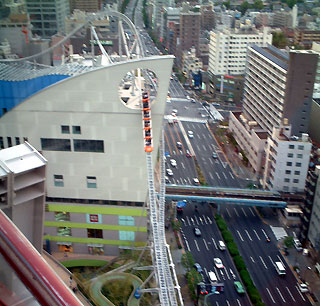
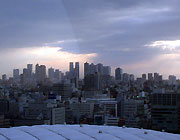 I love heights. Or rather, I should say, I get a kick out of seeing the familiar world from another perspective. I also like the fear in the pit of my stomach that sometimes accompanies the view. So when Tod suggested we ride the ferris wheel at LaQua the other day, I was excited. It's been there a year and we hadn't ridden it yet (though we've been on the roller coaster several times--I also like speed thrills)
I love heights. Or rather, I should say, I get a kick out of seeing the familiar world from another perspective. I also like the fear in the pit of my stomach that sometimes accompanies the view. So when Tod suggested we ride the ferris wheel at LaQua the other day, I was excited. It's been there a year and we hadn't ridden it yet (though we've been on the roller coaster several times--I also like speed thrills)
From our slowly moving vantage point, we watched the roller coaster scream through the building and gazed out over our neighborhood across to the skyscraper district in west Shinjuku.
 Mt Fuji made an appearance, silhouetted by the setting sun just to the left of the Tokyo Metropolitan Government Building. I'm always a little shocked at how large the sacred mountain looms on the horizon. But at the same time, she's very small. Catching Fuji on film from Tokyo is a little bit like taking photos of the moon--it captures your whole attention, but in reality it doesn't take up too much of your field of view. Can you see her in the inset? It's just a few dark pixels smack dab in the middle. But such pretty pixels.
Mt Fuji made an appearance, silhouetted by the setting sun just to the left of the Tokyo Metropolitan Government Building. I'm always a little shocked at how large the sacred mountain looms on the horizon. But at the same time, she's very small. Catching Fuji on film from Tokyo is a little bit like taking photos of the moon--it captures your whole attention, but in reality it doesn't take up too much of your field of view. Can you see her in the inset? It's just a few dark pixels smack dab in the middle. But such pretty pixels.
Today's weather forecast--sunny and 25 degrees--inspired me to go for a hike. I left home shortly after 7 and by 9 am I was starting the easy climb up Mt. Takao at the western edge of Tokyo. The weather lived up to its promise--warm, sunny and perfect for a short jaunt into the mountains.
I went alone and I think it's the first time I've hiked by myself in the forest since I was a kid.
From 1975 until I left home for college, I lived in an undeveloped vacation resort in the low, rolling mountains of northeastern Pennsylvania. There were no neighbors, but there were hectares of land to explore. And I did. I had favorite trails that only the deer and I knew about. I understood the ridge-line of the nearby mountain like nobody else, except maybe our dog, Turkey, who liked to come along with me. I could make a beeline to interesting rocks and trees and to the head of the streams that fed the lake in the valley below.
Today's trip wasn't quite so intimate with the land. I stuck to the trails and I wasn't exactly alone. There were scores of senior citizens hiking, too. They were so beautifully prepared--thin white cotton towels around their necks, collapsable aluminum walking sticks, pants tucked into their socks. And every one of them had a backpack stuffed full with provisions. Really put me to shame. I had no fancy hiking gear--not even a backpack.
But it was such a freeing experience to walk mostly by myself in nature. I should make sure to do that more often. Only next time, I'm taking a towel.
On Thursday, I did as announced and took a long walk. I strode for 4 hours and took a 60 minute break for lunch. I ended up at Niiza, Saitama, 20.7 km from home.
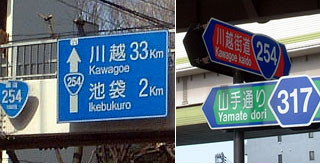
My route was straight up national road 254. It's called Kasuga Dori where I live, but past Ikebukuro it turns into Kawagoe Kaido. This route from Tokyo to Kawagoe has been travelled for hundreds of years. These days, it's a four-lane highway all the way. Well designated, too. Even at the most complex intersections, I was never disoriented for more than the moment it took to find the right signpost.
I plodded through the familiar territory of my neighborhood, then into a section of the city I hadn't seen before, though it was the same in tone and tenor as my neighborhood. After 45 minutes, I reached Ikebukuro, where I crossed over the Yamanote Line.
Outside the loop, the neighborhoods seemed more parochial than the skyscraping commercial zone I'd just left. Buildings were lower and businesses focussed on daily living. But soon enough the quaint shops in run down buildings gave way to suburban sprawl. Bicyclists outnumbered pedestrians. Ramen shops gave way to family restaurants. I watched bicycle shops turn into motorcycle shops and eventually car dealerships.
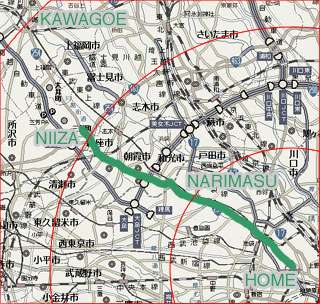
My goal was to reach Kawagoe, 34 km from home. But as I walked, my sense of time and distance got looser. By lunchtime, I'd reached Narimasu, 10 km from my starting point. I'd walked for about 2.5 hours according to my notes. I tried to do the math but it seemed wrong. After that much time, shouldn't I be farther? I remeasured the map and came up with a different distance. I noted both then focussed my attention on eating.
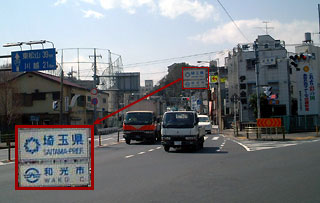
Reaching the prefectural border just after lunch cheered me up. How many people in central Tokyo have walked to Saitama? Probably not too many. And there's a reason for that. Over the border, Kawagoe Kaido turned industrial and extremely car-centric.
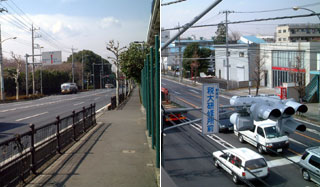
But this was intended as an endurance test, not a sightseeing trip. How far can I walk? What is the experience of going that far? I spent time thinking about how I should be thinking about the trip. I wondered back in time--50 years, 100 years, 400 years.
The reality was that four lanes of traffic accompanied me. A strong wind blew dust into my face. I walked for minutes with my head down and my eyes half shut. It was boring most of the time. There wasn't much nature around. I stopped walking and came home because the blisters on my feet broke open. It hurt and I'm a wuss.
But I'm encouraged. I've made a target map of the places I can reach within a 10, 20 and 30 km radius of home. I'll be going walking again as soon as my feet heal. I'll buy a pedometer and maybe next time, I'll try a more scenic route...
For the last little while I've been considering long walks. Having walked from home to Yotsuya a few weeks ago, only a 40 minute trip on foot, I imagined some of the long journeys by foot throughout history. To be honest, hobbits kept coming to mind...
Walking is the most natural mode of transportation. After all, we only recently invented motorised transportation, and even hooved transport wasn't always available. But we've always had feet. Well, for a long, long time, anyway.
MJ mentioned a TV show she saw quoted 10,000 steps a day as the optimum amount of walking. Figuring about 80 cm per stride, that's 8 km, or just short of 5 miles every day. Apparently the average Japanese dweller walks about half that.
The average walking pace is about 4 km/hour. So 8 km is a two hour walk and that seems not so difficult, really.
What if I started out in the morning and walked for 8 hours? Where would I be? I have no idea...but I plan to find out.
If the weather is fair on Thursday, (tenki yoho says it will be) I will take a long hike, starting from Korakuen station at 9 am and walking until about 6, allowing time for lunch and short breaks along the way. Return via train to a long, cold beer.
If anyone would like to join me, send me a mail. Company is most welcome.
"Kuri, can I ask a favor?" MJ asked this morning. "Bring me a chicken pie..."
So I took the last of our stash of Vili's pies from the freezer and hopped a train for Kanagawa. 90 minutes later, I handed MJ her chicken pie. And here I am , enjoying an evening away from home in cosmopolitan Hiratsuka.
No more pies left. Deliveries are currently suspended until the supply is replenished.
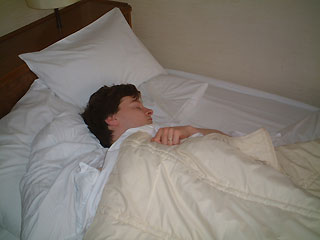
9 am
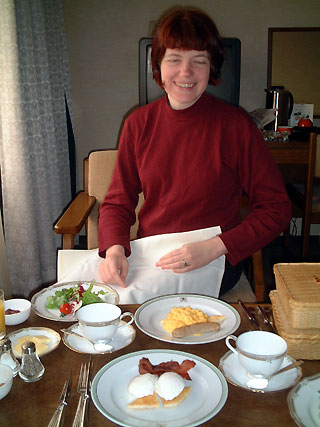
10 am
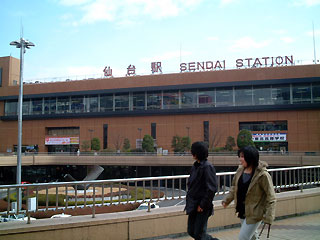
11 am
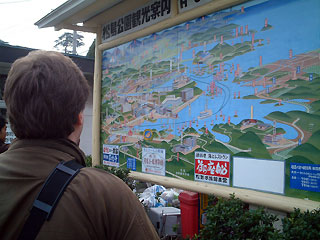
noon
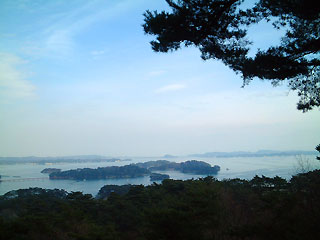
1 pm
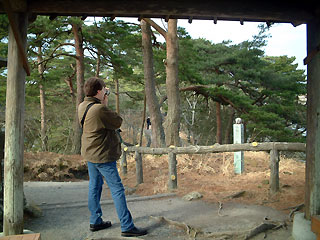
2 pm
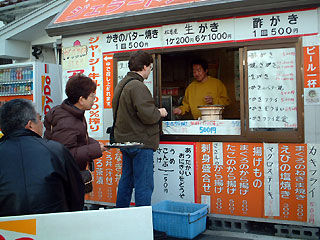
3 pm
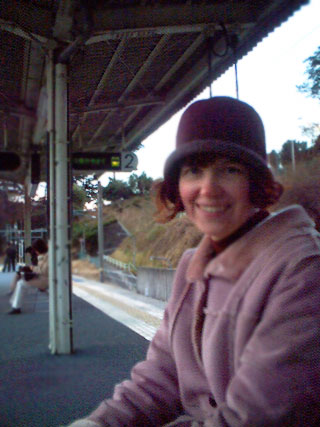
4 pm
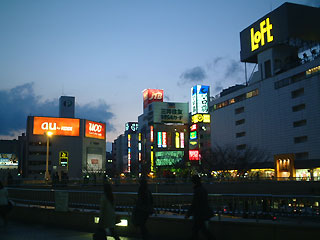
5 pm
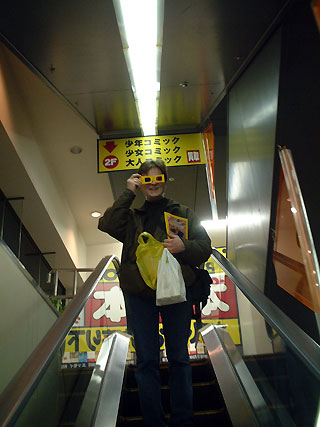
6 pm
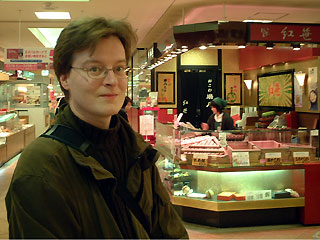
7 pm
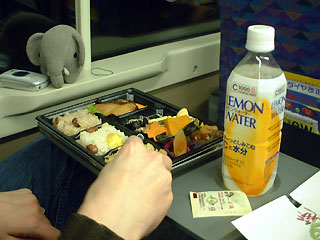
8 pm
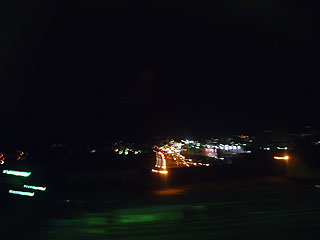
9 pm
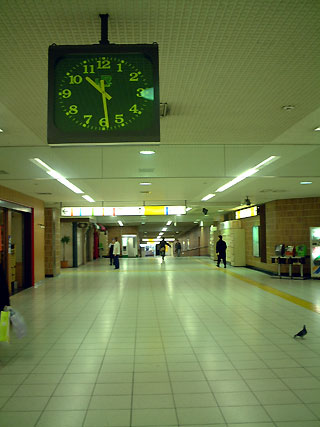
10 pm
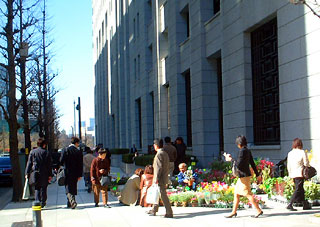
On the way to work today, I walked by this impromptu flower and plant market set up on the corner. It reminded me of the farmers market in Chicago--every Thursday after lunch, women returned to their offices with armfuls of gladiolas. It was very cheery and colorful.
Place: Namboku line subway.
Time: 8:47 am, Monday morning
DOORS open and passengers spill out. A steady stream of men in suits heads towards the nearby ESCALATOR.
KRISTEN stands to one side, waiting to get on. She holds a large tote bag containing 7 Thunderbirds DVDs, a two-page To Do list, and a change of clothes.
K: So many people. What do they all do? Push paper and money around the country, I suppose.
The buzzer sounds and the flow of traffic changes directions. Everyone boards the train.
K: Oh, look a little bit of space over there. Can I squeeze through?
Pushed from behind, Kristen slides into the gap between two people with backpacks. Her tote bag catches between two businessmen's computer cases. She yanks it free.
K: Ugh, foetid breath on that guy...I hope I don't catch whatever he has. Can I breathe more shallowly? How do people manage this every morning? Is that woman putting on makeup? She has no room to move her arms...what a trick!
Train pulls into station after station. More passengers crowd the carriage, until one last one swings in puts his hand on the door frame and pushes back until there is room for his feet to clear the DOOR as it closes.
K: (wedged solidly in the middle of the car) My station's next. I am never going to get out of here.
The CONDUCTOR announces "Nagatacho, Nagatacho desu" and the doors open. All passengers moves as one toward the doors and head up the ESCALATOR to the EXIT.
[OK, now I have to go do this for real. Wish me luck.]
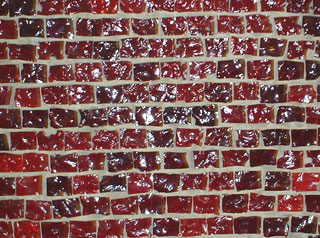
Thousands of finger-width glass tiles on the facade of a bank near Itabashi station. The overall effect is brick red and glossy. I suspect that not too many people even notice, but imagine the effort that went into creating this.
"Look, a rice shop," I said to Tod as we walked up Sotobori Dori from Akihabara towards Ochanomizu.
"And they sell CDs...huh?"
"Hey, wait a second, that's Basmati rice!" I pulled the door open. Inside the modest store was a treasure trove of Iranian food: dried beans; tinned halal stews; saffron candy; nuts, pickles, and olives.
The owner offered us each a fresh date sprinkled with coconut to enjoy while we browsed. Heaven!
I left with a bottle of rosewater for making sweets, a jar of jam that is labeled in Arabic with the picture of a mysterious fruit, a box of dried herbs, and a bottle of pomegranate molasses--now I can make mohomara!
We returned after dinner to acquire some weightier purchases--a leg of lamb and a 5 kg bag of basmati rice. Guess what we're having for dinner on the Emperor's birthday this Tuesday?
If you'd like to visit Darya Shop, you'll find it at 2-1-4 Soto-kanda, Chiyoda-ku on Sotobori-dori, just down the hill from Marunouchi line Ochanomizu station (on the same side of the street as the river). The phone number is 03-3251-5387 and it's open from noon - 10 pm, except Mondays.
Because of all the construction in our neighborhood, the past year has seen the local sidewalks dug up and patched over three or four times. But it has finally drawn to a close.
For the past few weeks, the curb-layers were building new edging and yesterday the bricks were delivered. They worked hard this weekend and have already finished two blocks.
I love Bunkyo-ku's red brick sidewalks and I'm happy to see them again. I'm also pleased that I won't be tripping over uneven lumps of asphalt anymore.
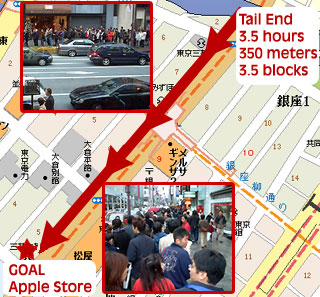
The Apple Store opened in Ginza today. The lines stretched for three and a half long blocks--a three and a half hour wait. I just gawked at the people standing in line.
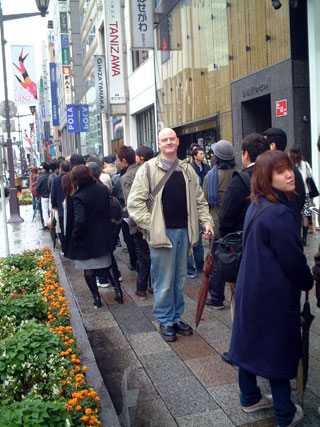
UltraBob came all the way from Zushi just to stand in line. He looks very happy here (near the end of the line) at 1:30 pm. I wonder what time he got into the store?
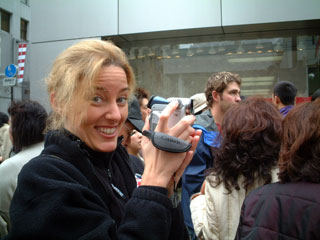
Leslie has the right idea--capture the crowds from outside the line.
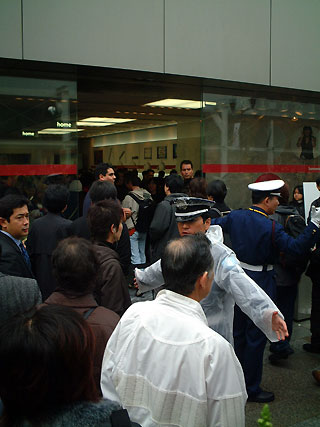
The crowds were extremely well behaved and the guards were mostly for directing traffic to the end of the line and allowing people into the store in batches. You can see a few burly American bouncers in the background. I've no idea why they might have been needed.
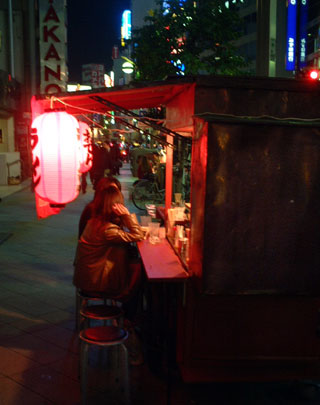
Late-night snacking in Shinjuku.
Where to dine when the trains stop running? Street-side stalls ply their trade into the wee hours. Ramen is Tokyo's favorite apres-bar sustenance.
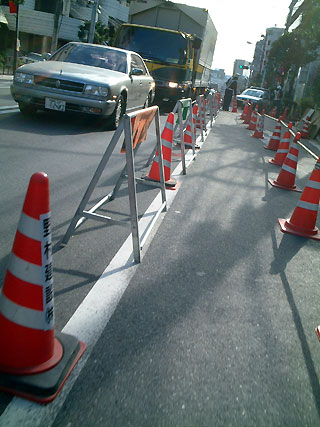
Construction in our neighborhood has pedestrians routed into the street. The traffic cones are out in full force doing their duty.
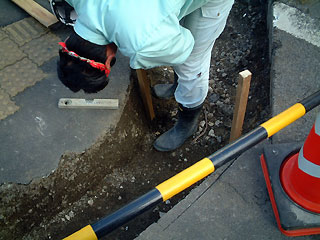
Cones try to protect the construction workers from nosy, photo snapping onlookers, but not very well.
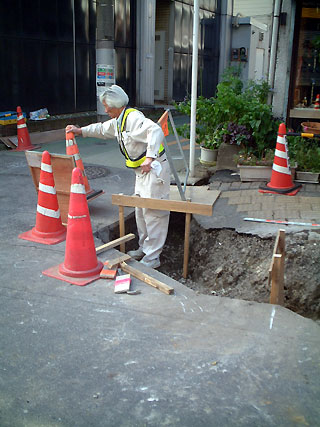
The cone supervisor realigns his charges.
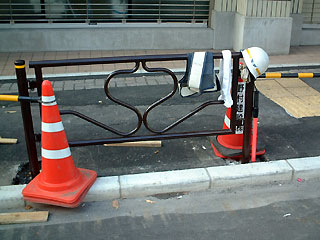
Even cones need a break.
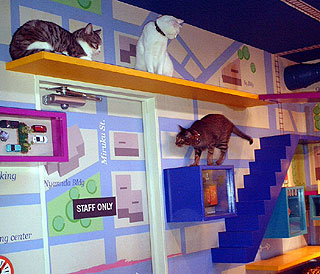
Nekobukuro is a mini theme park where 20 cats roam free so you can play with them. The walls are fitted out with shelves and boxes that the cats can jump to and walk around on. There's even an overhead plank that spans two rooms for quick escapes and pirate games.
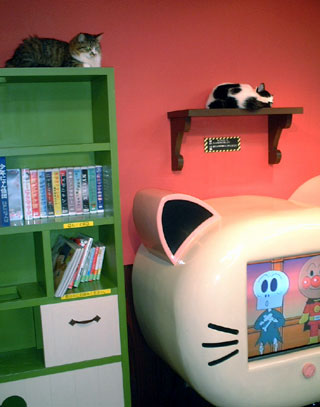
When they are ready for catnaps, there's no shortage of places to conk out. In addition to shelves, there is all sorts of soft cat furniture. The cat-shaped TV plays videos of the Nekobukuro Idol Cats while Anpanman narrates with facts and jokes.
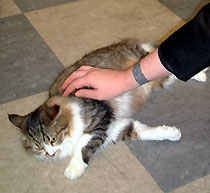 There are cats in every size, shape and color you can imagine. Rare breeds, like the wrinkly, hairless Sphinx and giagantic Maine coon, live behind glass but are rotated through the mix. While we were there a yowly little Tonkinese was out of her room and playing with visitors.
There are cats in every size, shape and color you can imagine. Rare breeds, like the wrinkly, hairless Sphinx and giagantic Maine coon, live behind glass but are rotated through the mix. While we were there a yowly little Tonkinese was out of her room and playing with visitors.
Some cats were disdainful or wary, others playful and happy to have a pat. I tried to engage one cat with a feather toy, but it wanted to chase string. Next time, I'll sneak in the laser pointer and see what happens.
This is a clever idea in a country where a kitten costs 120,000 yen and not too many apartments allow pets. I enjoyed interacting with the cats for a little while and the dozen other people, some with cameras and some on dates, seemed to be having fun, too.
Although the rooms are well ventilated, there's a faint scent of litter box. After after 15 minutes, my eyes were itchy. We hadn't really handled the cats as much as observed them, so we didn't need to use the cat-hair lint removers at the door.
Nekobukuro
Location: Tokyu Hands Ikebukuro, 8th floor.
Hours: 10:00 -20:00
Admission: 600 yen (1,000 yen "pair ticket")
See also: Cats Livin', Cat Park, Dog Forest, Dog Town, Ferret Friends at the same website.
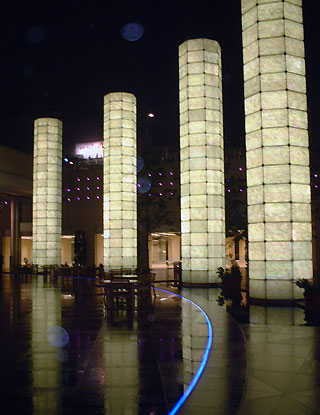
10 meter tall, opalescent glass light towers at Shiodome cast reflections on a rainy night.
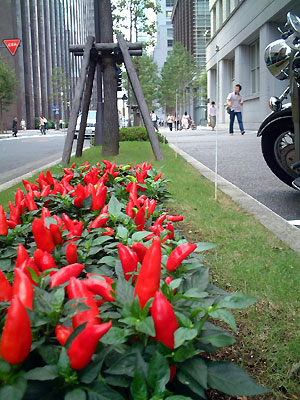
The berm along this section of Marunouchi Nakadori is a green oasis in a new retail desert. Each season it is planted with with fresh sod and flowers to brighten up an otherwise drab block of corporate headquarters. This summer it features red peppers. No one even considers picking them.
Unlike the rest of Marunouchi, this particular block hasn't felt the touch of urban renewal. It maintains the cold granite face that the entire street had just five years ago--imposing architecture with minimal exterior signage, curtained street-level windows, and shops tucked into basement hallways. You had to be introduced to the neighborhood's great restaurants by your coworkers because it was unlikely that you'd find them on your own.
But times are changing and elsewhere along this corridor between Otemachi and Ginza, buildings are turning themselves inside out. They've removed their uninviting marble facades and replaced them with plate glass windows opening into high-end boutiques and restaurants--Prada, Kate Spade, Hermes and Emporio Armani all have shops here. There's a website to promote the area and help shoppers find their way: Marunouchi.com
I think this renewal was precipitated by the Marunouchi Building which opened last December after several years of construction. Perhaps "Maru Biru" made neighboring building owners realise there was as much profit in retail as in office space. The Mitsubishi Trust Building completed their renovations a few months back with a lot of tasty restaurants, including a posh Dean & Deluca, and there are three more huge construction projects along the street.
But I still like the block with the pepper plantings the best. It's the only non-retail stretch remaining in the neighborhood. I can breathe a little easier and relax the tight hold on my wallet as I go past.
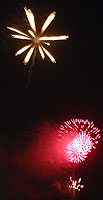 Summer fireworks festivals are a tradition dating back hundreds of years. Originally for the powerful elite, there were public fireworks along the banks of Sumidagawa in 1733.
Summer fireworks festivals are a tradition dating back hundreds of years. Originally for the powerful elite, there were public fireworks along the banks of Sumidagawa in 1733.
These days summer fireworks are an excuse for everyone to get dressed up in their yukata and spend some time outdoors. Over the last 50 years, the weeks spanning mid-July and mid-August have become an increasingly loud and colorful time of year.
Last night, we picnicked on the embankment of Edogawa and watched competing fireworks companies shoot off 14,000 fireworks in 75 minutes. It was splendid. This video doesn't really capture the jaw-dropping majesty of the event, but it gives a taste of three moments during the spectacle.
![]() Edogawa Hanabi 0'50" (2.8MB Quicktime)
Edogawa Hanabi 0'50" (2.8MB Quicktime)
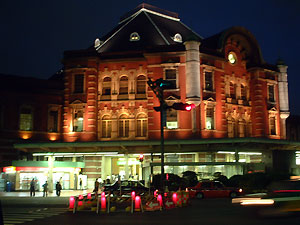
Yesterday between 3 and 7 pm, I travelled counter-clockwise around the Yamanote line to capture images for Yamanote29. I rode through all 29 stations and stopped at most of them, though for a few, I was so quick that I got back on the same train I jumped out of. Got my picture and a few bemused looks from the other passengers.
I decided to walk between Komagome and Sugamo, and between Shinjuku and Yoyogi. Those pairs are pretty close together and I made detours to two of my favorite places in the city: Rikugien, a 300 year old garden in Komagome, and the 45th floor observatory at the Tokyo Metropolitan Government Building. Lovely views at both places, but they couldn't be more different.
I skipped a few stations so that I'd end up back at Tokyo station in time to meet Tod for dinner, so I will have to go back for pictures at Harajuku, Shibuya, Ebisu and Meguro.
But I got plenty of photos to keep me busy--I filled up my digital camera's 64 Mb memory card. Slowly but surely the site is getting ready to launch. And I've already received two contributions. (Thanks, and keep them coming, please!)
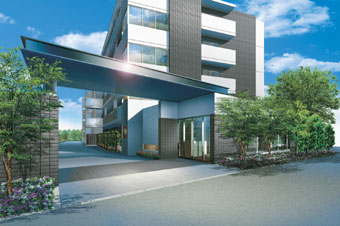
Every new apartment building that goes up in our neighborhood has a silly name and a website with Flash animations. Imagine the prices!* Or look for yourself...
Glorio
Qualia
PIAS (Personal & Intellectual Architecture Space)
Precise
Park Square
Atlas Tower
Viequ Court
Brient
Parterre
*These apartments range from 19,800,000 yen to 135,000,000 yen (about $166,500 to $1,134,500)
The rollercoaster at LaQua climbs a track so high that you can see across the glacial white expanse of Tokyo Dome. Last night the sky was clear and the lights and neon from other parts of the city were so captivating that for a brief moment, I forgot was was about to happen.
It was after a baseball game, nearly closing time, and our companion Ben said, "C'mon, let's go ride!" What a brilliant idea. There was no line. We've seen waits of several hours with people snaking down the stairs and out into the hallway. But we waited the length of one loading and unloading and then it was our turn.
We piled into the back of the roller coaster. Ben and two other friends sat in the last car. Then us. Then a lot of little Japanese folk. After everyone was strapped in and checked, they were about to press the button to release the brake when there was some hand-waving at the front and an announcement.
"There will be a short delay for a safety check. Please wait a moment." And in the operator's booth, they started pulling out manuals. Hmmmm. Maybe they'd never had so many overweight gaijin sitting in the back before. How would that affect the ride? Too much power down the hills? Could we fly off the track on the curves?
After a few minutes, during which a sixth companion (who had bailed in fear) mocked us, they closed the manuals, pushed the big green button and we took off. Up the steep hill with the view and then...
Terror. The first drop plunges nearly straight down. I screamed. People aren't supposed to plunge straight down. I closed my eyes before we hit bottom.
But as soon as I felt the coaster curving up (ah! safe!), I opened them again to see our ward office passing by sideways. The ride was exhilarating and over way too soon.
But we'll go again. I'm happy to contribute to LaQua's money making machine.
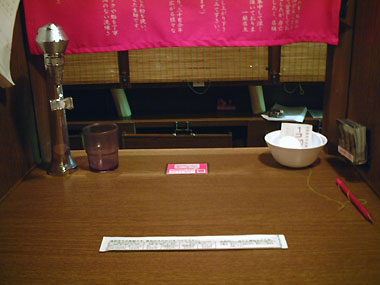
This ramen shop at LaQua, Ichiran, allows the diner to be almost entirely anonymous--just like a love hotel.
After selecting and paying for your meal at a ticket vending machine, you are handed a slip of paper and sent to your own private eating booth ion a row of similar booths.
The paper lets you choose the amount of garlic and spice in your ramen, how you want your noodles cooked and wheter you want slices of charshiu (Chinese pork) or not. After you circle your selections, you ring the bell and from the other side of the red curtain, hands come forth to take your ticket.
 A perky voice behind the curtain, accompanied by a glimpse of apron-covered midsection, explains that they will make your ramen now and please wait a few minutes. An egg in a bowl appears. You can have this for just 100 yen, if you want it. An empty water glass is set on the counter next to your private tap.
A perky voice behind the curtain, accompanied by a glimpse of apron-covered midsection, explains that they will make your ramen now and please wait a few minutes. An egg in a bowl appears. You can have this for just 100 yen, if you want it. An empty water glass is set on the counter next to your private tap.
In a few minutes, a steaming bowl of ramen is delivered. The egg, being unwanted, is removed. You are wished a pleasant meal and the bamboo curtain is lowered. Whether this is to keep you from watching the staff moving around mysteriously, or whether it's to spare them the sight of your slurping, I'm not sure.
It's quaint and different. The ramen is good with a Hakata-style broth. I can understand why there is always a queue to get in.
The construction site across the way is using its crane to move roof trusses into place today.
They are huge iron arcs, charcoal ribs gracefully curving from end to end and narrowing to a point decorated with a white flag.
Twisting a little as they are hoisted up and across the building, they give the illusion of a giant Calder mobile.
What a shame when they are welded into place.
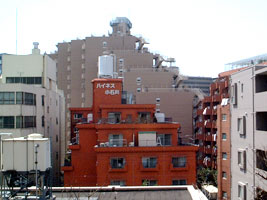
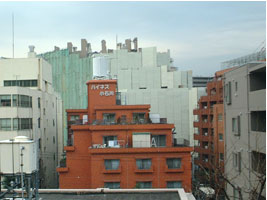
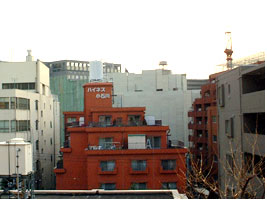
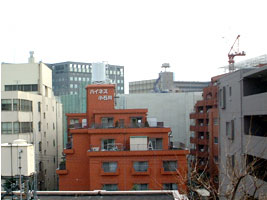
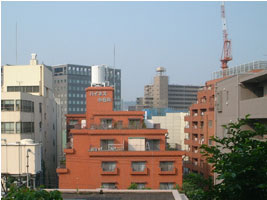
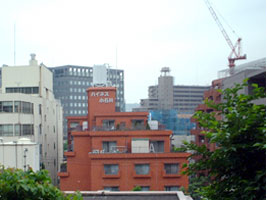
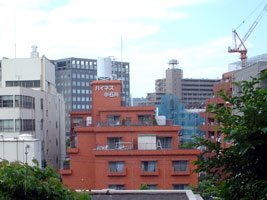
As promised on February 18, here is the complete series of photos of neighborhood destruction. Each week revealed a new vista of buildings in the background. The blue tarped construction in the later photos is a new Daikyo Lions Square luxury apartment complex going up next door to the destroyed building.
 Tod & I documented our part of town yesterday as part of Tod's birthday festivities. It was a lovely day for a walk and we had fun really paying attention to the details and quirky things that make our neighborhood different from others. I've posted the fruits of our labor on mediatinker.com so you can take a tour of Kasuga.
Tod & I documented our part of town yesterday as part of Tod's birthday festivities. It was a lovely day for a walk and we had fun really paying attention to the details and quirky things that make our neighborhood different from others. I've posted the fruits of our labor on mediatinker.com so you can take a tour of Kasuga.
Soon, these will also be part of the Neighborhood Project run by UltraBob. You can get your neighborhood featured there--just send in your pictures and captions.
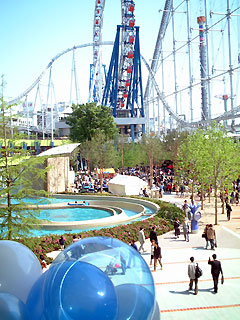 The newly opened LaQua looks like an amusement park, doesn't it?
The newly opened LaQua looks like an amusement park, doesn't it?
Only from this angle. There are also 46 stores and 19 restaurants area, a fitness gym and a spa that includes baths filled with hot spring water they drilled for specially. Nestled between Tokyo Dome and the Bunkyo ward office, this is another of the city's new "urban destinations."
LaQua opened yesterday and I dragged Tod out to have a peek. We had lunch at Maharaja and afterwards I walked through the mall to see what it was all about. More of the same as everywhere else, really, but I will be able to reduce the number of trips to Shinjuku and Shibuya.
The rollercoaster, the Thunder Dolphin, makes a double loop around the roof and through the center of the hubless Ferris wheel at a breakneck 130 km/h. The entire building shakes when it goes past--in one store, a display of glasses toasted one another with chattering clinks every few minutes.
At 1,000 yen a ride, Tod calculated that they take in 480,000 yen an hour on a busy day. That works out to about 15 million USD a year if they are at full capacity on 300 days.
I'll bet the ward office civil servants are already weary of the people screaming past their windows every 3 minutes.
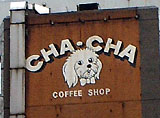 Spotted in Kanda: nostalgic advertising. The coffee shop doesn't seem to be there anymore but the sign lives on.
Spotted in Kanda: nostalgic advertising. The coffee shop doesn't seem to be there anymore but the sign lives on.
I think it's from the early 60s, judging from the building its painted on, the typeface, drawing style, and the name--cha cha hit its peak as a dance fad in the late 50s. And the name's a pun. Cha means 'tea' in Japanese. But with the dog pictured, I wonder if this Cha Cha was the owner's pet?
Just below the sign is a koban, a neighborhood police station, complete with policeman on display with his patrol bike:
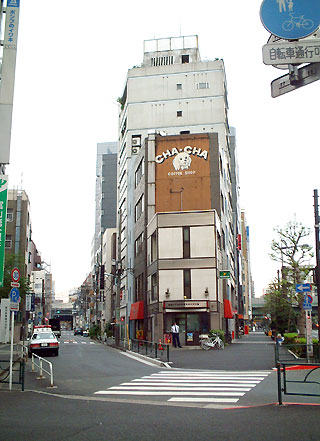
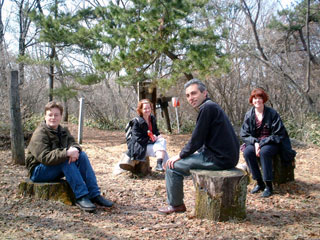
Yesterday's get-away to Ikaho in Gunma prefecture was a refreshing escape from the city. We climbed up to the top of one of the local peaks. There were signs warning us of bears and wild boars, but we didn't see any.
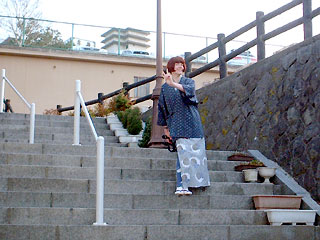
Ikaho is an onsen resort town, so it's fine to wear your yukata out on the street. The main corridor is a long flight of stairs lined with shops and ryokan.
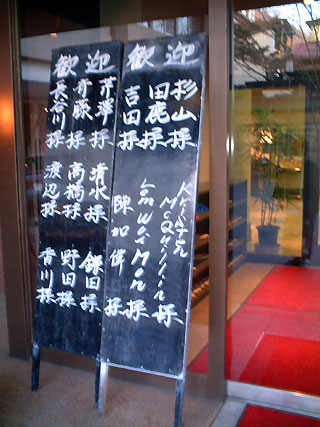
We stayed at Kishigon ryokan which has been run by the same family since the town was founded in 1576. The current matron is an Aoyama University graduate who speaks fluent English. Look carefully and you'll see my name on the sign greeting the day's guests.
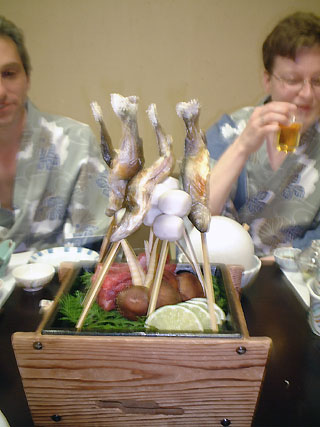
The food at the hotel was amazing. These are fish and skewered potatoes that we grilled at our table. We were served 36 dishes for dinner--truly a feast.
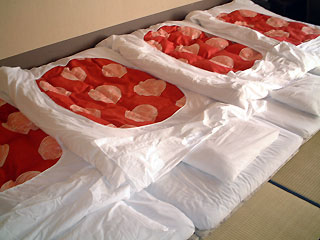
After climbing a mountain, eating dinner and enjoying three onsen baths, we were ready to collaspe on the lovely futon. Ah, sleep!
Shinjuku station is a huge, crazy maze. There are three subways, dozens of buses and five or more train lines all converging. It is always full of people. This is not a place for the faint of heart.
The best way to navigate through the station is to turn off the logical left brain and let the right one squeeze through the crowds. With the spatial right brain in control, you won't run into anyone, you'll find the place you need to be without stressing and, maybe best of all, you'll notice all sorts of things you don't expect.
Memories of my walk through the station are a collage of magazine pictures and video clips: the laminated cardboard Dumbo on a young girl's keitai; the shadow of a three day beard on a black man; the tilted head of a rushing traveller; the reflection of the overhead lights in someone's sunglasses; the sound of the TVs flickering in a display; the herky-jerky movement of a suitcase with a bad wheel; the whir of the blenders at the Snap'py juice stand; the scent of hot dogs in the Food Pocket; the subtle texture of the plastic wickets at the Oedo line; the warmth of Tod's hand in mine (he hates getting lost in the station).
I have no idea how I got from point A to point B, but I did. Just like I always do. Follow me.
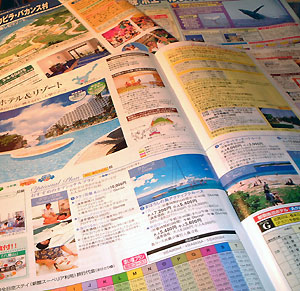 I got it into my head that I'd like to go to Okinawa for my birthday as a nice tropical treat. I know domestic travel is usually cheapest if done on a package tour or plan that includes hotel and flight, so I went to the local JTB office and grapped some pamphlets.
I got it into my head that I'd like to go to Okinawa for my birthday as a nice tropical treat. I know domestic travel is usually cheapest if done on a package tour or plan that includes hotel and flight, so I went to the local JTB office and grapped some pamphlets.
Well, they aren't pamphlets as much as 40-60 pages of messed-up layout and advertising.
From these slick brochures, I cannot tell which island and hotel combo has the right atmosphere. I just want a quiet place with great food and some beach activities. Maybe snorkelling or sea kayaking--something a little physical to burn off the fruity drinks, awamori and tasty dinners.
Wanna leaf through the ANA's Okinawa Sky Holiday brochure with me?
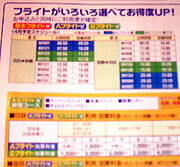 Let's start with the basics. Here on page 2 we're already discovering that you can get better flight times by paying extra money. Leave Tokyo earlier on the first day and return home later on your last day. Only 1,500 - 3,000 yen/person. Is that per flight or does it cover round trip? I'll bet it's per flight but I can't tell without looking up some kanji.
Let's start with the basics. Here on page 2 we're already discovering that you can get better flight times by paying extra money. Leave Tokyo earlier on the first day and return home later on your last day. Only 1,500 - 3,000 yen/person. Is that per flight or does it cover round trip? I'll bet it's per flight but I can't tell without looking up some kanji.
 Flipping forward past the bus time tables and rental car details, we find this ad on page 22. At the Renaissance Resort, you can get the resort's most popular attraction, a Dolphin Encounter, for 7,800 yen for 40-60 minutes. I'm not exactly sure what this includes, but the fine print has an awful lot of dekimasen in it. Never a good sign.
Flipping forward past the bus time tables and rental car details, we find this ad on page 22. At the Renaissance Resort, you can get the resort's most popular attraction, a Dolphin Encounter, for 7,800 yen for 40-60 minutes. I'm not exactly sure what this includes, but the fine print has an awful lot of dekimasen in it. Never a good sign.
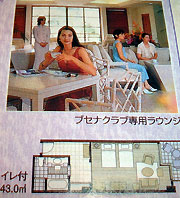 Hotels in Japan all seem to have twin beds. Even if you pay an extra 15,000 yen/night at the Busena Terrace, you don't get a big bed, just a large 43 square meter room with bath, toilet, big balcony, welcome fruits and the Stepford wives in the lounge. Let's move on to another page, shall we?
Hotels in Japan all seem to have twin beds. Even if you pay an extra 15,000 yen/night at the Busena Terrace, you don't get a big bed, just a large 43 square meter room with bath, toilet, big balcony, welcome fruits and the Stepford wives in the lounge. Let's move on to another page, shall we?
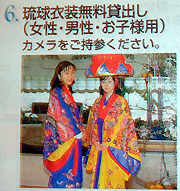 Page 25 of 58. What fun! Free dress up in Okinawan-style traditional costumes. Good for women, men and children's use. Please bring your own camera. This is point 6 at the Laguna Garden Hotel. Some of the other points include 50% off rental cycles; 10 game corner tokens, and discount coupons at the American Village amusement area. This is obviously a family resort. Run away!
Page 25 of 58. What fun! Free dress up in Okinawan-style traditional costumes. Good for women, men and children's use. Please bring your own camera. This is point 6 at the Laguna Garden Hotel. Some of the other points include 50% off rental cycles; 10 game corner tokens, and discount coupons at the American Village amusement area. This is obviously a family resort. Run away!
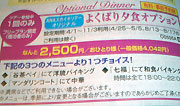 None of the places feature their food, though they all offer optional dinner plans through the ANA Sky Holiday service. 2,500 yen/person gets you a choice of Chinese, a Japanese buffet, or an Okinawan buffet at the Rizzan Sea Park Hotel. This is a bit pricey and limited in scope as other hotels offer 5 choices for 1,500 yen. So maybe the food is better here.
None of the places feature their food, though they all offer optional dinner plans through the ANA Sky Holiday service. 2,500 yen/person gets you a choice of Chinese, a Japanese buffet, or an Okinawan buffet at the Rizzan Sea Park Hotel. This is a bit pricey and limited in scope as other hotels offer 5 choices for 1,500 yen. So maybe the food is better here.
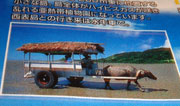 All of the previous resorts were on the main island, about 80 minutes' bus ride north of the airport at Naha. If you go out to some of the other islands, you get to do more sedate activities. This ox cart photo is featured in every brochure page listing Yufujima, a speck that doesn't even seem to have a hotel. You have to go there special to ride the ox cart. Hmmmm. Pass me another Tanqueray and tonic, please.
All of the previous resorts were on the main island, about 80 minutes' bus ride north of the airport at Naha. If you go out to some of the other islands, you get to do more sedate activities. This ox cart photo is featured in every brochure page listing Yufujima, a speck that doesn't even seem to have a hotel. You have to go there special to ride the ox cart. Hmmmm. Pass me another Tanqueray and tonic, please.
To go on the Free Plan ("free" meaning you don't have to go on all the pineapple plantation tours and have set menu dinners during your holiday), not including optional dinners, upgrades or any activities, I will have to shell out between 53,000 and 67,000 per person. Am I willing to spend that much to discover that I've guessed wrong about the resort's ambiance?
I think I'll plan to stay home for my birthday this year.
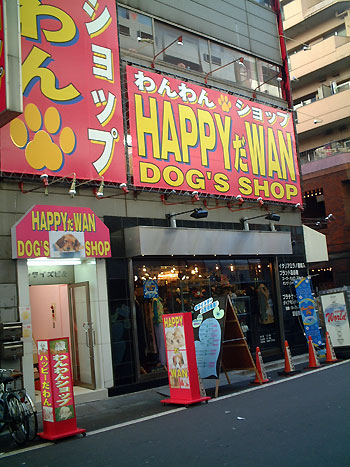
2nd floor puppy mill shop. Ikebukuro. ("Wan" is "woof" in Japanese)
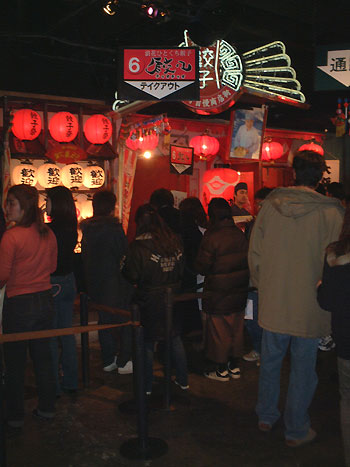 A few months ago Namjatown, Namco's indoor amusement park, opened a new attraction called the Gyoza Stadium, featuring a dozen different kinds of Chinese dumplings. We love gyoza and have been looking forward to visiting the Gyoza Stadium. We tried to get in on a weekend just a few weeks after it opened but there was a three hour wait and we were too hungry.
A few months ago Namjatown, Namco's indoor amusement park, opened a new attraction called the Gyoza Stadium, featuring a dozen different kinds of Chinese dumplings. We love gyoza and have been looking forward to visiting the Gyoza Stadium. We tried to get in on a weekend just a few weeks after it opened but there was a three hour wait and we were too hungry.
But yesterday afternoon there was no wait, so we paid 300 admission and stepped in.
Namjatown is divided into five sections, differently themed. We didn't even consider the other parts and headed straight for the gyoza section.
It gave me the creeps. Decorated like a downtown Tokyo neighborhood in the 1960s, it was a maze of alleys and turnings.
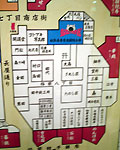 This map shows part of the layout. The blood red parts are the gyoza stands. The blue bit is an a mosquito-themed ride where you go around spraying mossies while riding a giant pig-shaped mosquito coil holder. All the little lanes in between are filled with nostalgic signs and antiques. And little benches where you can sit and eat the gyoza.
This map shows part of the layout. The blood red parts are the gyoza stands. The blue bit is an a mosquito-themed ride where you go around spraying mossies while riding a giant pig-shaped mosquito coil holder. All the little lanes in between are filled with nostalgic signs and antiques. And little benches where you can sit and eat the gyoza.
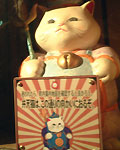 In addition to the gyoza, there are several other attractions. There's a public bath "converted into a studio, to participate in a quiz show" according to the brochure. There is a little shrine and a pilgrimage; this cat is supposed to be Bishamonten, one of the 7 Lucky Gods. Or you might want to search for clues to a detective game.
In addition to the gyoza, there are several other attractions. There's a public bath "converted into a studio, to participate in a quiz show" according to the brochure. There is a little shrine and a pilgrimage; this cat is supposed to be Bishamonten, one of the 7 Lucky Gods. Or you might want to search for clues to a detective game.
All I wanted to do was to eat some gyoza, but the atmosphere was so dark and claustrophobic that I couldn't do it. By the time we navigated to the gyoza stands, I was entirely too wigged out by the noir lighting, the well-faked cracked cement streets, the falling down building facades (they were in fine repair, just made to look like they were old and falling down) that I had to go without standing in line for gyoza.
It was a scary carnival funhouse. Is this how Tokyo views its recent past?
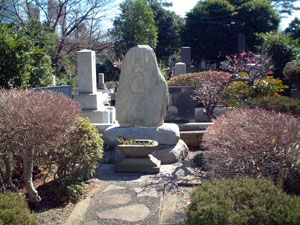 I have a thing for cemeteries. Walking among the headstone, thinking of the people memorialised there; wondering what they were like; why their families keep up their plots (or not). And, of course, there's always a bit of a sexual element running through my head at the same time. After all, sex is what brings all of us together, it may be the only thing we all have in common.
I have a thing for cemeteries. Walking among the headstone, thinking of the people memorialised there; wondering what they were like; why their families keep up their plots (or not). And, of course, there's always a bit of a sexual element running through my head at the same time. After all, sex is what brings all of us together, it may be the only thing we all have in common.
All cemeteries are enjoyable, but Japanese cemeteries in particular are peaceful and orderly. Each plot is for a full family; there are rarely monuments to individuals. Some sections are quite severe; others, like this one, are beautifully landscaped.
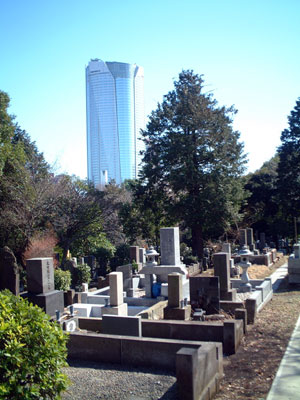 From Aoyama Cemetery, where I took these photos yesterday, you can see the huge Roppongi Hills complex in the background. It's new construction that's nearly finished now. The pictures doesn't really do it justice in terms of its amazing size. Towers over everything in the vicinity.
From Aoyama Cemetery, where I took these photos yesterday, you can see the huge Roppongi Hills complex in the background. It's new construction that's nearly finished now. The pictures doesn't really do it justice in terms of its amazing size. Towers over everything in the vicinity.
I like the contrast of old and dead with the new, vibrant Tokyo in the background.
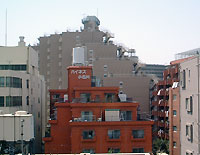
March 2002
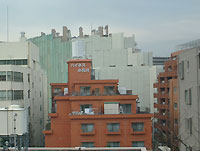
February 2003
It's pretty cool to see the equipment cracking off walls and pushing them over. Concrete kicks up a lot of dust. I have no idea what will be going up in place of this very large apartment block. Maybe just another very large apartment block.
Stay tuned for further photos of the destruction and reconstruction.
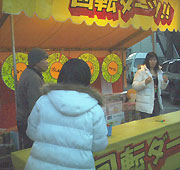 While on a pilgrimage tour to see the 7 Lucky Gods yesterday (read all about it below), we were distracted by a festival in a nearby temple.
While on a pilgrimage tour to see the 7 Lucky Gods yesterday (read all about it below), we were distracted by a festival in a nearby temple.
Among the food stalls serving up everything from mashed potatoes with butter to whole grilled fish on a stick, there were games. I was drawn in by the Kaiten Darts game and had to play. For 500 yen, I got three darts. The target was given a good spin and I threw my darts hoping to hit the thin red line that indicated Big Prize. My first dart hit a yellow prize section; the second dart hit home in the zannen "too bad" section and the last dart bounced off the surface of the spinning board.
Even though I didn't hit the Big Prize section, I did win a prize that I will have fun playing with.
In the first week of the new year, it's traditional to make a visit to a temple. The first visit of the year even has a special name, hatsumode. Posters in the train stations and articles in the newspapers give suggestions on which temples to visit. Some of the more popular temples are listed with the number of visitors during the new year so you can decide whether you want to brave the crowds.
Another tradition is to make a pilgrimage (meguri) to seven shrines of the shichifukujin--the Seven Lucky Gods. This year, I decided to try a shichifukujin meguri in Koto-ku. Thanks to the Exploring Old Tokyo page which lists the addresses, I was able to cobble together a map and find my way to all seven. Of course, I dragged Tod along, too.
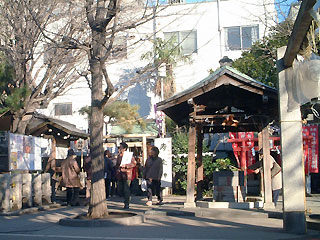 All of the lucky gods offer prosperity, but each one also has a special aspect he or she watches over.
All of the lucky gods offer prosperity, but each one also has a special aspect he or she watches over. 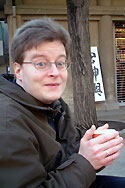 Jurojin carries the secret to longevity in a scroll. He usually wears a scholar's cap and has a long white beard and a staff.
Jurojin carries the secret to longevity in a scroll. He usually wears a scholar's cap and has a long white beard and a staff.
At this shrine, there was a long line of people carrying big white envelopes that said "Fukugawa Shichifukujin Meguri" on them. We got in line there and paid our respects to Jurojin by bowing and clapping. I think he most appreciated the coins we tossed into his offerings box.
We looked around for the place that was selling the envelopes, but couldn't find it. There were plenty of trinkets and things on sale, so we settled for an omikuji, a fortune, and some amazake, sweetened sake with rice floating in it. The amazake wasn't quite ready, so the vendor gave us each a mikan, mandarin orange, to eat while we waited. We considered having a cup at each shrine--sort of a spiritual pub crawl--but ended up with one here and one at the last shrine.
My omikuji was #47 - chuu kichi, middle luck. You can get a range from great misfortune (dai kyou) to great luck (dai kichi) so middle luck isn't too bad. Tod got dai kichi - great luck.
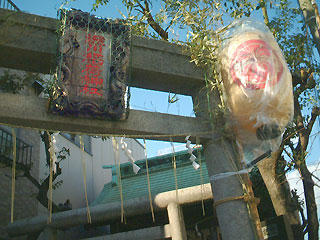 After finishing our amazake, we headed toward the next shrine. Along the way, I realised I really didn't need my map. The route
After finishing our amazake, we headed toward the next shrine. Along the way, I realised I really didn't need my map. The route  was marked with bright orange banners! The map was helpful anyway, to give an idea of the distance, but it was possible to put it away and just follow the banners.
was marked with bright orange banners! The map was helpful anyway, to give an idea of the distance, but it was possible to put it away and just follow the banners.
They lead us to a small inari jinga on the corner of a small street. This is where Hoteiis enshrined. Officially, Hotei embodies happiness (and prosperity) but I think of him as the god of hospitality. Whether that's because his name looks like 'hotel' or because there is a company in Tokyo called Hotei Wines, I'm not sure.
Hotei is usually shown sitting down, fat and laughing. He is the model for the "laughing Buddha" that is so popular in the US. Hotei is the Japanese name of the eccentric Zen priest, Pu Tai, who wandered around China with a cloth sack over one shoulder. Hotei is sometimes shown with a cloth sack containing riches.
There were no omikuji to be had here, so after offering our respects, we headed back to the street and followed the banners.
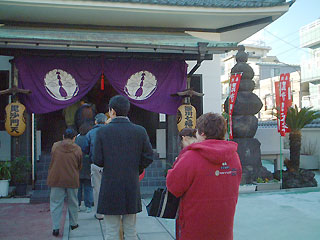 Bishamonten scares the crap out of me. He's the protector of righteousness. He wears armor, carries weapons, and has a fearsome glare in his eyes. Does righteousness really have to be so scary?
Bishamonten scares the crap out of me. He's the protector of righteousness. He wears armor, carries weapons, and has a fearsome glare in his eyes. Does righteousness really have to be so scary?
I lost a little of my fear when I fell into line behind the woman in the red coat. It's covered with Japlish on the back: Dog*O*Shop; Come on a DOS walk with me; DOS is our important friend. It was hard not to giggle.
But then it was our turn to pay our respects. Bishamonten standing inside the shrine was staring down at me, daring me to be unrighteous. I smiled, bowed and drop him a hefty donation before fleeing down the stairs. Wrath of god, indeed.
I bought an omikuji and was delighted to discover that this one came with a special treat. Wrapped up in a slip of gold-flecked paper was a tiny Bishamonten charm. He doesn't look quite so frightening when he's scaled down to 2 centimeters, so I'll put him on my desk and hope he draws in some righteousness for me this year. The omikuji was #30, another chuu kichi. Tod picked up a kichi, but with a kanji we didn't know. When he looked it up later, it means lowest. So lucky, but not too lucky.
 At midnight on New Year's Eve, we visited Daikokuten in our own neighborhood. Now were were going for a second visit. I'm not sure if that brings us more attention and luck, but I hope so. Daikokuten looks after food. Back in India, he fights evil but here in Japan, he watches over the kitchen and harvests
At midnight on New Year's Eve, we visited Daikokuten in our own neighborhood. Now were were going for a second visit. I'm not sure if that brings us more attention and luck, but I hope so. Daikokuten looks after food. Back in India, he fights evil but here in Japan, he watches over the kitchen and harvests
Daikokuten is easy to recognise. He's one of three short, fat guys in the pantheon of lucky gods and he's the only one who carries a mallet. It's a magical wish-granting mallet. In his other hand he usually has a bag of riches and he's almost always standing on top of rice bales.
In front of us in line was a woman with two terriers. Sort of a compliment of the DOS coat woman from the previous shrine. The dogs were nattily dressed in little sweaters with sports motifs. One was Baseball with bats and balls and doggy bones, and the other was sports of all kinds. I don't understand the desire to put dogs in sweaters, but it's very popular here. Fodder for another essay,
perhaps.
Daikokuten's shrine was full of foodstuffs. And the omikuji system was a little different here. I worry that I did it wrong. At the other places, you went off to the side to purchase your omikuji. There was a bin or a basket for your 100 yen coin, and you pulled a slip out. But here, the omikuji were right along side the offering box. Since we'd each tossed in 100 yen, we took an omikuji, but I wonder if we weren't supposed to put in an extra 100 yen...
My omikuji was #23 - kichi - luck, which is the same as chuu kichi. On New Year's Eve, I got a han kichi - half luck. So maybe combined I'll get 3/4 luck in the kitchen this year. Tod's two omikuji from Daikokuten were kichi and dai kichi. If you're coming over for dinner, be sure Tod's manning the kitchen.
When we left Daikokuten's shrine, we couldn't find the route flags to lead us. So I pulled out the map and noted that the closest shrine was about 6 blocks away and around the corner. But where was everyone else? Earlier we'd noticed that the other pilgrims seemed to be following the route in the opposite direction from us. They were coming from the shrines we were going to. Now we were all alone. Peculiar.
As we crossed over one of Koto-ku's many canal's we discovered our error--the flags were on the next bridge over! We detoured along a canal-side path to the other bridge and rejoined the proper route. Maybe that was a little silly, since we were about a block from the next shrine when we did that, but the marked path lead through the town's scenic areas. May as well make our pilgrimage pretty as well as prosperous.
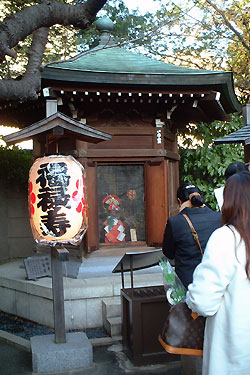 After our detour, we ended up here to visit Fukurokuju.
After our detour, we ended up here to visit Fukurokuju.
This pretty octagonal shrine, like some of the other shichifukujin shrines, is just a small side area that's part of a much larger temple or shrine. Buddhist temples have no problem mixing in Shinto shrines as part of their grounds, though I've never noticed Shinto shrines with Buddhist fixtures. Three of the lucky gods we visited were at Buddhist temples and four were at Shinto shrines. Fukurokuju is enshrined at a Buddhist temple, as were Daikokuten and scary Bishamonten. I don't know if these deities are specifically Buddhist or Shinto or whether they are claimed by both or neither.
Religion in Japan is not easily delineated for the layman. I'm sure if you are a priest or a faithful follower it is all clear and obvious. I'm at the level of ignorance where I can confidently say that Buddhist ceremonies are for sad occasions, Shinto for happy ones. And I know that Shinto shrines have torii gates and the pretty bead rosaries are Buddhist. Beyond that, I'm guessing.
Fukurokuju carries a scroll containing the world's wisdom. He's also associated with longevity, like Jurojin. They are both depicted as old men with flowing white beards, but Fukurokuju is bald and has a very tall forehead. An egghead deity!
Although his name, Fukurokuju, has kanji that mean "luck amount longevity" I think it's interesting that the sound of the name, fuku-roku-ju could also mean "lucky 60." The 12 year, 5 element cycle of the zodiac (2003 is the year of the metal sheep) means that it takes 60 years to go around once. When you reach your 60th birthday, you've seen it all--and have achieved wisdom and long life.
Although there were no omikuji to be had here, we later picked up an all-purpose shichifukujin omikuji from a big Buddhist temple that wasn't part of our meguri. These special omikuji came with gold-plated charms and mine was Fukurokuju. The omikuji was just shou kichi, little luck, so maybe I'll only be a little bit wise this year. As long as I'm not a little more of a wiseass than usual, I guess I'll take what I can get.
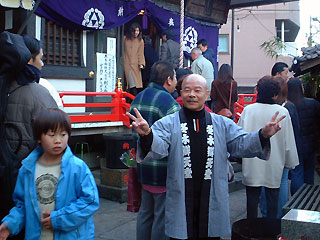 Next we were on our way to the shrine we detoured away from earlier. Benzaiten, also known as Benten, is one of my favorite of the shichifukujin because she is the only goddess among them. I wholeheartedly support women in power. Not only is she the only woman, but she's also patron of the arts and sciences, literature, and virtue.
Next we were on our way to the shrine we detoured away from earlier. Benzaiten, also known as Benten, is one of my favorite of the shichifukujin because she is the only goddess among them. I wholeheartedly support women in power. Not only is she the only woman, but she's also patron of the arts and sciences, literature, and virtue.
Inside her shrine she sat leafed in gold and looking lovely playing her biwa (a Japanese lute not the biwa fruit that's known as kumquat in English). Her interior decorator had gone overboard with flowers, gold lotuses, cushions in rich colors and offerings of fruit, sake and rice. Benten has a cozy home at this shrine. Very inviting. I might have crawled in and played the lute myself except for the long line of other people wishing to pay their respects. And my lack of lute-playing ability...
My omikuji was #47 again (just like Jurojin) -- chuu kichi. I also purchased a little gold Benzaiten charm to go with Bishamonten and Fukurokuju. Tod got dai kichi from Benten, so he'll be prospering in the arts and sciences this year.
I hoped to get a photo of me at this shrine but this nice man offered to take a picture of Tod and me together. However, my camera is not friendly to others and he didn't actually get the shot. So instead, I took a picture of him. He was funny and did the classic "V for victory" that everyone does in photos here.
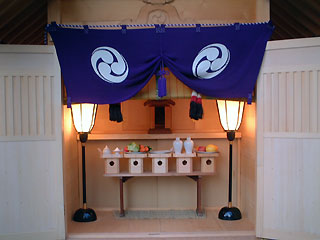 If you've been counting your way through this essay, then you know we're up to the last god on our pilgrimage. He is Ebisu--the same name as the Yamanote line station. Ebisu guards over occupations and is also a deity of rice paddies and fishing. He's easy to spot because he carries a fish and instead of a staff, he's got a fishing pole. For a god of careers, he's got a surprising leisure theme going on. At least in this day and age...
If you've been counting your way through this essay, then you know we're up to the last god on our pilgrimage. He is Ebisu--the same name as the Yamanote line station. Ebisu guards over occupations and is also a deity of rice paddies and fishing. He's easy to spot because he carries a fish and instead of a staff, he's got a fishing pole. For a god of careers, he's got a surprising leisure theme going on. At least in this day and age...
We actually took a wrong turn on the way there, despite the banners and our map, and ended up at the Buddhist temple next door to Ebisu's shrine. We were distracted by the festival at the temple--rows of brightly colored stalls selling food and games--and completely missed the signs across the street saying "Ebisu this way."
But we went into a temple that was lovely and very rich and that's where we got our all-purpose shichifukujin omikuji. Mine came with a Fukurokuju charm, as I mentioned. Tod's charm was Jurojin and his omikuji was han kichi. But there was no shrine to Ebisu in sight, so I consulted the map and realised my error. We walked back through the festival, I played a game of spinning darts and we crossed the street to our final destination.
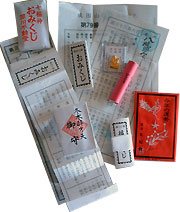 Ebisu's shrine is newly rebuilt. We were reaching the end of the worshipping day (temples and shrines close at 5 pm) and not so many other people were around so I got a nice clear picture of it. Where Benten's shrine was cluttered with all sorts of decorations, Ebisu's was spare and tidy. Extremely calming.
Ebisu's shrine is newly rebuilt. We were reaching the end of the worshipping day (temples and shrines close at 5 pm) and not so many other people were around so I got a nice clear picture of it. Where Benten's shrine was cluttered with all sorts of decorations, Ebisu's was spare and tidy. Extremely calming.
I finally got a dai kichi omikuji so I am looking forward to a very lucky year in my work. Tod's was only small luck.
In addition to our omikuji, we bought birthday fortunes in bright red packets. These are horoscopes and they're really long, so I've only read a little bit of mine. As these things always do, the profile part says I'm a bossy leader who thinks only of herself. So true. The other part, my horoscope for the year, is divided into four sections (wishes, relationship, money and career) but I can't read enough of it without the dictionary at hand.
So if you've been keeping track, it looks like I'm in for a pretty steady middle luck year but Tod's going to have a wild ride with big luck in some areas and little luck in others. Neitherof us got any kyou (misfortune) omikuji. Whew.
Have you ever wondered what it's like to shop in a bustling, old-fashioned Tokyo shopping district?
The Shimaura Discount Chocolate Shop webpage will give you a taste (including a very loud WAV file) of what it's like to stand in front of their stall in the alleys of Ameyoko near Ueno station.
Frenetic showmen, they work as a team--one man on a platform, surrounded by candy, takes handsful of chocolate bars, boxed candies and seasonal treats and holds them aloft then thrusts them into a plastic bag held up overhead by his assistant on teh ground. 4000 yen's worth of candy for only 1000 yen! Not a bad deal. It's chocolate that's almost reach it's sell-by date or overruns of special promotions.
They've been featured on TV and in print and for good reason. They not only give you candy, they give you a performance, too.
We stumbled across Shimaura a few years ago at the New Year and visited it again this week. You might like to see it for yourself if you're in town, or virtually if you're not.
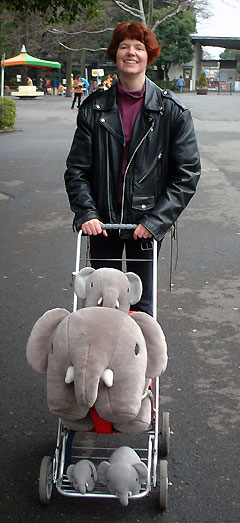 "This is an art project; we are not taking our stuffed animals on an outing to the zoo," Tod & I agreed as we left our building with the Zous in hand.
"This is an art project; we are not taking our stuffed animals on an outing to the zoo," Tod & I agreed as we left our building with the Zous in hand.
It really did feel like performance art.
It's pretty amazing the reactions you get with a stroller full of stuffed elephants. Adults were generally enchanted. They smiled and pointed. "Kawaiiiiii!" Older men and women were more likely to talk to us. Security guards cracked smiles. Middle-aged matrons laughed aloud. The whisper of a trendy young woman to her friends got them all to turn their heads subtly to peek. Mothers with children sometimes saw us before the kids did, and directed their kids to look. One very brave, stylishly dressed college boy petted Zousama even though his girlfriend disapproved.
Little kids had mixed reactions. Some were a little scared and clutched at their parents' legs; some warmed up to the idea after a few seconds and snuck another look and a smile. Others came toddling over to play with the Zous right away. Sometimes the Zous were a more interesting attraction than the animals in the cages.
Some people saw the Zous, but not us, then glanced up to see who was holding the stroller. Whether they stopped smiling because we were watching them watch us, or because we were foreigners and they were surprised by that, I don't know.
Tod estimated that the bemused to amused ratio was about 30:70.
The Zous have their own version of the day at the zoo on their blog and in pictures.
Leafing through "Trendy" magazine yesterday, I was fascinated by a long article titeld New Stype of Shopping. It featured (and compared) all the recently opened shopping theme parks around Japan.
Japan doesn't have too many American-style shopping malls. There's not much room in the cities for fields of parking lots surrounding a low, broad building full of shops and anchored by a big-name store or grocery. There are a few of these, but they tend to be out in the further suburbs. This is in contrast with American cities; Chicago has numerous shopping mall complexes in the urban centers.
What we have here are more like Chicago's Water Tower Place or Pittburgh's Fifth Avenue Place, a collection of stores stacked up on many floors of a single office-tower sized building.
I mentioned the Marunouchi Building the other day. Nicknamed Maru Biru, it sits just across the street outside Tokyo Station on the site of Japan's first skyscraper (which was also called the Marunouchi Building). It's got two floors dedicated to restaurants which are booked out months in advance. There are shops of all types on 6 floors, offering everythign from clothing to an Xbox gaming parlour. There are distintively high-end chain retailers and a few boutiques. The architecture is amazing--even jaded Tokyoites stand in the atrium and stare up at the glass elevators and exposed beamwork.
Newly opened this month is Caretta Shiodome. It's another skyscraping shopping mall whose tagline is "Enjoy the taste of lesiure." With "sky restaurants" on the 46th and 47th floors, a theatre and restaurants on the lower floors, and a shopping concourse in the basement floors, they may be giving Maru Biru a run for its money. I haven't been there yet but will put it on my To Do list.
There are so many similar shopping places: Takashimaya Times Square, Sunshine City, several new complexes along the Yokohama waterfront. I think the "Trendy" article got it right--these shopping plazas and others like them are theme parks.
What amazes me is that Japan is still in a recession. How can these very upscale locations survive? Maybe they pander to the good old days of the Bubble when everyone had more money than they could spend. Back then regular people could afford to splash out on fancy food, designer handbags and clothes with labels. Perhaps the last few years of less money, uncertain job prospects and making do with two-year old toasters has finally got everyone ready to backlash. I suppose if consumers are spending money in places like Maru Biru and Caretta Shiodome, then the economic outlook will improve...for the importers and brand name retailers, anyway.
MJ mailed me these snapshots as she took them with her cell phone.
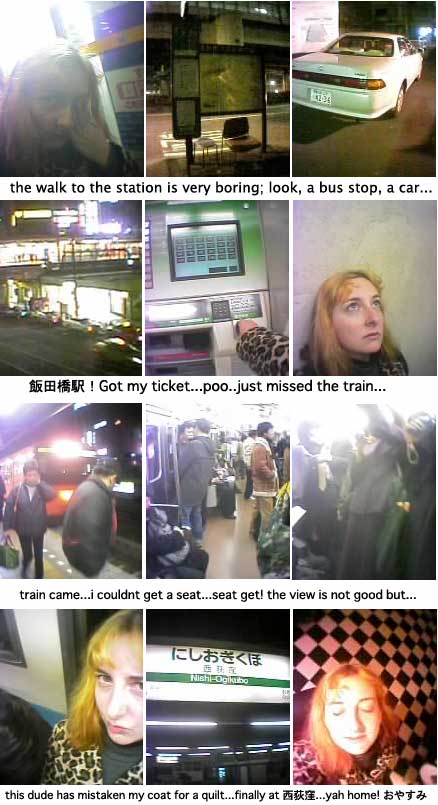

This is a wall with a boarded up entrance to something.
The mysterious wall is about 20 meters away and at an angle to the support wall of the Korakuen (Marunouchi line) train station off the image to the left. It seems to be a retaining wall for the park above, but what's inside the arch? There are stairs leading down the hillside from the park to the now-weedy area that was once a garden, judging from the plants running wild down there.
My best guess about this is that before Tokyo Dome was built in 1988, back when this area had a different stadium dating from 1952, this was part of that complex. Maybe it was the entrance to the Baseball Hall of Fame, or a pedestrian walkway from somewhere... but the Marunouchi line opened in 1959 and the train station would have been in the way then, too, woudn't it?
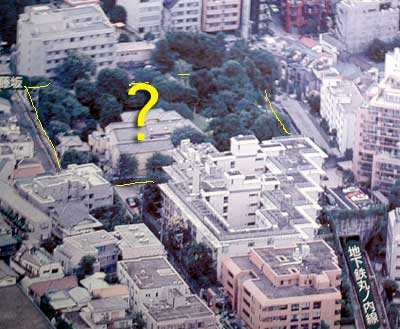 We found this arial view of our neighborhood on a flyer promoting an apartment building currently under construction.
We found this arial view of our neighborhood on a flyer promoting an apartment building currently under construction.
That's our building, the orangish one in the lower right hand corner. 5 floors with 4 or 5 apartments per floor. Not a huge place, but not small, either.
The building marked with a big yellow question mark, surrounded by its own forested park, is a mystery. It seems way too big to be a private house but there is no sign outside except for a family name on a single mail drop in the wall.
Although there's a big entrance gate, we never see any traffic going in or out. Once in a while there is a car parked on the horseshoe drive. Maybe someday when I'm feeling extra brave, I'll stride up and knock on the door to find out what's up there.
No matter where in the world you live, it's a good feeling to be become 'regulars' at a favorite restaruant.
Our restaurant is Ampresso, an Italian place with fabulous food only 5 minutes' walk from our house. When I walked in last night, the staff commented on the haircut.
If that weren't enough to assure me that we are valued customers, Satoru Ito, the owner and head chef, shared his recipe for a delicious sauce that goes with tuna carpaccio. He drew it in pictures with English and Japanese captions then explained it all to us step-by-step. Plus he gave us a litre of the special soy sauce from Kyushu we'll need to make the sauce. I guess we'll be making a lot of tuna carpaccio!
After dinner, Ito-san treated us to cake and coffee. Could you ask for anything better? What a nice guy!
Ito-san, who loves to fish and lived in Italy for a while, has a website. It's mainly in Japanese but there are lots of pictures and some of his Ampresso recipes.
This morning, I spent some time typing up tour itinerary ideas for a visiting acquaintance. This is the third time I've done this in the last few months, so I figured I'd use today's write-up as the basis for a web page. There are so many other ideas, that it's taking me longer to put together than I expected. But I will have a list of my favorite spots to vist online soon.
But I did re-discover a nice resource on Tokyo's Metropolitan Parks that I'd lost track of a while back.
It's a long holiday weekend here. Yesterday, I stayed away from the computer for most of the day.
Tod & I went to Ikebukuro to check out the Gyoza Stadium, a pot-sticker theme park operated by game giant Namco. For 3,500 yen you get all-day, all-you-can eat gyoza in a dozen different styles from around Japan. Unfrotunately, the wait was 2 hours to get in, so we opted to eat elsewhere. We'll go on a less crowded day.
We also sought new rings. In addition to our wedding rings, we wear matching bands to seal our friendship. These have varied over the years because they are usuallly inexpensive bits of stone or pressed silver that Tod somehow breaks. A couple of weeks back he snapped the silver one we've worn for the last few years. I don't feel right wearing one if he isn't and my hand felt bare so now we're sporting simple milled silver rings that we found in a tiny litle shop near the movie theatre where we went to watch Star Wars Episode 2 (at long last).
On the way home we did the unthinkable. After stopping at a convenience store for our dinner, we nibbled chicken nuggets and drank beer as we walked home. How naughty!
Who knows what's we'll get up to today? Putting on makeup on the subway? Littering? No doubt we'll be up to no good now that we've broken the taboo of eating while walking.
I literally dragged Tod out of bed this afternoon at 1 (he's quite heavy!), got him into the shower and out of the house by 2. We went to Yokohama.
So much has changed since the last time we trekked down there. Before there was lots of construction around Sakuragicho station but MInato Mirai 21, the harbor area, is all built now with bridges and walkways connecting shopping/restaurant/entertainment areas. We cruised Landmark Plaza on several small shopping missions and only ended up with a few things we didn't expect--mainly books, which can never truly be considered an unexpected purchase.
Our main goal was to go to Chinatown for dinner. Although we were tuckered out from being in the shopping center. we summoned the energy to walk the 2 kilometers to Chinatown. It was worth it. At Tung Fat, we feasted on dim sum, char siu and chahan washed down with jasmine tea. Afterwards we picked up some Chinese sweets then headed home. The sweets and my new book await, so I'll cut this short...
 When I desperately want to get out of this hot, humid city I seem to choose the time it's most difficult to do so.
When I desperately want to get out of this hot, humid city I seem to choose the time it's most difficult to do so.
August is holiday month. And many (most!) Japanese take a summer holiday this month. Consequently all the trains are booked up and planes cost twice as much as usual. It's maddening for spur-of-the-moment travellers.
I want to go to Onomichi, a beautiful little town on the northern shore of the Seto Inland Sea. I was there for a just one day a few years back and it captured my heart. It is my very favorite city in Japan: quiet, lovely, & friendly. I've been wanting to return for a long time.
I'm not sure how I can make this work. It might come down to buying two $500 round trip plane tickets (plus a bus and a train), or maybe two $350 Shinkansen tickets. Seems rather extravagant for a one-day trip, though. Maybe we'll just go to Saitama, instead. Train fare's $10 and there's a nice onsen only an hour away.
Yakatabune! Dining on Tokyo Bay.



Floating parties on ships like these are a summer tradition dating back centuries. Poetry readings and courtly music have been replaced by karaoke, but the spirit is the same. It was fun to dress up in yukata.
Tokyo has a lot of hills with names.
Streets generally don't have names, but the hills do: Andozaka, Tomisaka, Dangozaka. A few of them are well-known for their neighborhoods or train stations--Kagurazaka, Nogizaka, Akasaka--and there are plenty that loan their names to busy intersections, but many are only etched onto historical signs dotting the local landscape. Who ever heard to Shichimencho-saka? Just the few people who've stopped to read the marker.
Some are named after notable Tokyo citizens; some names come from historical activities or local fauna. But it doesn't explain why hills have names and status, yet streets do not.
 The Marunouchi line is a subway, but it peeks above ground several times along its route. Here is a view of the track between Ochanomizu and Awajicho where the train crosses a bridge over the Kanda River.
The Marunouchi line is a subway, but it peeks above ground several times along its route. Here is a view of the track between Ochanomizu and Awajicho where the train crosses a bridge over the Kanda River.
I love this tiny section of track. It takes about five seconds to traverse it, but the view is beautiful and on a sunny day, the sudden switch from darkness to light and back again is refreshing.
 23:56 on the way home from a meeting and dinner.
23:56 on the way home from a meeting and dinner.
Kasuga Dori, the main street through our section of town, is lined with glowing red cones. They have been doing improvements to the undergrown conduits for over two years.
The end is in sight. Last night, they were snaking pedestrian traffic through corridors of cones and barriers so that the workers could lay bricks into the sidewalk. When they are finished and the trees are replanted, the area will be transformed.
But it looks so pretty at night. I think I'll miss it.

This traditional gate belongs to a private house on my street. It's usually closed but I caught it open yesterday afternoon. What a lovely landscape inside.
From the street, it's pretty unremarkable, just another Sapporo Lion beer hall with a display of plastic food in a big, modern building.
But stepping inside this place was a surprise. This beer hall was designed and built by Eizou Sugawara in 1934. It's gorgeous. It's an art deco cavern. At the far end, a tall bar made of German marble and flanked by five foot tall planters (no plants anymore, but the historic photos showed them brimming with foliage) is the hub of action. On the wall behind the bar a mosiaic of glass tiles depcits half-nude women harvesting wheat. Grapes hang above them and in the distance is a brewhouse.
The ceiling of the room is stone. Once white, it's been aged to a patchy, nicotine brown. But the discoloration doesn't diminish its beauty. The stone weeps in intricate layers of angular forms downwards, forming pointed archways and capping the green-tiled columns that support the ceiling.
The walls are covered in brown tile, with large glass mosaic still lifes between each column. It was apparently extremely challenging work to create the glass and the art; the restaurant's own description said it was done through trial and error. The experiment was successful--the mosaics are charming.
The lighting is delightful. Two rows of large, frosted glass globes etched with overlapping circles run down the center of the room. Attached to the angled part of each column, just above where the stone meets the tile, is a light fixture of extreme beauty. Six frosted glass globes--some white, others pale blue, rose or green--hang from a wooden armature that looks like a double cross. The hanging pieces are made of wooden cubes and plum-sized colored glass beads. It's a shining example of Arts & Crafts style.
The floors are tiled in blocks of colors that look like throw rugs. Pale green, bright blue, brick red, black and white dominate and all are pockmarcked and cracked. But considering that this building rode out the war and numerous earthquakes, a cracked floor is almost expected.
I'm kicking myself for not having my camera with me.
Ack! It's 11:45 in the morning and haven't blogged yet today. I've been caught up in writing an article and answering e-mail. Now I have to leave to go wave a dead chicken at MJ's computer so forgive me if all I give you today is a photo series. This is Denzuin, an old and famous temple near our house where Tokugawa Iseyasu is entombed.



 In a tiny alley bordering Kausuga 2-20, is the White Snow restaurant. The noren was out as we walked past at lunchtime yesterday, so we slid open the wooden door, ducked under the curtain and tried our luck. What a delight.
In a tiny alley bordering Kausuga 2-20, is the White Snow restaurant. The noren was out as we walked past at lunchtime yesterday, so we slid open the wooden door, ducked under the curtain and tried our luck. What a delight.
It's a classic place that could be 50 years old, or five. An L-shaped dining bar surrounds the tiny kitchen which is screened from view by a cabinet full of dishes and foods. Handwritten paper strips hang over the bar; each one bears a different menu item and price. Bottles of soy and other sauces, little jars of toothpicks, and napkins stand evenly spaced along the upper edge of the counter.
To the left of the counter, several low tables rest on a tatami dias under two paper-shaded windows. The room is dim and comfortable. And although White Snow's deserted on this Saturday afternon, we know they do a steady trade in the evenings--there are two dozen "keep bottles" on the shelves, mainly sake and a few whiskey, each with a date and its owners name written in indelible marker on the bottle.
 At the end of the counter where we sat is the altar of popular cuture. A television rests loudly on a high shelf where most patrons can keep up with the televised national obessesions of food shows (daytime) and baseball (evening). It broadcast a "wide" show of talk and variety while we ate. Below the TV are several shelves of knicknacks, books and magazines. And who is making an offering at this altar? It's Happy, the ever-cheerful dwarf of legend. He's got a bucket of red silk roses in his arms and looks thrilled to offer them to the gods of media.
At the end of the counter where we sat is the altar of popular cuture. A television rests loudly on a high shelf where most patrons can keep up with the televised national obessesions of food shows (daytime) and baseball (evening). It broadcast a "wide" show of talk and variety while we ate. Below the TV are several shelves of knicknacks, books and magazines. And who is making an offering at this altar? It's Happy, the ever-cheerful dwarf of legend. He's got a bucket of red silk roses in his arms and looks thrilled to offer them to the gods of media.
Speaking of the gods of media, if you haven't read Neil Gaiman's American Gods, I urge you to try it. It's a dark, funny, and thought-provoking story of old vs new. A book certainly worth your time.
The view from the top of the Bunkyo Civic Center is really beautiful. It's the highest building around and has a semicircular viewing lounge and restaurant on the 25th floor. We dined there last night and got a bird's eye view of our neighborhood and the metropolis.
To the west, the Shinjuku skyscrapers huddled together like very tall sheep, herded by the brilliant neon of the sleezy Kabukicho nightclubs. To the north, a vast, seemingly infinite expanse of low residential neighborhoods twinkled. The huge Ferris wheel at Odaiba peeked out between the business district skyscrapers in Otemachi and at 8:30 we watched the fireworks from Tokyo Disneyland, way off in Chiba.
We also spied another "tall restaurant" and made plans to thread our way through the city, eating in upper floor restaurants we can see from the one we're currently in. We have some spectacular views in store for us.
 Another entry in the Buildings with Strange Names series, Random Koishikawa houses a hardware store in the basement, a doctor on the first floor and offices on the upper floors. En Es Tee has offices on 2 and 4 but different company with a very long name in kanji (another sign for them reads "Human and Nature") is sandwiched in on 3.
Another entry in the Buildings with Strange Names series, Random Koishikawa houses a hardware store in the basement, a doctor on the first floor and offices on the upper floors. En Es Tee has offices on 2 and 4 but different company with a very long name in kanji (another sign for them reads "Human and Nature") is sandwiched in on 3.
Most buildings in Koishikawa are similar in their size and tenancy and even the distribution isn't too unusual. Once again, I'm left wondering why they selected this name.
Tokyo Transportation Series
Oedo subway. 11:56 pm.
"Hey, come quick. There's a man walking on the power lines outside the window," Tara urged from the office.
Sure enough, there he was. He and his companion were dressed in the uniforms of the electric company and were walking along the power lines, inexplicably unbundling the wires that were spiralled together.
Tara stuck her head out the window for a photo op. The lineman looked up, smiled and held his hand up in the V for victory gesture thatis commonly used for photos here. His coworker, standing closer to the utility pole, laughed.
At 4:00 am, Tokyo is very quiet.
The hum of my computers drowns out the distant sounds of sparse traffic. Birds are asleep; school children are asleep. The construction sites all around me are still.
The sun is waiting in the wings for his cue to come onstage. The sky is inky; streetlights dot the roads with circles of blue white light.
And I am up writing and working in this cool, quiet morning. Soon enough, the trash trucks will cruise by, commuters will parade past the house on their way to the station, and the world will wake up. But I'll have several hours of work tucked in under my belt. Maybe I can take a nap this afternoon.
Ah, home.
The familiar sounds and smells of Tokyo welcomed me back home this evening. The musical train announcements, the sound of bicycles swerving to avoid pedestrians, the scents of oden and ramen wafting over the smell of car exhaust.
It's good to be home.
Finding the trash collection point in our new neighborhood was an adventure.
Shimizu-san, a neighbor, paid a call on me yesterday afternoon to welcome me to the neighborhood. Or maybe she was a spy for her friend, Matsuino-san, who used to live here.
But I put her to the test when I asked if she knew where I should put my trash.
First she looked around the street for the city's color-coded trash sign. I could have told her she would not find one.
As we stood in the middle of the street, discussing the options, a woman preparing to mount her bicycle spoke to us. She suggested that the utility pole near our garage was an acceptable place. But it has no sign and Shimizu-san was doubtful.
So were were off to the mansion up the hill. Shimizu-san was sure there was a trash point there. But was it where Matsuino-san had put her trash? We asked the caretaker of the building.
"Do you speak Japanese?" he asked me right off. His wife, in the background, encouraged him with a hearty "Gambatte!" when I explained I spoke a little but was studying and getting better.
The trash collection point at the mansion is ours to use, but we must put our burnable trash out precisely on time at 8:30 in the morning on Monday and Thursdays. Too early make the neighborhood ugly. Recyclables are on Wednesdays and landfill day is Saturday.
I owe a debt to Shimizu-san for helping me find out what I needed. She lives "over there" up the hill. I hope I'll see her again soon.
Our new neighborhood is a symphony of workday sounds.
Along the street there are two construction sites, one at the front of the house and one across from my office window. I think the workmen may be trying for a gold medal in Syncopated Hammering.
Opposite the front door is a small printing company. The whirring and clunking of the press is nearly drowned out by the noise from the dump trucks hauling dirt away from yet another construction site over the hill.
I've been assured that the construction will end in December. I can only hope that they aren't building a jet engine laboratory!
The weather is cooling, finally. For the last two days I've had the aircon off and all the windows open. We get a nice breeze through the house and the fresh air enhances the grassy scent of our tatami floors.
But I'd forgotten how noisy our street is--particularly at 5 am when delivery trucks start making their rounds. With the bedroom window open, I could hear every truck, all the scooters, the paperboy. But the chilly draught from the window was so comfortable. I snuggled into the covers for another ten minutes' snooze...
You cannot live in Tokyo without a map.
Tokyo addresses are organized in descending order by To, Ku, neighborhood, Chome, block and finally building number. For example, here is the address of the Diet:
Tokyo-to
Chiyoda-ku, Nagatacho 1-7-1
If you have an address and a map, you can find any place in the city. If you have an address and a vague idea where your destination is, you may find yourself wandering for hours.
When someone invites you to her house, she either gives you a map or offer to meet you at the station. When you go out to dinner with a group from work, you get a map to the restaurant. Maps are even printed on store flyers and business cards!
The Tokyo Regional Immigration Office is a hulking concrete building designed to intimidate people. The entrance underneath a long, shadowy portico sets the tone for what's inside.
Colored stripes on the floor help to herd immigrants to the proper room for their application type. We followed the pink strip to Number 6: Business Visas. The room is cheerless. Concrete walls are painted white and decorated with sample applications and warning notices. Rows of brown leatherette chairs face a TV bolted to the ceiling. Windows behind the counter look out onto the roof of the next building. The air is filled with the sound of the "take a number" machine and quiet conversations among the applicants.
The room is full of fear, too. Some of the immigrants are concerned about their visas--will they be accepted or will they be tossed out of Japan on the next plane. It happens. Most people waiting in the Room 6: Business Visas are bored, resigned, or impatient but the tension of it all gets to you, even when you have no cause to worry about your visa application.
Fortunately our wait was relatively short and our tension dissolved when we were handed new, three year visas. Not only are we allowed to stay here until October 2003, but we won't have to visit the immigration office again!
Tsukiji is the wholesale market for fish. It's a great place to go for sushi. You can't get fish much fresher than at the market that supplies the city's restaurants!
We had lunch at Kura Maguro a kaiten zushi restaurant in Tsukiji that serves mainly tuna (called maguro in Japanese). Yum!
At a kaiten zushi shop, the sushi chef stands in the middle of a work island, surrounded by his ingredients. He assembles the sushi, sits it on a saucer-sized plate, then puts the plate on a conveyor belt that rings the island. Customers sit on the other side of the conveyor belt and pluck off the plates that interest them.
When you've eaten your fill, a waitress comes over and counts your stack of dishes. They are color coded according to price. At Kura Maguro, the sushi ranged from 100 yen green plates (cucumber rolls) to 600 yen golden plates (ground raw tuna topping a roll of rice and nori).
Kura Maguro's selection is limited to tuna prepared five different ways, egg custard, cucumber rolls and sweet shrimp. The limited selection made choosing easy and since maguro is one of my favorite sushi fish ("Easy on the palate," a friend commented), I was content.
Can hardly wait to return.
On Wednesday morning, we lived across the street from the Bunmeido Book Store. By Wednesday night, we didn't.
A few weeks back, workmen started picking apart the building. First all the bricks around the bottom floor disappeared, then big hydraulic jacks were put in place to shore up the walls. I guessed they were either raising the building to add another story or installing an earthquake safety system.
But on Wednesday night when we arrived home after Japanese class and pizza, the building was gone! Vanished. The interior tile floor was still there, but nothing else. Not even any rubble.
How mysterious. I was in my office at home all day and never heard or saw a thing. How can you silently demolish a building?
On Thursday night, Tod came home from work and called me to the front door. "You're not going to belive this," he said."Look out there...they moved Bunmeido!"
Sure enough, there it stands on the end of a patch of vacant lots two doors down from where it was on Wednesday morning. Astonishing.
"Crazy proprietor?!?" was Brendan's greeting to us as he cracked open two Red Hooks and handed us a menu at Pizzakaya last night.
Brendan, the refined and dignified proprietor of our favorite Tokyo pizza establishment, had read my Gallery Show entry on this website. I did indeed refer to his as "the crazy proprietor." But I meant it in the nicest way...
We have dinner at Pizzakaya every Wednesday after our Japanese lesson. The California-style pizza helps to wash away the memories of verb conjugations. Perhaps that's why my Japanese does not improve.
Brendan, if you're reading this, next week we're going for soba after class. :-)
We've been househunting for two and a half months, since the fateful day in June when our landlord told us he had to sell the house we live in now. I've looked at scores of floorplans and visited about two dozen house in person.
We've finally found one to move to. The funny thing is, neither Tod nor I really likes it. It's brand new. It's smaller than our current place. It has no garden, no deck, no outdoor space. Not much character. We'll no longer have a shared office room. Networking this house is going to be a challenge. There aren't many electrical outlets.
But it has a two advantages. It's about three blocks from where we live now, around the corner from the sento, so we'll be in the same neighborhood. And the bigger advantage: taking this place means that I don't have to keep looking, which is a gigantic relief.
So why do I feel slightly sick about this decision?
Knock, Knock.
Who's there?
Our next-door neighbor.
Our next-door neighbor who?
Alan. He's Canadian.
I kid you not. The man who lives on the 2nd floor of the house next door is from Canada. This comes as a bit of a shock, I will say. In six months here, we've never seen him even once.
He came to see us last night while we were sitting out on the deck. He had just read my name on a post to a local mailing list, put two and two together, and even read these web pages. When he saw the page for the Marble House, he knew who we were. So he came down to say hello.
So we have a new neighbor--or rather an old one. Alan's lived here for 13 years! Very, very quietly...
The Kanda River is not a big river nor is it terribly important as rivers go. But it is the closest river to home and last night when I wanted to see some water (other than in the bathtub), that's where I headed.
Tokyo, being on a bay as it is, has an astounding number of waterways wending their way towards the ocean. Over the years as the city grew, many of them were redirected, diverted or otherwise tamed with human intervention. Today Tokyo is crisscrossed with a network of walled-in streams, creeks and rivers.
Where the expressway turns south toward the city, the river continues east. A tributary, so completely subdued that it looks like the exit of a parking garage, empties into the river.
I wonder if Tokyo uncovered all its rivers whether people would start taking boats to work, like in Bangkok and Venice?
"I wonder if they recognise us?" Tod wondered about the clerks at our local 7-11.
Of course they do, we go in there every night and buy the same thing. Two cups of Kudamono Daisuki. We call it Frozen Fruits.
Kudamono Daisuki means "I love fruit" and it is a wonderful dessert made of slices of apple and orange plus whole strawberries. Each bit of frozen fruit is coated in a millimeter of fruit ice. It's just the thing for a hot summer evening.
So this season, when we ask one another "do you want dessert?" it invariably means Frozen Fruits and a trip to the 7-11. Of course the clerks recognise us!
"Let's have dinner al fresco. We can sit outside at T.Y. Harbor," I suggested.
So as the sun cast a fuschia lining on a grey cloud, we sat at the intersection of the Tennozu & Takahama Canals, sipping freshly brewed microbeer and nibbling California cuisine.
We watched the sun set; the sky shaded into deep indigo and an orange crescent moon rose over the bridge. On the canals, low barges lit with paper lanterns cruised past with cargoes of revellers.
Starlings circled a nearby apartment complex, tight whorls of lightning fast flight, before settling in a tree and raising a din. We were far enough removed to enjoy the chirping, but the tenants of the apartments were turning up their TVs.
When dark became profound, we found our way to a nearby train station. The route was new to us, but a steady stream of people, like ants following their trail home, flowed over bridges, through intersections, into office buildings, up escalators and finally through a long, covered walkway that passed over construction sites and around buildings to end at the station.
Over the past few days, we seem to have entered siren season. There have been an excessive number of screaming sirens rushing past our house.
It started on Thursday when a cavalry of fire trucks flew past, decelerated and parked themselves across the street from Ban Ban Bazaar, a dry goods shop a block down the road. With the good timing that comes of procrastination, I had some dry goods on my shopping list, so I went out to buy them and to spectate with the crowd of neighbors. No idea what was going on, though. There was no smoke, no fire; I couldn't even tell which building the firemen were interested in. They were milling around as aimlessly as the onlookers.
Later that afternoon and every day since at least one each of police, ambulance and fire trucks have rifled past at top speed and top volume. Sirens aren't enough in Japan, the drivers also have a loudspeaker system that they use to continuously ask the drivers and pedestrians to move out of the way. It's always very polite, of course, when you can understand the rapid, overamplified speech.
Another day, another realtor
The day before yesterday, I got an unexpected phone call from Yoshii-san at Relocation House who had faxed me a floorplan a couple of weeks ago. I had made an inquiry about a house through one of the realty databases on the Internet and now Yoshii-san was following up to see if I was interested in seeing the place. I couldn't recall exactly which plan it was, and I couldn't quickly lay my hands on it (the pile of faxes on my desk is about three centimeters deep). It was easier to arrange an appointment with him than to try to explain my predicament. Goodness knows I've seen plenty of bad houses; if this was among them, it wouldn't matter.
Luckily for me, it wasn't bad at all. In fact, this out-of-the-blue place turned out to be surprisingly nice. It has reached the top of my list, in fact. Admittedly, that's not saying much, but this place was good. It had a nice blend of Western and Japanese tastes, it was large enough, bright and sunny. It isn't quite as excellent as the current house, but I could live there happily enough.
There are a few more places to visit in the next week or so. After that, I'm hoping that I will be able to make a decision and get this move out of the way.
Yesterday I spent 4 monosyllabic hours in a car with my realtor.
Perhaps that is a slight exaggeration; I do know a words of more than one syllable which I proved by repeating them. hiroi...akarui...kitanai...semai...
We visited five places yesterday. One won't be vacated until the end of July, so we just peeked at the outside. Of the other four, none really lit my fire. They were all OK in their way and horribly ordinary.
I like extraordinary living spaces. I also like places that are old and a little bit run-down. Already broken in. Buildings with character.
I videoed each place, to help me remember what each was like. After one or two showings, it gets hard to remember details. Which one had the chartruese bathroom? One of them had a dishwasher, right? Was there a phone jack in the bedroom? Tod viewed the tape and concurred--there's no match for us here.
So it's back to the drawing board--again. I will search at i-Size and at Chintai to see if there is anything new on the market. But I think the places I would like will come to me through word of mouth or serendipity, not from an Internet search engine.
If there's a Housing Fairy, I hope she leaves me a key under my pillow tonight.
